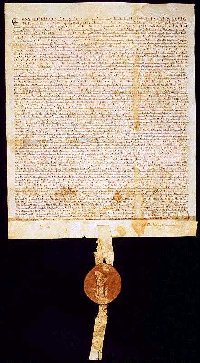 The Great Charter
The Great Charter
Quick links on this page
Mabilla of Bury 1230
Franciscans- Friars Lane 1238
Franciscans in danger 1257
Guild of Youth riots 1264
Abbey gets Haberden 1281
Town gets Alderman 1292
Shire Court moves North 1301
The Great Famine 1315
Abbey Gate destroyed 1327
The Black Death 1348
The Peasants Revolt 1381
St Mary's Tower 1400
John of Lydgate 1420
Duke of Gloucester dies 1447
Great abbey fire 1465
Feoffees' beginnings 1472
Rushbrooke Hall started 1500
Martin Luther's Protests 1517
Henry VIII Head of Church 1535
Foot of Page 1539
|
The
Middle Ages
St Edmundsbury From
1216 to 1539
Pre
1216
|
Please click here to look back at events in and prior to 1216.
|
|
1216
|
After the traumatic events of King John's reign, his son Henry III came to the throne in October at the age of nine. The Civil War which followed John's renunciation of his Magna Carta ended as the barons rallied to Henry. As he was under age his throne was administered by a group of Barons led by William Marshal, Earl of Pembroke and Hubert de Burgh, as well as Archbishop Langton. They enhanced the role of the Great Council and adopted Magna Carta principles, re-issuing it in November 1216 with 42 clauses.
The French, however, were still in the country, and determined to take over under Prince Louis, who had declared himself king.
The year 1216 is sometimes taken to be the end of the Anglo-Norman, or Early Medieval period, and the start of the Middle Ages. The Middle Ages can be reckoned to last until 1348, when the era becomes known as Late Medieval, 1348-1485. The story of Suffolk in the thirteenth century was to be one of growth and prosperity.
|
|
1217
|
Magna Carta, or The Great Charter was again modified and reissued along with a Charter of the Forest. Roger of Wendover mistakenly attributed this version to King John and 1215.
Orford Castle was surrendered to Prince Louis of France, who had launched an expedition into England, and attacked several towns around the south east. There is no record of him attacking Bury St Edmunds, but it has been suggested that he did come to Bury, and made off with the relics of St Edmund, returning to France with his remains. This is the thesis of Father Houghton's book on St Edmund, but this event has no evidence to support it in records of the abbey.
The Bury Chronicle recorded that many Frenchmen were killed in the battle at Lincoln on 19th June. Also that on 24th August the French fleet arriving in the Thames estuary to help Louis were sunk. Louis returned to France and about 8th September, "the great gift of peace was granted once more after two and a half years war".
Robert of Graveley had been the Sacrist of St Edmund's since the demise of William of Diss. Late in 1217 he was elected to the post of Abbot of Thorney. Robert was recorded in the 1270s Gesta Sacristarium as as efficient and active Sacrist. He had bought the Abbey's Vineyard and enclosed it with stone walls for the "comfort of the infirm and those who had been bled." This area is still known as the Vinefields in the present day. He also provided new rafters for the abbey roof, and placed a decorated canopy over the shrine of St Edmund. The account of the election of the Abbot Hugh called "Electio Hugonis", may well have been written a year or two after Robert left Bury, for it is heavily biassed against him. Robert had been the chief contender with Hugh for the post of Abbot during the election of 1213.
|
|
1219
|
A great school of history was established at St Albans when Roger of Wendover began his History of the World. His account of the struggle of the Barons with King John is the only known account of the involvement of Bury St Edmunds in the story.
|
|
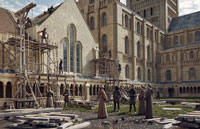
Chapter House c1220 visualisation
|
|
1220
|
This visualisation of the building of the Chapter House at St Edmund's Abbey in about 1220 was made by Bob Marshall, now a digital illustrator at English Heritage.
|
|
1225
|
Henry III issued his final version of Magna Carta and its main principles remain in law today, and were only slightly amended in 1297. This is the final version which has become so important today, with only minor changes in 1297. It still stands in the law books today as Chapter 25, Edward I. When Henry III came of age he tried to regain control from the Great Council but he was regarded as extravagant and somewhat incompetent.
The Bury Chronicle notes that the Order of the Friars minor (Franciscans) and the Order of the Preaching Friars (Dominicans) established themselves for the first time in England. These orders would come to be a challenge to the established monastic orders in future years, both in their spiritual authority and in their claims to the moral leadership of the people.
|
|
1226
|
The Bishop of Ely obtained a charter to set up a market on the major road from Bury to Ipswich in the corner of his manor of Barking. He created Needham Market as a settlement around it. Unlike Lakenheath in 1201, this market was safely outside the Liberty of St Edmund.
|
|
1227
|
In 1227 King Henry III confirmed a charter to Richard Argentein for a fair to be held in his manor of Newmarket for three days every year in September. This has been taken to be the origin of Newmarket as a town, but it seems likely that a market had grown up in this location some years before this date. It was in a corner of the vill of Exning, but situated conveniently to serve travellers on the old Icknield Way. Although the Icknield Way was probably a series of tracks, these had to converge with the Norwich and Bury roads at this location to pass conveniently through the Devil's Dyke earthwork, lying to the south west of the settlement.
|
|
1229
|
Hugh de Northwold, abbot at Bury was consecrated Bishop of Ely. His place as abbot was taken by Richard de Insula, the abbot at Burton. He ruled from 1229 to 1233.
|
|
1230
|
King Henry III crossed into Brittany with an army.
|
|
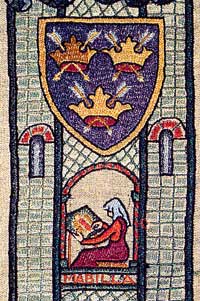
Mabilla by Sybil Andrews
|
|
1231
|
At some period in the early thirteenth century, Mabel of Bury St Edmunds became one of the most famous needlewomen in Europe. Little is known about Mabilla or Mabel of Bury St Edmunds except that her work is referred to by name in the Royal Wardrobe accounts of the court of Henry III. We believe that the type of needlework for which she was famous was called Opus Anglicanum or English work. It was used for ecclesiastical vestments, altar frontals and other ceremonial purposes and was thus richly worked and expensive. The work was sent to other ecclesiastical houses here and abroad as well as to foreign royal courts. Mabel was so highly regarded that she became a King's pensioner, having made many commissions for Henry III himself. She would die in 1244. Opus Anglicanum was made by both men and women and was highly prized. Today her name is continued by the Mabilla Group who had their headquarters at the Manor House Museum while it was extant, and who supported the textile collections of the Borough.
|
|
1232
|
The Earl of Kent was imprisoned by the king. His wife fled for sanctuary to St Edmund's, and she remained there in safety until peace was made with the king in 1234. The king had ordered her capture, but in deference to the Liberty of St Edmund, respected the sanctuary which it could offer to fugitives.
|
|
1233
|
Abbot Richard died abroad on his way to visit the pope. Henry the Prior at Bury was elected to replace him.
|
|
1235
|
Roger of Wendover died at St Albans, having continued to write his History of the World up to the end. The task was taken over by Matthew Paris, who re-wrote much of the text with his own embellishments in the years up to 1259, when he himself died. This is of interest to the student of the history of Bury St Edmunds because it is these authors on whom we rely for the story of the Barons meeting in Bury to swear to enforce Magna Carta upon King John.
There is a record of the King giving deer from his park at Hundon to Sir Ralph de Wancey, lord of the manor of Depden.
|
|
1238
|
The Franciscans first came to England in 1224 with their establishment at Canterbury. The Benedictines tried to resist these incursions into their territories.
In 1238, Hawisia, Countess of Oxford, granted the Franciscan Friars a site in the town of Bury St Edmunds. Hawisia was the wife of Hugh de Vere, the 4th Earl of Oxford. We do not know where this site was located, but Friars Lane seems to be a possibility. However, the Manor of Maidwater around today's Maynewater Lane area was part of the Honour of Clare and the House of Clare was also a supporter of the Franciscans. Friar's Lane may, or may not, have been located within the manor of Maidwater, but the Franciscans seemed to have set up an unofficial base there. The Abbot challenged this, saying that St Edmund's had a spiritual monopoly within the banleuca.
Otto, the cardinal deacon of Caecere Tulliano, had been made Papal Legate in 1237, and came to England. After the Council of Oxford, he came to Bury, where the Chronicle records that the Preaching Friars appealed to him for somewhere to live within St Edmund's Liberty. After inspecting the boundaries, the
Papal Legate agreed that neither the Friars Minor (the Franciscans) nor the Preaching Friars (the Dominicans) were entitled to settle in Bury St Edmunds.
These events are rather confused in the Chronicle. We are not clear whether there was a dispute about whether the Manor of Maidwater was inside or outside the banleuca, or within the Liberty, or whether it was about the right of the abbey to a spiritual monopoly. Probably, like any legal case, several arguments were advanced at once.
|
|
1239
|
Haverhill's first church was St Marys at Burton End. Before 1200 there was a chapel (also St Marys) in the market place which was officially dedicated by Edmund, Archbishop of York, around 1239. This is part of the present parish church. For the next 300 years there were two churches, less than half a mile apart. Burton End church was called Upper, or Bovetown (ie above town) Church, while the market place church was called Lowerchurch. Eventually in 1551 people decided they could maintain the old church no longer and petitioned King Edward VI to remove it. No trace of it remains.
|
|
1240
|
At Brandon Ferry the Brandon River had been crossed by ferry for centuries, being too deep for a ford. The Bishop of Ely was the landlord and during the 1240s he would have a wooden bridge built to speed up the crossing. Tolls were charged for the use of the bridge. In around 1330 this wooden bridge would be replaced by a stone bridge. As Brandon was on the pilgrim road to Walsingham there were many individuals needing to cross, as well as traders with goods.
|
|
1242
|
In 1242 Henry III held an inquisition to establish the truth about the military knights service owed within the Liberty of St Edmund. One of those knights was Ralph de Wancey of Depden, whose overlord was de Warenne. This inquisition apparently arose because in 1236 the Abbot had avoided giving these details, saying only that he held 40 fees from the king in chief, and 12 others. He would not produce a list of names, saying "in what places and what amounts in each, God knows." The Abbot at Bury St Edmunds at this time was Henry de Rushbrook who took office in 1234.
|
|
1244
|
Mabel, or Mabilla, of Bury St Edmunds, died in November, 1244. She was so famous as a maker of English Work textiles that she had often worked for the king himself. In November, 1244 the royal accounts of Henry III recorded that five shillings was given towards meeting the funeral expenses of Mabilla of Bury St Edmunds.
|
|
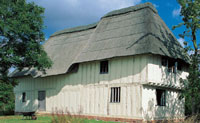
Aisled hall house Stansfield
|
|
1245
|
The monks at Bury were greatly impressed when they heard that Queen Eleanor had given birth to a son, and that he was to be named Edmund after the saint and martyr. On 18th January King Henry III wrote to ask the abbot to announce this to his monks.
In 1245 Earl Roger Bigod went on campaign to Lyon. He was the third Bigod to be called Roger. Military conquest was a way to make money, and this applied to the soldiers as well as the commanders. John Algar esquire was a soldier on retainer to Bigod. Algar had a manor at Brockley, and some land at Loddon, but probably doubled his annual income by being ready to fight for Bigod. He would expect to be paid between £10 and £20 a year, as well as getting free board and lodgings when on campaign. Algar was probably also a farmer in his own right, but one willing to risk danger for extra income.
Such a man would emphasise his status wherever he could. He might build a moat around his house, as many did on the Suffolk claylands in the late 12th and 13th centuries. He might keep hawks, or empark part of his land. He might build a new bay on to his timber aisled hall. He could not afford stone building, but could still put on a good show in timber. The aisled hall house shown here is located at Purton Green, in Stansfield. It had two bays when built, in about 1250. This house would have suited a prosperous peasant family or a minor landlord.
Purton Green is one of the lost villages of Suffolk, where generations spent their lives, but which are now just patches of lime and fragments in the plough. It lies on an old road running south from Bury St Edmunds to Clare via Gatesbury's Farm. Today it hardly survives as a path, and access is from the south, requiring a ford crossing, and a 400 yard walk. All that remains of a village is this house. Inside its late medieval walls survives a hall of 1250 – a great rarity. Aisled on both sides, with scissor-braced trusses and a highly ornamental arcade at the low end, it must once have been an important place. The high end of the house dates from a rebuild in about 1600.
The house survives because it was bought as a ruin by the Landmark Trust in 1969, and restored as a holiday let in the 1970s. As with almost all medieval houses, a floor and central chimney stack had later been inserted, but these additions were so derelict that the Landmark Trust felt justified in removing them, to return the hall to its original open state.
|
|
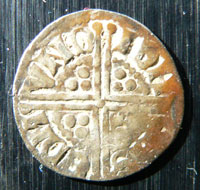
Long Cross penny of Henry III
|
|
1247
|
The Bury Chronicle recorded that there was an alteration to the coinage of England and King Henry granted a newly cut die to St Edmund's. The new die was to be used freely with the right of exchange, just as the king himself used his dies. The new mandate was issued in December. It may be that the town had been left out of this change initially, as there is evidence that two monks, Edmund de Walpole and Thomas, went from Bury with charters to see the barons of the exchequer to prove that the abbot of St Edmund had the right to a mint and exchange.
The change referred to was from the short cross coinage to the long cross, whose arms would reach to the edge of the coin. The earlier Short cross coins were certainly produced at Bury in the reign of Henry III. The aim of this new design was to deter the clipping of silver from the edge of the coinage.
The coin shown here was minted at Bury by a moneyer known as John, and from its design dates to 1248. The inscription reads ION/ONS/EDM/VND, or John of St Edmunds. John was the name of the moneyer, no doubt licensed to make coins in Bury by the Abbot, who himself held the King's mandate to arrange for their production. The obverse shows a portrait of the King and the legend HENRICUS REX TERCI.
Perhaps Haverhill's most famous son was William de Haverhill, who became Treasurer to King Henry III in 1247. He was also a Canon of St Pauls. He was a great success in government and apparently played an outstanding part in keeping the country on an even keel. Little else is known about him.
|
|
1248
|
Abbot Henry of Rushbrook, who had been abbot at St Edmund's since 1234, died in June, 1248. In July Master Edmund de Walpole was elected abbot. He had only been "two years in religion from the day he professed to the day of his election." He must have been an outstanding figure to achieve this, and it had been him who had led the delegation to retain minting rights in the previous year.
Richard fitzGilbert was the 7th Earl of Gloucester and 5th Earl of Hertford, who held the extensive lands in Suffolk and beyond, known as the Honour of Clare. He was a supporter of the mendicant friars and invited the Augustinian friars to come to England, so leading to the founding
of Clare Priory in 1248. He died in 1262.
The Friars Eremites of the Order of St Augustine were also known as the Austin Friars, and Clare Priory was to be their first step into England. Clare became the mother house of the Order in Britain. Until 1124 Clare castle had contained a Benedictine Priory, but in that year it was removed to Stoke by Clare. The Austin Friars got their own premises just outside the castle.
|
|
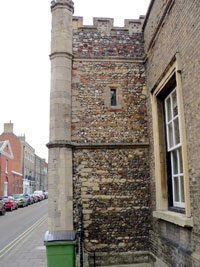
Guildhall porch with earlier evidence
|
|
1250
|
The Candlemas Guild built a porch on to the Guildhall in Bury. Its remnants can still be seen within the 15th century later improvements.
What was Suffolk society like at this time? This question was addressed by Mark Bailey in his book "Medieval Suffolk", published in 2007. A small group of landlords held the biggest share of the land. Land was the basis of wealth, and even men who made money from trade aspired to buy a country estate. These lands were usually rented to tenants rather than being directly farmed by the owner.
Earls and Barons were on the same level as Bishops and Abbots, and together these were the aristocratic landlords who owned most of the land between them. They would make more than £500 a year from their estates.
Below the aristocracy came the Gentry, owning much less land. They might be Knights or just local landlords.
The rank of landlords below the Aristocracy were the Knights, who might make £100 to £300 a year. A knight would own land worth well over £100 in order to generate this income. Bailey suggested that these were a declining class in this century. Suffolk had around 100 knights in 1200, falling to only 30 by 1300.
Minor local landlords would be doing nicely on £20 to £100 a year.
|
|
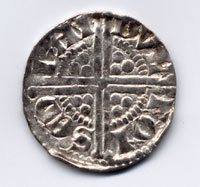
RAN/DVL/FON/SED
|
|
1251
|
From 1251 a slightly different pattern of silver penny was produced. At Bury, one of the moneyers now operating was called Randulf, and the coin illustrated here was minted by him at Bury St Edmunds. No doubt he did not strike it personally, but was probably a gold or silver smith, employing a number of craftsmen in a workshop to make coins. He may well have had another workshop where articles of jewellry would be made.
You can see the reverse of this coin, as well as more coins minted at Bury St Edmunds by clicking here:
Medieval coins minted at Bury
|
|
1252
|
At the death of William de Haverhill in 1252, things began to go wrong for King Henry III, ending six years later in civil war.
The famous chronicler Matthew of St Albans wrote, "Nevermore will mourning Haverhill give birth to any like him."
The Bury Chronicle recorded that the summer was so hot that it killed many people. It also noted that Prior Richard died in October, and was succeeded by Simon de Luton. However, what was noteworthy was that he was selected by the new method of scrutiny. This entailed the abbot and two monks taking a vote orally from each monk. Before this date the Abbot had appointed the Prior, but the convent had now secured a prominent part in his appointment.
|
|
1253
|
According to the Chronicle the sea flooded its shore and submerged many coastal districts.
This event occurred at a time when the average sea level at Great Yarmouth is estimated to have been 4 metres lower than at present. There were many more coastal salt marshes around Suffolk then than there are today. This situation seems to have changed after about 1275, when sea levels seem to have begun to rise.
|
|
1254
|
Representative knights of the Shires were formally summoned to the Great Council, probably for the first time, to report on decisions made in Shire Courts. They were running their local areas through the Shire Courts.
King Henry went to France to pacify the inhabitants of Gascony. He then visited Pontigny to visit the Shrine of St Edmund the Confessor. Edmund Rich had been Archbishop of Canterbury, but died in 1240 at Pontigny. He was canonised in 1247, and should not be confused with St Edmund, King and Martyr, whose shrine was, of course, at Bury St Edmunds.
In Proceedings of SIAH, volume XXXIX part 1, (1997), M Hesse discussed the early estate at Ickworth. One conclusion was that,
"There may have been a small park in Ickworth in the 13th century. In 1254 the King granted
free warren in Ickworth to Thomas de Ickworth (C.P.R.,37-38 Hen. III, Pt. II), and Abbot Simon
of Bury gave licence to 'Thomas our knight .. . to make ditches round his woodland in the vill of
Ickworth, and enclose said wood by a ditch within the bounds set between us and him' (Gage 1838,
278). There is, however, no evidence that this park was ever in fact created, and it will be argued
later in this paper that, if it existed at all in the 13th century, it must have been very small by
medieval standards.'"
|
|
1256
|
Abbot Edmund de Walpole of Bury died on 31st December.
|
|
1257
|
The king's brother Richard, Earl of Cornwall, was elected King of Germany in January. On route to his new kingdom, he stopped at St Edmund's.
On 14th January Simon de Luton, the Prior was elected Abbot of St Edmund's. The Pope refused to confirm him as abbot unless he travelled to Rome in person. Simon was thus the first abbot from any of the exempt abbeys of England to have to go to Rome for confirmation of his election. Not only was this tedious, but also very expensive. This trip cost £2,000, and it now became the norm for new abbots to have to make this journey.
Henry III was persuaded by the Pope to accept the kingdom of Sicily for his son Edmund. The snag was that he would have to raise an army to conquer the island. The Barons refused to provide the money for this venture and the Great Council tried to set up its own Government. It started to think of itself as a Parliament.
Henry the Goldsmith was one of the richest men in Bury and he kept his sheep in his own sheepfold, despite the fact that everybody else had to pay rent to use Abbey folds. Abbey servants raided his farm, beat up the shepherds and scattered the sheep. Henry was sure that he had the legal right to have his own folds, and as many sheep had died following the outrage, he appealed to the King. The king asked Gilbert of Preston, one of his Justices, hear the complaint.
The Bury Chronicle recorded that on 22nd June the Friars Minor entered the town of St Edmund's by stealth. The Franciscans celebrated mass in an audible voice in the presence of all comers, but unknown to the convent. The local Franciscan Friars Minor were saying mass in the home of a local supporter, Sir Roger de Harbridge just by the east side of the Northgate. Meanwhile, when Sir Roger and the Friars sat down to dinner, the Abbey's supporters were demolishing the Friars' Oratory and buildings in an attempt to drive them out.
The friars had considerable support. King Henry III, Gilbert de Clare and many burgesses wanted to help them break the monopoly of the abbey within the banleuca.
During July there was heavy rains and extensive areas were flooded. Much of the corn harvest was destroyed or badly damaged.
Abbey power was again challenged when the Franciscan Friars gained permission from Pope Alexander IV to settle within the Liberty of St Edmund. They set themselves up under the abbey's nose in a farm within Northgate. The abbey expelled them despite the Pope's blessing and the Pope had to call in the Bishop of Lincoln to try to enforce his wishes. He would not call on the Bishop of Norwich for help as he was sympathetic to the Abbot's cause. After this, not only were the Friars thrown out of town, but so was the delegation of the Bishop of Lincoln.
Despite Lavenham being within the Liberty of St Edmund, Hugh de Vere, the 4th Earl of Oxford, gained a charter to hold a Whitsun Fair and a market every Tuesday in his manor at Lavenham. Since Norman times the de Vere family had been lords of the main manor in Lavenham. In 1141 the de Veres became Earls of Oxford, and thus hereditary holders of the office of Lord Great Chamberlain. The 3rd Earl of Oxford was one of the 25 barons of Magna Carta, and now, faced with the 4th Earl, the hard up Abbot Simon of Bury probably decided not to fall out with such a powerful figure. For many years the de Vere main residence was in their castle at Hedingham. They retained a manor house in Lavenham and a hunting park to the north of the town, and must have kept close links with Lavenham and it undoubtedly held a great value for the family.
|
|
1258
|
This was a year of shortages as there had been extensive floods in July of 1257, and the price of corn had now rocketed out of reach of the poor. The Bury Chronicle said that many died of hunger.
The Chronicle also recorded that the great men of the land were exasperated with the Queen, the King's brother, and their French kinsmen who behaved like tyrants wherever they held sway. The king was forced to send them into exile.
On 25th April, the Chronicle recorded a forced entry into the town by the Friars Minor, with royal authority and armed force, led by Gilbert de Preston, the justice of the King's bench. The Chronicle said, indignantly, "This was a violation of the rights and privileges of the Liberty of St Edmund."
In November the king was at Bury when a gale blew down many houses, trees and towers.
|
|
1259
|
Matthew Paris, the great Chronicler, died at St Albans. Much of the known story of Bury and the Magna Carta was recorded by him and Roger of Wendover, his predecessor. For the thirty years after Paris's death there was no more history written at St Albans. The Bury Chronicle becomes valuable to historians after 1265 because of this.
The king sent two writs to the alderman of Bury, over the head of the abbot, asking them to help the Franciscans. The first was in February and called on him to protect and cherish them. The second, in July, ordered him to allow the friars to build a chapel and worship there, despite the opposition of the Sacrist of the Abbey.
Following a nine year law suit, Richard de Clare, the Earl of Gloucester, reached an agreement with the convent over lands in Mildenhall and Icklingham.
|
|
1260
|
A quarrel broke out between the king and the magnates because the Provisions of Oxford had been very little observed. Simon de Montfort emerged as the leader of the Baronage, recorded the Chronicle of Bury.
The Great Council of Barons tended to break into feuding sections and the King started a war to wrest back his control. This is known as the Barons' War. Only the barons who stayed with Simon de Montfort were ready to take on the King.
The debts of the abbey amounting to 5,000 marks, were divided equally between the Abbot and the Convent.
At about this time, Papal Commissioners were sent to Bury to try to sort out the Abbey's dispute with the Friars, but the Abbot refused to see them. The King intervened and the Friars were put up by St Peter's Hospital while their future was pondered.
|
|
1262
|
Pope Alexander died in 1261, and his successor Urban, was apparently less sympathetic to the Franciscans. After he received a delegation from the Bury Benedictines, the Franciscan Friars were ordered to pull down their buildings in Bury and leave town. They did this in November 1262.
|
|
1263
|
The King obtained the Pope's permission to renege on the Provisions of Oxford. The Chronicle records that the barons now sent out men to plunder England. The Bishop of Hereford was locked up and to avoid a similar fate, the Bishop of Norwich fled to the security of St Edmund's Liberty. "For at this time the Liberty of St Edmund was exceedingly precious in the eyes of the barons". The king of France was asked to arbitrate between the parties.
According to the Bury Chronicle, the Friars Minor voluntarily gave up their place in the town, despite the king's order. They had lived there for 5 years, 6 months and 24 days. A papal letter had been received ordering them to leave the said place.
King Henry III was on the side of the Franciscan Friars, particularly because his wife, Eleanor, was a supporter of the whole mendicant movement. The friars wanted to stay in West Suffolk, and with the King's support they were able to do this.
By 1265 the Abbey finally gave the Franciscans land for a permanent home at Babwell just outside the Banleuca where today's Priory Hotel stands.
|
|
1264
|
The King of France said that Henry III was free of any obligation to observe the Provisions of Oxford. War broke out all over England, said the Bury Chronicle.
Simon de Montfort, the Earl of Leicester, defeated the King's army at the Battle of Lewes on May 14th.
However, Simon only won with massive support from citizens of London. Gradually he relied more and more on merchants and small landowners, clergy opposed to the papacy and radical students from Oxford. His forces became less aristocratic and more middle class.
De Montfort's rebellion produced a crisis across the country, and old disputes came out into the open again. At Bury some fairly old grievances against the abbey which had dragged on for years finally erupted in the first of a major series of riots. Abbot Samson's charter of 1194 was the basis of this quarrel, as Samson had kept the wardship of the East Gate, and retained the power to veto town appointments to the other four gates. He also retained the right to hear town cases in his own court.
The story of this uprising comes from the document known as the Pinchbeck Register.
In the Spring of 1264 a group of younger burgesses confronted Abbot Simon of Luton with a series of demands. They demanded to be recognised as a corporate secular guild, in which would be vested power over the town's affairs. Acting quickly, the Guild of Youth was formed in Bury St Edmunds by 300 people in protest against the Abbey. They elected an alderman, setting aside the offically appointed man. They set up a court in opposition to the Portmansmote and restricted the monks to the abbey. The new court had its own horn to summon people to justice.
Street fighting went on for several months, as anyone who ignored their authority was attacked as a public enemy. Eventually they attacked the abbey gate, broke into the cemetery gate, and assaulted the monks. The sacrist and cellarer were thrown out of the town gates, and when the abbot hurried back to Bury, they would not let him in the town. At this time it appears that even some of the older burgesses and even the alderman, supported the Guild of Youth in this. Things carried on uneasily until October when a writ was issued for Gilbert of Preston and William de Boville to hear the abbot's complaints against the Guild. At this royal intervention the older burgesses gradually took fright and withdrew their support. They promised to disband the Guild agreed to accept a fine of £40.The guild or horn was finally disbanded and the Guild of youth's pretender Alderman was also sacked.
The abbot had won yet again, but it had been seen how easy it was to seize power from the monks, and this violent precedent would be remembered again in 1292, when the time was right.
|
|
1265
|
Simon de Montfort summoned a Parliament and invited representatives of the burgesses of the Chartered towns and two knights from every Shire. It contained only five earls and seventeen barons and the balance were from the middle classes.
Gilbert de Clare, the Earl of Gloucester had been a supporter of the Earl of Leicester, but now deserted him in a quarrel over the spoils.
Simon de Montfort was defeated and killed by Henry's son Edward, who had joined with Gilbert de Clare in the Battle of Evesham in the Severn Valley. The monks were, perhaps, sympathetic to De Montfort's cause. They wrote that his body had worked miracles, and a minor cult began to arise. The king now regained power and proceeded to confiscate lands and property and disinherit the supporters of De Montfort.
|
|
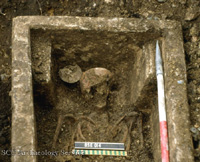
Stone coffin from Babwell Friary
|
|
blank |
In 1265 the Abbey finally gave the Franciscans a permanent home at Babwell just outside the Banleuca where today's Priory Hotel stands. With land given reluctantly by the Abbey at Bury, and financial help from the Earl of Gloucester, Gilbert de Clare, the Franciscan Friars finally founded their Friary at Babwell. The name Babwell no longer survives, but the Priory Hotel stands within the walls of the old Friary precincts at the junction of Tollgate Lane and the Mildenhall Road. Only remnants of the walls remain visible today.
The illustration is of a stone coffin and male burial recorded during excavations at the Babwell Friary, just north of Bury St Edmunds. Beside the head are a pewter communion chalice covered with a paten (plate). This was one of the community of friars; stone coffins were uncommon and suggest that the man was of some importance.
There have also been remains of a mill found behind the Tollgate Inn, possibly associated with the Friary.
However, the Grey Friars still could not enter town without the abbot's permission, and thus were excluded from an easy involvement in civic life. It is not surprising that they tended to side with the townspeople in their disputes with the abbey. In turn they won many friends in town.
They were not the only religious dissidents against the abbey. The rectors with livings in the town, and the so-called secular priests, were treated as second class churchmen by the monks and in turn they also sided with town against abbey. This religious backing was to become important to the burgesses in their growing struggles with the great abbey.
The second great chronicle from the abbey of St Edmund was written from the Creation up to 1265 by the Monk John de Taxter. He became a monk in 1244. A second unknown monk continued the work up to 1296, and a third took it up to 1301. These annals are of little historical use up to 1264 as they are brief and written after the events, but from the Battle of Evesham, they suddenly become detailed and vivid. It seems likely then, that they were started in order to record these momentous events in 1265.
|
|
1266
|
After the overthrow of Simon de Montfort fugitives sought sanctuary within the Liberty and also stored their loot there. These are referred to as the "Disinherited" by the Chronicles. According to the Bury Chronicle, "some of them who were lying hidden at St Edmund's, marched from the town in battle order and invaded the Marshland. They even attacked Lynn".
In May, John de Warenne and William de Valence came to Bury to seek out the king's enemies. They sought out the abbot and burgesses and accused them of helping the disinherited.
This led to a scandal and an enquiry and resulted in the abbot paying a fine of £266 13s 4d to re-establish himself in Henry III's favour. Someone had to take the blame, and now the burgesses were accused of being Montfortian sympathisers. There probably had been a strong support for de Montfort, as he had local supporters like Richard, Earl of Clare, and his son Gilbert, who owned parts of Bury. The earl of Suffolk had also supported him. Specific accusations included that they had let the Disinherited in by lax gatekeeping and had supported the rebels in 1264. This score was now settled as well. To avoid more severe reprisals from the King's justice, the burgesses had to deny that the keeping of the gates was really their responsibility, and that they never really wanted to take over the town. So they dissembled to escape royal wrath, and disclaimed many of the hard won advantages they had recently won. They were also fined and the abbot bailed them out by paying 200 marks on their behalf. In return the abbot was promised £100, but more importantly the town became obligated to the Abbot.
The Disinherited continued to attack the countryside and seized Ely. By December they had raided Norwich and taken 140 carts and waggonloads of loot.
The Dictum of Kenilworth had to be issued to prohibit the cult of Simon de Montfort as a miracle worker. At Bury, the chronicle entry of 1265 relating to these miracles had to be scratched out to conform to the new law.
We know that Bury had a cordwainer's or shoemaker's guild at this time, from a deed recording the transfer of a shop in Cordwainers Street from Geoffrey le Porter to Guild for its headquarters.
|
|
1267
|
The king knew he had to put down these rebellions in the Fens, so King Henry III came to Bury St Edmunds on February 6th. Next day the papal legate Ottobuono also arrived. All the prelates and magnates of the land had been summoned by both church and state to attend. On February 22nd the legate held a council in the king's presence to excommunicate the Disinherited who were occupying the Isle of Ely, together with all their supporters unless they gave up within 15 days. This caused such discontent that certain rumours so scared the Legate that he left for London within 24 hours. The town was obviously still in turmoil, and lawlessness was still common. Robert of Bradfield and John of Punchardon were appointed keepers of the town to try to restore order. The king also took his court out of Bury to meet his army at Cambridge, and on to besiege Ely.
Gilbert de Clare, Earl of Gloucester now marched on London while the king was at Ely. The King had to leave his siege and hasten back to the capital, and a truce was made on June 18th.
Meanwhile some ruffians came out of Ely and stole horses from the Liberty of St Edmund, according to the Bury Chronicle. A monk seems to have negotiated them back again, and in July the king's son Edward regained the Isle of Ely.
Rabbit warrens become popular in the 13th century and free warrens were granted in Haverhill to Hamo Chevre by Henry III in 1267, and later to Roger Lunedaye by Edward I in 1281.
|
|
1268
|
The Abbey was assessed for taxes under the auspices of the Bishop of Norwich, when the king assessed all ecclesiastical revenues to tax at their "true value". The monks felt this was against the rights of the Liberty, but nevertheless they submitted. The assessments were recorded in great detail in the Bury Chronicle. It was also recorded that the monks paid the episcopal assessor and collector 20 marks to overlook the tax due from the ir holdings within the town of Bury, but this failed.
The Chronicle seems to ignore the happenings outside the abbey walls. In September the king "impleaded" the alderman and 24 burgesses for ignoring the orders of the keeper of the town, Robert of Bradfield. There were some fines levied by the justices in eyre in Cattishall, and the situation seems to have calmed down.
|
|
1270
|
The Chronicle recorded the death of Roger Bigod, earl of Norfolk and Suffolk, and marshal of England, at Cowhaugh. He was buried at Thetford, and his inheritance went to another Roger, the son of his brother, Hugh Bigod.
In 1190 Abbot Samson had expelled the Jewish community from Bury St Edmunds. However, we know that in 1270, a Jewish businessman called Moses of Clare, lived near Sudbury within the Liberty of St Edmund. It is likely that some commercial links would be retained with Bury, and it is possible that he either owned or rented Moyse's Hall in Bury. There is a tradition that Moyse's Hall was built as a Jewish Merchant's house around 1180. In this case Moses of Clare could not have built it himself, even if he occupied it 90 years later. Today it is a town museum.
|
|
1271
|
Gilbert de Clare, earl of Gloucester divorced his wife Alice at Norwich. According to the Chronicle he had suspected her of having an affair with the king's son Edward in 1269, and had quarrelled with the prince, but made it up.
Marco Polo began his voyages to the east and continued until 1295.
|
|
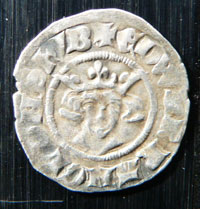
King Edward I
|
|
1272
|
The Bury Chronicle recorded a great assault upon Norwich abbey by 32,000 men of the town, "armed to the teeth." There was loss of life and massive destruction. A council of the whole diocese was held at Eye to excommunicate everybody involved. The king set out to Norwich to punish the city, and called a council meeting to consider the action necessary.
King Henry III held this Parliament at St Edmund's Abbey, on route to Norwich, arriving in Bury on September 1st and leaving on the 15th. While there, he signed a warrant to transfer the Jewish Synagogue in London over to the Penitentiary Friars, the Brothers of Penitence. Not surprisingly the Chronicle says, "to the utter confusion of the Jews."
At Norwich there were 35 executions and many fines threatened to make recompense for the crimes against the abbey, but the monks of Bury felt the king had "compromised a little, doing only partial justice for the outrage."
King Henry III, "of happy memory", died on November 16th, having reigned for 56 years and 29 days. Edward I came to the throne and reigned until 1307. However he was abroad at the time, so the country was put in the hands of Gilbert de Clare and Edmund, Earl of Cornwall.
From 1272 until 1278, the Long Cross Coins were still being issued under Henry III's name. Only 3 mints are known to have worked at this time, being London, Durham and Bury St Edmunds. Strangely, the Bury coins are the commonest of the three today.
In the
late 13th century the Maison Dieu or God's House was founded, a substantial almshouse near St Petronilla's hospital in Southgate Street in Bury.
|
|
1273
|
In March there was so much rain that there were floods worse than any since 1258. Water rose 5 feet above the bridge at Cambridge, and the damage at Norwich was said to be worse than the ravages of either the disinherited or the king's men last year.
The Bury Chronicler recorded another tax levy to support the needs of the new king.
|
|
1274
|
Prince Edward returned from abroad for his coronation. Edward must have liked Bury as he seems to have visited the town at least 15 times in his reign, and kept a permanent residence in the abbey complex.
To illustrate the involvement of the Sacrist in matters of local justice, we hear him accused of holding an iter or sitting at Bury for a longer period than the King's Justices had sat at Cattishall.The Sacrist was sitting as a Justice in eyre or Justice of Assize, appointed by the Abbot as part of his responsibility for carrying out the King's Justice within the Banleuca. The portman-moot seems to have declined greatly in the administration of local justice by this time. The local laws were being appropriated by the state more and more, and through this mechanism to the abbot and the abbey sacrist and his bailiffs.
|
|
1275
|
The new king, Edward I, came with his wife to Bury, on a pilgrimage, in accordance with a vow made in the Holy Land. He granted the convent the right to hold the view of weights and measures, without any of his officials being present. For this right the abbey paid him 100 marks. According to Lobel, this was not the first such grant, and this liberty may have existed already since the time of Richard I.
The last major addition to the fabric of the abbey was perhaps the new Lady Chapel built by Abbot Simon of Luton in 1275. The Chronicle recorded that the old chapel of St Edmund was pulled down and the Lady Chapel built on its site. Under the earth were found the walls of an ancient round church, which was much wider than the chapel of St Edmund and so built that the alter of the chapel was, as it were, in the centre. "We believe that this was the chapel first built for the service of St Edmund." It could have been the foundations of Ailwin's stone chapel of 1032, or maybe even stone foundations to the wooden church first built in 903.
Another tax of the 15th penny was recorded in the Chronicle, as well as the 10th penny decided at the Council of Lyons by the Pope. By this time heavy taxes and other financial weaknesses seem to have hit the abbey at Bury very hard, and retrenchment replaced expansion. Only small additions to the building programme would now be possible, if any at all.
The king finally announced the fines and penalties to be paid by the Burgesses at Norwich for the attack on the abbey there in 1272. At Cambridge the King allowed his mother, Eleanor, the right to expel all the Jews. She was allowed to do this in all her dower towns.
In the mid 13th century the average sea level at Great Yarmouth is estimated to have been 4 metres lower than at present. There were many more coastal salt marshes around Suffolk then than there are today. This situation seems to have changed after about 1275, when sea levels seem to have begun to rise.
From 1275 to 1345 the coast of East Anglia would suffer many major inundations by the sea. The weather seemed to turn stormy followed by violent swings in weather patterns accompanied by large marine surges. Thousands of acres of salt marsh would be flooded, coastlines altered and harbours washed away. The most notable casualty would be Dunwich which had been a major port. It would lose six parishes, over 600 buildings and its harbour mouth between 1275 and 1345. Over 80 acres of salt marsh disappeared below the sea here.
|
|
1276
|
At Cambridge a great part of the town, including St Benet's, was burnt down. Even more seriously, the Chronicle recorded that a deadly disease began to afflict sheep in Lindsey. It lasted many years and spread over most of England.
|
|
1277
|
The King sent a large army to Wales. Before joining them he came to Norfolk and Suffolk, keeping Easter at Norwich. This resulted in yet another round of taxes recorded by the abbey chronicle. This time the town's tax was paid by the convent to be collected from their tenants at a later date.
A cloudburst in October caused many men and livestock to be drowned in the floods. The storms were worst in Essex and Cambridgeshire and around Bury itself.
|
|
1278
|
The King and Queen arrived at Bury on 23rd November on route to Norwich to dedicate a church there.
All the Jews in England were unexpectedly seized and imprisoned. Their houses were ransacked looking for evidence of clipping the king's coinage. Soon afterwards in November all the goldsmiths and officials of the country's Mints were also put into custody and their premises searched. At Bury, despite the privilege of the Liberty, five goldsmiths and three others were marched off to London by the town bailiff. The king then allowed them to be sent back to Bury for trial, as a special favour to St Edmund.
|
|
1279
|
All the Jews and some Christians convicted of clipping or falsifying the coinage, were condemned to hanging. Some 267 Jews were condemned to death in London.
John de Cobham and Walter de Heliun, were the justices appointed to determine pleas over money, and they were sent by the king, Edward I, to Bury to hold a court at the Guildhall. The monks regarded this as flouting in an unheard of way, the liberties of St Edmund's church. Even worse, any fines levied went to the royal Treasury, and not to the abbey convent. Because the Sacrist was in charge of the Mint at Bury, he was also fined 100 Marks for the transgressions of the moneyers.
Holding their enquiry at the Guildhall shows its importance in the town by this time. This is the earliest known written record of the existence of the Guildhall in Bury St Edmunds, but evidence from recent examination of the rear of the building shows that it may have originated a century earlier. The earliest reference to Guildhall Street itself comes from the 1290s.
Simon, the abbot at Bury, died at his manor of Long Melford. The king, as was normal, took over the revenues due to the abbot until a successor was in place. However, going against precedent, he also took over the income due to the convent of monks at the abbey. The monks were allowed only enough for their sustenance by John de Berwick, the king's agent.
Meanwhile, John de Northwold, a Bury monk, and the interior guest master, was elected Abbot. He had to travel to Rome to be confirmed in his position and had to be empowered to pledge the credit of the convent up to £500, to pay for the trip. When he got back, the king ordered Berwick to restore the barony to the abbot and the rest to the convent on November 5th 1279. The trip cost the abbey 1,675 marks, 10 shillings and 9 pence. Abbot John would rule the Abbey until 1301.
The coinage was altered this year. The triangular farthing, made by cutting a penny into four quarters, was replaced by a round one. Half pennies were abolished and a new four pence coin was invented. This was the first groat. According to the Bury Chronicle, the abbey did not receive new dies for this coinage until June, 1280.
|
|
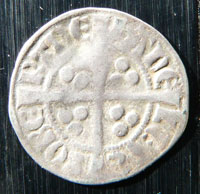
ROBE/RTDE/HADE/LIE
|
|
1280
|
In June the Bury Chronicle recorded that the new coinage began to be produced at Bury. The old coinage could no longer be used after August 15th, Assumption Day. Apparently new round halfpennies were minted.
Suffolk's only mint was at Bury St Edmunds. In general these new coins gave the mint name in full and omitted the name of the moneyer for the first time since the 9th century. Curiously enough, some issues from Bury St Edmunds were the total reverse of this policy, giving the moneyer's name in full, ROBERT DE HADELIE, and omitting the mint name.
Robert the Prior, resigned due to his paralysis, to be succeeded by Stephen de Ixworth, the sub-prior. Simon of Kingston, the Sacrist, also resigned, to be replaced by William de Hoo, the Chamberlain. William of Hoo is noteworthy as he left us his letterbooks, published by the Suffolk Records Society in 1963, edited by Antonia Gransden. The Letterbook of William of Hoo covers the years from 1280 to 1294.
|
|
1281
|
To avoid any repeat of the loss of the convent's income to the king, Edward I was asked for a new charter to separate the property of the abbot and the convent. This was agreed, but it cost the convent 1,000 marks, plus a considerable sum in other expenses. This was simply the final and most complete separation of the Abbot's incomes from those of the Sacrist for the convent of monks. The monks knew this well enough, but it was needed to protect themselves from the crown in times when the post of abbot was vacant.
In 1281, the manor of Haberdon, or Haberden, was granted to the Sacrist of the abbey by Henry, son of Nicholas of St Edmund. This would add to the sacrist's income, and included a mill, and at least 51 acres. As the abbey gained more and more of the local pasture land, any common rights hitherto exercised by local people were gradually extinguished by the new owner.
|
|
1282
|
Prince Llewelyn of Wales rose in revolt and destroyed some of the king's castles. In response, Edward I levied a subsidy in the form of loans from all his cities and boroughs and from the clergy to pay for his campaigns in Wales. In June, he sent John de Kirkby, the Archdeacon of Coventry around the country to raise the loans. It seems that he was given a quota of money to raise in each location. Bury was assessed without the wealth of the Abbey, and was shown to be of only middling prosperity at this time, according to Gottfried. However, Bury was above Cambridge and Ipswich in the lists.
-
London's assessed value at the top of the list was £4,000.
- Newcastle was next at £1163.9.0,
- York was third at £693.6.8.
- The assessment was £666.13.4 for Great Yarmouth, which was fifth highest.
- At number eight was £333.6.8 for Norwich
- Number nine was £266.13.4 for Bury.
- Lesser towns were Kings Lynn at £200,
- Ipswich at only £100, (the same as Orford), and
- Dunwich by now was at £66.
By the time of the 1327 subsidy rolls, Ipswich would overtake Bury in its value for taxation purposes.
The Bury Chronicle recorded the subsidy as 8,000 marks for London, 1,000 marks from Yarmouth, £500 from Norwich, and 500 marks from the burgesses at Bury. But the monks' servants had to pay 26 marks, and the prior assessed the Guild of the Twelve at 12 marks. The monks recorded that 100 marks were extorted from the abbot and convent.
By November, it was clear to the King that these loans were nowhere near sufficient to pay for the war, and he summoned a Parliament to York, and another to Northampton, to meet In January next.
A record in William of Hoo's Letterbook concerns a lease of a toft, or shop, in Icklingham, together with a Fulling Mill. This would have been located on the River Lark, using a combination of water and Fuller's Earth to clean the grease from Woollen Fleeces. William the Sacrist would receive his annual rent from the lessees, Robert the Fuller of Icklingham and his wife Cecily.
|
|
1283
|
In January, Parliament voted the King a taxation levy or subsidy of one thirtieth part of the moveable goods of all subjects, to pay for the Welsh war. Those who had made the loans in the previous year could offset these against the levy. Bishops, Archbishops and certain Earls who were fighting for the king, would be exempt. Also exempted were those who owned goods worth less than half a mark. The Collectors appointed for Suffolk were sworn in during February. They were John de Mettingham and William de Pakenham, assisted by Simon de Dagworth and the Sheriff, William de Royngs.
It would appear from Edgar Powell's research that, out of the whole country, the only Lay Subsidy Rolls to survive from the 1283 Subsidy, were those for Ipswich, and those for the Suffolk Hundred of Blackbourne. What does survive is a list of the Subsidy due from most of the English counties. Suffolk appears fifth in this list.
- Lincolnshire £4018.12.8
- Norfolk £3684.2.6
- Kent £2880.12.7
- Yorkshire £2860.1.9
- Suffolk £2103.18.8
The Hundred of Blackbourne was far from typical of Suffolk Hundreds. It was valued as a Double-Hundred, and had originally been the two seperate Hundreds of Broadmere, or Bradmere, and Blackbourne. Vills which had been recorded as in Bradmere in 1086 included Ingham, Culford, West Stow, Barnham, Barningham, Ixworth, Sapiston, Wyken, Langham and Hepworth. Wordwell, however, which was surrounded by West Stow, Barnham and Culford, was in Blackbourne Hundred in the Domesday Book of 1086. Anomalies like this may have been the reason why the two Hundreds were apparently joined together by about 1100.
According to a document in the Letterbook of William of Hoo, Sacrist to the Abbey, there was a grave incident surrounding the murder of William, Rector of Woodhill, possibly Odell in Bedfordshire. This murder took place near St Mary's church in Bury, and Geoffrey of Redgrave and 12 other young men were present at the murder. Geoffrey and two other men were described later as goldsmihs and clerks. The clerical role gave them some status as clergymen. Another man was a servant of Robert de Hadleye, the Bury moneyer, and one was John of Thetford, also a goldsmith.
The two clergymen may have expected to be tried by the abbot's court, but he declined to claim them, and they were imprisoned.
An inquest was held on the case in February of 1283/84, by Bailiffs appointed by the Abbot. Two men were cleared of murder but convicted for falsifying the coinage and robbery. They were drawn and quartered. Three more were cleared and four of them were hanged for a number of crimes.
This was obviously a very involved case as the murder itself was not the whole story.
Behind the crimes was also the issue of jurisdiction. The Town Alderman should have run the prosecution, but he decided to leave town on the grounds that he was old and too infirm to deal with the case. So the town's Bailiffs at first tried the men and imprisoned them. The sister of the dead man, Eleanor de Gowiz, objected to this and appealed to the King for justice.
The King did issue a mandate to a team to investigate the crime. Abbot John, jealous of this interference in his area of control, sent his own representative to the King to point this out. The King now gave the Abbot the mandate to supervise an inquest by his own nominee Bailiffs. This inquest handed down the sentences already discussed.
After the Inquest, the Abbot's Bailiffs took the whole vill of Bury into the Abbot's hands on the grounds that the Alderman and Town Bailiffs were not up to the job. Next day the Abbot talked this over with the Convent of the Abbey, (ie the body of monks) and decided to restore the vill to its former position, but only after the alderman and burgesses had "bought his favour."
This whole involved issue must have had many aspects behind it which are lost to us today, apart from these bare facts. The issue gets even more involved when we find that in 1293 Geoffrey of Redgrave and John de Perers, both described as Goldsmiths and Clerks, are released and "restored to their good fame."
|
|
1284
|
By this time the Manor of Erbury was established in Clare and a manorial complex with associated fishponds has been identified within the walls of Clare Camp. Clare Priory was built in 1284 when Friars of the newly formed Augustinian Order came to England at the invitation of Richard, Lord of Clare. It was the first British base of the followers of St Augustine of Hippo.
Woodland was scarce and valuable in Suffolk. Much of it had been grubbed out and converted to arable, but the surface of Suffolk had only contained 10% of woodland in 1086. By 1349 Bailey thought that half of that meagre total would have gone under the plough. So what was left was intensively managed, often in fairly small plots.
Elmswell had a large wood at 160 acres and Hitcham had a 246 acre wood, while Hartest had a 100 acre wood and a 12 acre grove.
In the 1280s there was an 8 acre wood at Rickinghall. William de Monastery was tenant, but holding only 1 acre while John de Croue held 7 acres as his under-tenant. Little Whelnetham had eight separate woods ranging from 2 to 10 acres, held by small lay manors or free tenants.
English rule over Wales was established.
|
|
1285
|
Giotto was active in Florence, representing the first major flowering of Renaissance art.
On 20th February, the king, Edward I, arrived at Bury with the Queen and his three daughters, to fulfill a vow he had made on his Welsh campaign. Next day he set out for Norfolk. He upset the monks by having all the weights, measures and ell-measures of the town inspected by his marshall of measures. They believed that this was the job of the Sacrist and his bailiffs, because it had been the subject of a specific grant by the king in 1275. But it seems that on this occasion the burgesses had prevented this from happening until a royal visit was due. After a local hearing, the king granted all the profits from the inspection to the shrine of St Edmund. But he warned the abbey to ensure that weights were checked or "viewed" twice a year between his own visits in future.
The king's Clerk of the Market, Ralph of Midlington, continued to exercise royal power over local trade, in a strict manner, until after the death of Edward I.
|
|
1286
|
News came of a terrific storm at sea, which battered the land so badly that the great city of Dunwich was severely damaged. On three nights early in 1286 a huge storm raged, sweeping away the lower parts of the town and joining the harbour's shingle spit to the coastline to the south of the town. Dunwich no longer had a harbour. Channels would have to be dug through the shingle to enable some maritime access to the town.
Dunwich was the home of an ancient bishopric. Some people believe that it possibly dated back to the time of St Felix, who came from Burgundy to assist King Sigbert in setting up Christianity among the pagan Anglo-Saxons in about 630.
After 1066, Dunwich became part of the Honour of Eye, under Robert Malet and his descendants. Even in 1086 the town had suffered from coastal erosion, but despite this it rose to become a great town, getting a charter from King John in 1199. By 1298 Dunwich would get the right to send two MP's to parliament, and became a great seaport, with trade, fishing and shipbuilding industries. Further damage would occur in 1328, and Over the 14th century its economy would be largely destroyed by coastal erosion, reducing it to a small and declining fishing town.
|
|
1287
|
In January the justices in eyre sat at Cattishall as usual, just outside Bury, near Thurston.
John de Creyk, Godfrey de Beaumont and Ralph de Berners sued the abbey over the manors of Semer and Groton. Fearing that they would lose the case, the monks chose to defend their rights by judicial combat. The abbot hired a champion called Roger Clerk to fight for him, paying him 20 marks in advance, and 30 more to be paid afterwards. This seems to us a very strange way to settle a legal case, and even at the time it must have been an almost obsolete idea, as such duels were from an earlier age. The fight took place on 14th October in London, and Roger Clerk was killed. The manors of Semer and Groton were thus lost to the abbey, but were regained in 1290.
William of Hoo, the abbey's Sacrist, installed Richard de Lothbury, a goldsmith of London, as moneyer for the abbey. This had to be done by presenting him to the Barons of the Exchequer and then a new die was cut in his name.
We know about this from the surviving Letterbook of William of Hoo, 1280-1294, published by the Suffolk Records Society in 1963. Among his many other valuable privileges, the Sacrist controlled the minting of money in the town under a royal warrant.
|
|
1288
|
During the 1280s Sir William de Pakenham was a typical landed knight of the shire. Mark Bailey gave him as an example in his book on "Medieval Suffolk". He owned four manors in Norton, Ixworth Thorpe, Thurston and Bardwell earning him between £25 and £40 a year each. He had smaller manors in Great Ashfield and Pakenham which brought him another £10 a year each. In all, he received about £200 a year, which gave him enough spare cash, after expenses, to spend £140 buying up land at Ixworth Thorpe to provide for his younger son, Thomas. He served as a senior administrator on the estates of the Abbey of St Edmund and the Bishop of Norwich. He was one of two tax collectors in Suffolk for the Lay Subsidy of 1283. Sir William was a farmer and administrator. None of his wealth came from soldiering, the other main way to get rich quick at the time.
Sir William was wealthy by the standards of most landlords. Lesser men could still consider themselves gentlemen on £12 a year, considered to be the average for English lay landlords holding one small manor.
Two men who owed service to Sir William were William de Thelnetham and Ralph de Bardwell. William held a manor at Troston and land in Barnham. He made £15 a year. Ralph had manors in Bardwell and Hunston making perhaps £20 a year. They would support Sir William in any actions he took, protecting their own positions by his friendship.
In the 1280s the largest manors in West Suffolk were associated with the great ecclesiastical landlords, mainly of the Abbey of St Edmund. For example, in Blackbourne hundred, Bailey has pointed out that Bury abbey held seven manors with an average of 320 arable acres and 280 acres in villeinage. In contrast, the 37 lay manors in the hundred averaged about 100 acres of arable and 31 acres held in villeinage. The bishop of Ely held a manor in Brandon of 564 arable acres and the same again under villeinage. The prior and convent at Ely abbey held 600 arable acres in Lakenheath, and the same again let under tenancies.
However, a majority of vills, including Lakenheath were not in the hands of just one landlord. The earl of Clare held 100 arable acres in Lakenheath alongside Ely abbey, while Melford contained a number of manors. At Long Melford, despite the Bury Abbey holding an 800 acre demesne, plus 600 acres of villein land, there were the manors of Kentwell, and a number of smaller ones.
Over the centuries the less powerful landlords had witnessed the fragmentation of their estates by inheritance or the need to retain favour with more powerful neighbours and up and coming tenants. Only the most powerful of lay lords, such as the Earls of Norfolk, based at Framlingham, could retain or even enhance, their holdings. By the 1280s the remainder of Suffolk generally had smaller manors than in the Liberty of St Edmund.
With the growth in population there was a greater demand for food and farming was intensified where possible, and new land turned to arable where possible. By the 1280s it has been calculated by M Hesse that 74% of the surface of the parish of Ickworth was ploughed for grain production. This was probably a 25% increase over the arable proportion since the Domesday survey. Much of this would pass into the growing towns and their markets.
Some manors in north-west Suffolk had another resource at hand. In the valley fens as well as in the great fen, there were pockets of peat. The product of the peat bogs was turves, and the resource was known as a turbary. Turves were probably the single most important source of domestic fuel in East Anglia in the 12th and 13th centuries. The manor of Coney Weston had a small turbary of 2 acres in the 1280s. Hopton contained a 10 acre turbary. The vill of Pakenham was owned by the abbey of St Edmund, but the abbey's tenants there had access to 400 acres of common pasture, marsh and turbary rights.
Residents of Eriswell could cut 4,000 turves a year for their own use. In Brandon the locals could sell thousands of locally dug turves to outsiders. In Lakenheath the locals had to cut around 100,000 turves a year to send to the Abbey of Ely, who owned that vill.
The biggest turbaries, however, were in the area of north-east Suffolk and South-east Norfolk. Bailey suggests that these workings produced 12 million turves a year in the 13th century. When these diggings eventually became flooded over the following centuries, the Broads would be formed.
|
|
1289
|
King Edward I and Queen Eleanor visited Bury St Edmunds, having returned from three years abroad. They landed at Dover on 12th August, proceeding through Kent and Essex, reaching Bury on 12th September. Next day they went to Norfolk, then through the Isle of Ely by boat to be in London by mid November.
The king's chief justice, Thomas Wayland was indicted for harbouring some of his own men who had killed another man. He feared the King and so fled to Bury to take sanctuary with the Friars Minor, the Franciscans at Babwell. On the king's orders he was besieged by men of the neighborhood for several days. He even became a monk, or "assumed the habit", but this just caused the king to send further reinforcements to his blockade. After two months Wayland admitted defeat and gave himself up, and was taken to the Tower of London.
|
|
1290
|
The king held a Parliament in Westminster to discuss the wrongdoings of some Justices. Among them was Thomas Wayland, who had all his property confiscated, and was sent into exile. He had held the manor of Onehouse from St Edmund's abbey, and had been an important East Anglian landowner.
A man called John Harrison tried to set up a new song school in Bury to rival that provided by the Dusse Guild. He was backed by the Abbot, John of Northwold, in an attempt to bring this teaching under abbey control. The Guild, however was rich and powerful and protested against it. The Abbot was forced to withdraw his formal support and the new venture then collapsed. The town was proud of this bit of independence from the abbey, and this time was able to come out on top.
The cellarer had dammed up the Tayfen brook, and flooded some lands used by towns people. The leading townsmen were united against this act, and called a meeting in the Guild Hall. They then set out to destroy the dam. In October, a commission was set up to enquire into their actions, but this only made matters worse. This rumbled on into more violence in 1292.
The Bury Chronicle recorded that the king "exiled without hope of return all Jews of both sexes and every age living in England."
|
|
1291
|
The abbot and convent of St Edmunds' paid a fine of 1,000 marks to the king in lieu of paying a fifteenth of their own property and that of the burgesses of the town, lest the royal officials should try to do anything which would prejudice the liberties of St Edmund's Church. The abbey officials then levied the tax themselves on the town.
To emphasise the importance of monastic chronicles in recording history, we can examine the King's claim to the overlordship of Scotland. In July 1291, he sent copies of letters of allegiance to all the main monastic houses instructing them to "have these letters recorded in your chronicles so that these events are remembered forever."
|
|
1292
|
The pope granted the king a tenth of all the spiritual revenues in the land, and the abbey was included in yet another tax. The Bury Chronicle recorded the assessment in great detail. It came to £1,098:8s:8d for all the holdings in Norfolk and Suffolk. The tax was £109:16s:11.
With his son and daughters, the King came to Bury on 28th April, and celebrated the Feast of the Translation of St Edmund with full rites. For ten days he divided his time between Bury and Culford, the abbot's manor three miles from Bury. He granted a charter saying that the the session of the king's justices should not be taken as a precedent to the prejudice of the abbot and convent.
The events of 1292 recorded above were in the Bury Chronicle. The following events in that year did not get mentioned in it.
Old grievances erupted again in 1292 over the control of the town gates, and who ought to run the town's secular affairs. The violence was not too extreme, but, following some riots, the burgesses of Bury proposed to the Abbot, John of Northwold, that his Port Reeve should be replaced by a town nominee. Their man was called John the Goldsmith. The Port Reeve was the abbot's man who ran the secular government of the town. The burgesses proposed that the head of the Town Guild should be given this right and that he should be called the Mayor, as the first citizen was called in the Boroughs like Thetford and London.
Abbot John objected as the Guild was a commercial body but the office of Port Reeve had wider governmental powers. The abbot took the case to court, but eventually, before the case was concluded in 1293, he agreed to a compromise. He would allow the new post to be called Alderman, but not Mayor. He would not accept that the town should have a free hand in the appointment, and insisted on selecting one man from the three nominees he would let them propose. But it seems that John Goldsmith still got the job on this occasion.
This arrangement lasted until the Dissolution, with the town gradually increasing its say over who was selected. The Town Guild now became called the Alderman's Guild, and the new office came to have considerable influence in town affairs.
By 1292 the position of the old borough court, the portman-moot, was considerably undermined. The burgesses still claimed that their pleas should be heard in the toll house where the town's judicial affairs had traditionally been held, and not before the king's justices in the abbot's hall of pleas. The abbot insisted they met wherever he said, and his will prevailed, but the argument continued on for years.
|
|
1293
|
The Chronicle recorded two great sea battles between the English, allied with the Irish and men of Bayonne, and the Normans. Thirty captured Norman ships were taken to Yarmouth laden with booty.
On 9th July a great part of Cambridge was burnt down, including the church of St Mary.
There were two lawsuits between the town and the convent during the reign of Edward I, according to Lobel. These were settled in 1293. One case was described above and the other confirmed that all burgesses must be in tithing. For years they had had to pay a yearly tithe of one penny, also called borth-selver, whether or not they were already paying hadgovel or ground rent for their tenements. The town had challenged this, and whether the view of frankpledge was due to the sacrist at all if he was already receiving these other payments. The town lost and this tithe was now to continue as before.
In 1293, Geoffrey of Redgrave and John de Perers, both described as Goldsmiths and Clerks, seem to get their convictions for the murder, in 1283, of William of Woodhill overturned. On the order of Abbot John, they were admitted to Compurgation, released and "restored to their good fame."
Compurgation, also called wager of law, was a defense used in earlier times, whereby a defendant could establish his innocence or non-liability for a crime, by taking an oath and by getting a required number of persons, typically twelve, to swear they believed his oath. Not surprisingly, this defence had been abolished in civil law in 1164. The Church, however, continued to accept this defence.
The murdered man's brother, Sir John of Woodall, objected to this process unsuccessfully.
Also in 1293 the Prior of Ixworth and the convent of Ixworth monks, were granted the right to be free of tolls at Bury. In return, Prior Reginald agreed to pay the Abbey Sacrist 3 shillings and a quarter of cinnamon a year, plus the rents from three shops in Bury, in Heathenmans Street and Eastgate street.
|
|
1294
|
The king came with pious devotion to St Edmund's for the Feast of St Edward on 18th March. He stayed only one night but he entertained the convent with great magnificence and generosity.
At this time he sent letters of resignation of his lands in Aquitaine and Gascony to the king of France. He wanted to marry Blanche, the sister of the French king, and thus regain them by marriage. The monk who wrote the Chronicle recorded that all this was thoughtless and ill advised. When he got neither a wife or his lands back, the king raised an army to invade France.
Among others, the Abbot of St Edmunds had to pay knights fees of 600 marks in lieu of 6 knights, for whom he was bound to answer to the king. All the ecclesiastical houses were visited by the king's inspectors to make sure he got all the money due to him. At Bury the Chronicler was enraged that this invasion also included St Edmund's.
All of the alien religious houses except the Cistercians, were taken over by the king. Presumably this was part of his fund raising exercise. They included the Cluniacs, Premonstratensians and the rest and all their property was confiscated, forcing them into "poverty, misery and sorrow".
The Welsh rose in rebellion. Yet another tax of the tenth was levied, and royal tax collectors again entered Bury to collect it. Never before had a royal official dared exercise authority in the town, sitting in the toll house. Once again the king said this did not set a precedent.
Edward I had proved a heavy handed monarch as far as the church was concerned, and this had cost the abbot dear in legal expenses on several occasions before and since.
|
|
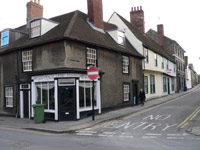
Churchgate and College Streets
|
|
1295
|
In 1992 a survey of 48 and 49 Churchgate Street and 1 College Street in Bury revealed that the whole property
was originally an aisled hall dated to the second half of the 13th century. It has two jetties and is likely to be amongst the earliest known examples of this feature.
Edward I was faced with wars in France and Scotland and holding down the recently conquered Welsh. He summoned his "model parliament" to grant him the taxes needed to run these campaigns.
This was the first time that boroughs, including Bury, were summoned to send representatives to Parliament, alongside the earls and barons. The sheriff of each county was directed to return two knights of the shire for each county and for such boroughs and cities as he might deem suitable, two burgesses or citizens. Thus the sheriffs were the "Returning Officers", and remain so today, in theory.
For the first time this Parliament started to look like a representative assembly. However, after the time of Edward I, Bury was never asked to send burgesses to parliament again until after the charter of 1606. The abbot continued to attend as a Lord Spiritual, but it is likely that he was offended by having to sit with a town burgess in Parliament.
|
|
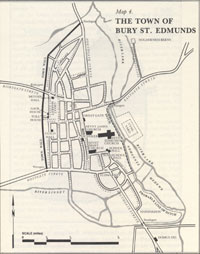
Bury in 1295 by R Gottfried
|
|
blank |
The tax collectors in Suffolk were Peter de Melles and Ralph Bomund, but the king agreed to mend his ways and let the ecclesiastical powers collect it for him where those rights and liberties applied. So the Prior at Bury was allowed to collect this tax in the Liberty of St Edmund.
In 1295 the Royal tax assessment of Bury St Edmunds was drawn up and still survives today. It is called the 1295 Rental and gives a lot of information about property use in the town at this time by tenants of the Abbey.
Robert Gottfried drew this map of the town which includes some of the streets mentioned in the 1295 Rental. However, much of the map is derived from Mary Lobel's map, drawn in 1935, and a few of the names allocated need to be treated with some caution.
There were two suburbs, or areas outside the town walls, and these were called Eastgate and Risbygate. No Mans Meadows were recorded as 31 acres in the South Field, with the income going to the Cellarer. The Cellarer also held Hardwick heath. Nowton Road had two woods, Eastlee and Southlee which belonged to the Sacrist. The Sacrist also had the manor of the Haberden which now had 51½ acres and a mill. This assessment clearly shows that the Great Market was in the Cornhill and Buttermarket areas. It is still there today, but in 1327 the townspeople asked for it to be moved back to its original location, so it is unclear exactly when it moved there. It is possible that it had been held for many years on the Angel Hill, maybe ever since Anselm's town improvements in the 1130's. The reassessed spiritualities and temporalities amounted to £2,071 15s 5d, a heavy burden on the area. The townspeople continued to riot around this time and obstruct the Abbot's bailiffs in protest against the Abbey's control over civic life and business.
|
|
1296
|
In January King Edward I visited the abbey at Bury and treated the monks to a lavish and copious feast at his own expense. He stayed just four days, and set off for the wars in Scotland, where he obtained a total victory. Following the Scottish triumph, the king returned south and he held a Parliament in Bury St Edmunds for three weeks in November, to consider further taxes. Although they tried to keep good personal relations the King and Abbey were becoming caught up in a quarrel over the king's demands for money.
Edward offended the monks by staying in the house of Henry of Lynn, rather than in the abbey as was the invariable custom to date. This may have been because the archbishop was holding a council in the abbey to tell the clergy of a new papal constitution. This papal bull forbade the clergy from paying any taxes to the secular powers without the pope's permission. The king gave them until January to toe the line.
After three weeks the king left Bury for Clare on 29th November, and then to Ipswich for Christmas.
The Bury Chronicle was taken over by a new monk who changed the method of recording dates. The old system was Marianus Scotus's using the date according to the gospels. The new system records the year according to Dionysius and starts at Easter 1296.
|
|
1297
|
Come January, the church still refused to pay the king his due taxes, because of the Pope's new bull. The king withdrew his protection from certain church property to help persuade the clergy, but meanwhile his armies in France suffered a bad defeat in Gascony. Some clergy now decided to pay up, but St Edmund's did not. The king now started to confiscate church property and called a parliament of the laity only, that is to say, excluding the lords spiritual. Thus it was that in February all the goods of the abbot and convent were confiscated, together with St Edmund's borough.
In July, another Parliament was summoned to Lincoln. The earls and barons were now also resisting royal taxation, and wanted the church property to be returned and Magan Carta adhered to by the king. While the king was in France the earls and barons met at Northampton and sent their views to the king abroad. Finally, in return for continued tax levies the new Parliament managed to obtain in return the confirmation of the Great Charter. No new taxes would be imposed without the consent of Parliament. This was the final version of Magna Carta and some small parts of it remain in force today.
Meanwhile Andrew Murray and William Wallace were in open revolt in Scotland and over-ran the north of England.
|
|
1298
|
Wars continued in France, Belgium and Scotland.
The king visited Bury on 9th May, and entertained the convent next day. He was soon on his way north, held a parliament at York, confirmed Magna Carta, and gathered an army for the fight in Scotland. On 22nd July came the battle of Falkirk.
In August the Bury Chronicle recorded the theft of all the cooking utensils in the refectory, together with two pieces of silver and five silver salt cellars. By a sad piece of ill luck, the chronicle said, they had not been locked in the special safe in the evening.
|
|
1299
|
The king paid a visit to Bury. Between 1296 and 1301 Edward I came here six times.
Between 1297 and 1300, William de Westley was granted land "on the Way leading to Chevington".
This is the earliest known reference to Chevington Way, a route from Bury and its Abbey to Chevington and thence on to the south west to Haverhill. This route no longer exists as it has been obliterated by the formation of Ickworth Park, and its closure to traffic. It is an interesting example of how the ancient routes have disappeared over the years.
Chevington Way has also been known as the Abbot's Way in its time. The Way leaves today's A143 at Chedburgh, going straight on to Chevington where today's road turns sharply right to the east at the pub. Leaving Chevington at the Church it entered what is now Ickworth Park at the Iron Gates, in the south west of the park. The Way is now represented by a modern roadway in the Park, and follows the River Linnet along its west side. Here it passed through the village of Ickworth, which was also removed in the formation of the Park. It followed the course of the River Linnet through Westley Bottom to Perry's Barn. Here it picked up what is now Abbot Road, on into Hospital Road, and thence to the West Gate on Westgate Street.
The extinction of Chevington Way, and its replacement by the route of the A143 around the east side of Ickworth Park through Horringer caused Chevington to become a village "off the beaten track" after 1814.
|
|
1300
|
King Edward I, together with his son, stayed at the Bury abbey from 8th to 11th of May, before proceeding to the war in Scotland. The abbey was again on good terms with the king, who dedicated his life to the blessed martyr with deep devotion according to the Bury Chronicle. At the time there was a royal edict forbidding the use of the foreign coins known as kokedones or cocodonis. The king granted the abbot and convent any fines levied in the liberty in respect of this offence, and forbade his justices from violating the privileges of the church in any way. After he left, the king sent back his standards to be touched by all the relics at Bury, and for a special mass to be said over them.
Young Edward stayed on for another nine days, and said he had never enjoyed himself so much as living like a monk. Mind you, much the same thing was recorded at St Albans, but there it was the Queen who was said to be reluctant to leave!
The Bury Chronicle recorded a detailed account of how John de Eversden, the cellarer, secured the title to a pasture called Boughton in the Manor of Warkton, near Northampton. After 1300, the Chronicle became very terse, with only a short entry for 1301, and a long gap to 1313. After this there were only short entries for 1326, 1329, 1334 and 1335.
|
|
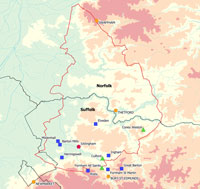
Breckland manors showing obedientiaries |
|
blank |
According to Mark Bailey, by the end of the 13th century the abbey's total income exceeded £3,000 a year. This made it one of the wealthiest and largest monasteries in England, and the largest landlord in Suffolk. The various manors were split between the Officers or Obedientiaries of the Abbey so that they could fulfill their functions. These Officers included the Abbot, Cellarer, Sacrist and Chamberlain.
The Cellarer had to feed the monastic community, and so held lands nearer to the town. These manors included Bradfield, Barton Mills, Cockfield, Elveden, Fornham St Martin, Groton, Herringswell, Horringer, Ingham, Mildenhall, Nowton, Risby, Rougham, Semer, Timworth and Whepstead. There might be up to 80 monks, and perhaps another 250 lay brothers and servants who required to be fed.
During the 14th Century, from 1300 to 1400 Bury St Edmunds had a flourishing fishing industry. Amazingly to us today, the Rivers Linnet and Lark, with the waters at Tay Fen and Babwell Fen, supported large fish populations. These provided employment for fishermen and food for the town and abbey, as well as a means of transport, source of drinking water and a means of waste disposal. Gradually the pressure of the fulling mills and their waste products, and a rise in population pressure would cause a decline in fish production.
Despite the wealth of Bury Abbey, Mark Bailey has shown that the most commercialised parts of England in 1300 were in eastern Norfolk and the Lincolnshire fens. In east Norfolk there were between 13 and 14 people per square mile paying taxes. Suffolk stood in the second quartile with 8 taxpayers per square mile, while the average for the kingdom was 5. About 50% of Suffolk was under the plough, the highest level it had ever been, and a figure never to be achieved again in the future. Suffolk agriculture was mixed, but very intensive. It was commercial farming, with the main cash crops being wheat on the heavier soils and barley on the lighter soils.
Most of Suffolk agriculture was conducted on a series of irregular open fields at this time. Only in north-east Suffolk was there much enclosure, and there it made up about 25% of the land. The open field were farmed in half acre strips. However, there was not the regular three field rotation seen on manors in the Midlands. This small scale strip farming would continue until after the Black death in 1348/49.
East Anglia was also unlike other parts of the country in that the horse outnumbered the oxen as a source of power. By growing surplus grains and harvesting hay, horses could be maintained. In return for this extra cost and trouble, the horse gave twice the speed of the oxen. After ploughing, a horse could also be used for haulage purposes. The two wheeled cart gave local farmers the opportunity to have a haulage business when the horse was not needed on the farm.
By 1300 it is likely that at least one half of the area of Suffolk was under the plough. This is a much higher proportion than in the 20th century. Arable farming dominated the farming sector, and probably dominated the whole economy of the county. The best arable land in Suffolk was valued at almost twice the national average of 4.6 pence per acre, while most of it could raise 6d an acre. Breckland soils were valued at only 3d an acre for arable. However, other products of land unsuited to corn growing could still raise a good income, in many cases, apparently better than the return for arable.
Mark Bailey has attempted to categorise Suffolk land use at this time, together with its leasehold annual value. His analysis is as follows:
- Arable land 50% of Suffolk's surface, leased at 12d to 20d per acre;
- Pastures, commons, greens and verges: 25%;
- Heathland 10%, leased at up to 6 shillings per acre;
- Woodland 5%, cropped at up to 8 shillings per acre;
- Marshland 5%, more details below;
- Meadowland 1%, variable, but making as much as 13/4 per acre at Melton;
- Margin of error 4%.
Although Bailey has not calculated an average value for marshland, it did, in fact have various sources of valuable income. The coastal saltmarshes might include grazing marsh as well as locations for fish traps and weirs. The inland freshwater marshes yielded extensive sources of fish and eels, while peat diggings known as turbaries yielded a major source of fuel throughout East Anglia. Inland marshes were most extensive in the fens of Suffolk, Norfolk and cambridgeshire, but Suffolk also had many valley fens along its rivers. For example, a turbary of 2 acres was recorded at Coney Weston in the 1280s, while Hopton had a 10 acre turbary. These wet marshes could also support domesticated geese as well as wildfowl of many varieties. As well as herons there were bitterns and cranes in good numbers throughout this period. These were all looked on as suitable birds for aristocratic and royal feasts. Reeds and sedge for thatching were also cropped.
In the lands governed by the Abbey of St Edmund, tenants in the vill of Pakenham had the rights of "common pasture and of marsh and turbary" on 400 acres of Pakenham Fen. Elsewhere the manor courts regulated the digging of peat. At Eriswell residents could cut 4,000 turves each per year for their own use. At Brandon thousands of peat turves were sold to outsiders. Lakenheath was owned by the Abbey of Ely, and it delivered 100,000 turves a year to the monastery there. A good peat diggings was worth around £11 to £16 a year.
At Lakenheath again, the fishing rights were leased for £15 a year, worth as much as Lakenheath's land rents. Lakenheath had a big fish market and hot eel pasties were a local speciality. Some 1140 eels would be worth £1.
|
|
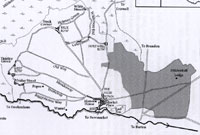
Vill of Mildenhall
|
|
blank |
Mildenhall belonged to the abbey at Bury at this time, and it provided thatching reeds for most of the abbey's local manors. Elsewhere in Mildenhall the the locals had common rights to cut sedge, and they would take it by boat to Ely for sale. In 1348 Mark Bailey found that Lakenheath made almost £6 from the sale of 7,000 bundles of sedge taken from Lakenheath Fens.
Heathland also produced many crops which are disregarded today. The low grade pasture could nevertheless support sheep and rabbits. Breckland had large sheep flocks, of a breed which could thrive on poor pickings. Rabbits had been introduced to East Anglia in the last century, and were kept in Warrens and farmed and protected as a valuable source of good meat and plentiful furs. Gorse was a hot burning fuel, and could also be used to make a dry hedge. Heather was also burned as fuel, but could be used for thatching as well. Bracken is almost unused today, but at this time it was cut for animal bedding, thatching, and could be burnt. It was capable of use for fuelling furnaces for brick making or for pottery kilns. Broom was useful for making brooms as well as for burning. The sand and gravel of the heaths was dug out for use in building projects, while the chalk below might be spread upon the fields as a fertiliser. This would help to reduce the acidity of poorer soils.
Common rights existed on many heaths. Hardwick's tenants could take bracken from the heath, but had to pay 22d a year for the privilege. Westley's tenants could graze a set number of animals on Westley Heath, at fixed times of the year. Any area called a "several", meant that all its rights were reserved to the main landholder, and there were no common rights over it. Westley had 27 acres of several heath and pasture. Barningham had 20 acres of several heathland. Mark Bailey has pointed at that in the 1280s there was a dispute over 120 acres of heathland held by St Saviours Hospital at West Stow. The Hospital was treating this heathland as a Several, but the Blackbourne Hundred jurors claimed that this had always been common to the vill. At Troston there were 20 sokemen who held 20 acres of heath land as tenants.
Heathland resources were so valuable that they were carefully controlled by local manorial courts. Brandon Commoners could cut bracken but not before 25th March, presumably in order to let it get established. Cutting might be banned altogether if stocks were too low. The Lackford court had trouble with enforcing a ban on the use of mattocks for digging out the roots of bracken and gorse. Sheep grazing was rotated to let the gorse, bracken and heather grow back. Elmswell had 7 acres of heath where one acre was cut per year, leaving the rest to grow on. Each acre cut made a harvest worth 18d a year.
The layout and usage of arable farmland in Suffolk did not conform to the classic "Three Field System" of cultivation which prevailed in the Midlands. Open fields in Suffolk were irregular and of varying sizes, with many being small fields enclosed by hedges and ditches. Brandon had eleven fields, Exning had seven, Herringswell had five, and Newmarket had only one field, although a 16th century record for Mildenhall contained mention of about 40 fields. Some Suffolk fields had enclosures within them, let to one or more tenants. One such enclosure at Hinderclay covered 30 acres, with five sub-divisions known as "wents". This name occurred in Bury St Edmunds, with Drovers Went, now located beneath part of the Moreton Hall housing developments. Bailey concluded from this diversity that very little cropping was organised communally in Suffolk. He discerned three generalised categories of arable land within these overall diverse arrangements. He called these: - Irregular commonfield systems with partially regulated cropping;
This most formal system occurred on the poorest and lightest soils like the Breckland and the Sandlings of the coast. But also on the chalky clays of the south west. Individual holdings were small, such as the average at Barnham of 1.25 acres on one manor and 1 acre on the other. Wangford averaged 1.5 acres, Culford had an average of only 2 roods. Grazing rights over stubble and folding obligations over fallow were carefully regulated by the manorial court. (Folding was the obligation to put your sheep to manure the lord's fields.)
- Irregular commonfield systems with non-regulated cropping;
By 1300 this type of arrangement dominated the loams and clays of south, central and eastern Suffolk. In these areas permanent pasture was scarce as these irregular fields probably covered about 75% of the area of the vill. Land parcels tended to be larger, and open fields often had hedged and ditched enclosures within them, usually called "crofts". Fornham All Saints had 12 % of demesne arable in crofts. Folding rights were less important as the arable land had less need of manuring here, and there were few sheep here, anyway.
- Non-common subdivided fields:
Enclosed fields of arable and pasture dominated the heavy clay uplands in the hundreds of Hoxne, Wangford, and west Blything, and some heavy soils south of the River Gipping. These areas had very intensive mixed farming, growing wheat, oats and legumes, with cattle fed on the oats and legumes, and very few sheep.
Henceforward Suffolk farmers would move over to more pastoral farming. Dairy farming was on the rise. A Suffolk cow earned its owner a lactage rent of 6 or 7 shillings, nearly twice the national average. Meadows gradually became worth more than arable land as dairy products earned more money.
In addition, outside the influence of the great abbey at Bury, Bailey estimates that only 10 to 15% of the Suffolk population was made up of the unfree villein class. Villeins had to serve up to three days a week in labour dues to their lord, while the free farmer could follow his own business advantage for the whole week. By contrast, in the Midlands freemen were a minority of the population. About 80% of landowners held ten acres or less, meaning that they had to have an income outside of agriculture. So a culture of crafts, hiring out and sub-contracting was the norm.
This high proportion of Free men was partly due to their population increasing over centuries. This also resulted in land holdings becoming smaller as farms were subdivided between inheriting sons. About three quarters of peasants held plots of under 10 acres, and about half the population lived as landless labourers, servants or town dwellers. Labour was thus cheap and abundant at this time.
By 1300 Suffolk had the highest density of weekly markets and small towns in the country, illustrating the level of trade and commerce carried on. They were all linked together by roads and bridges allowing clothmakers to easily market their wares both locally and abroad. A cart from Sudbury could reach London in 3 to 5 days. A ship from Ipswich could reach the Low Countries in in two days. Larger east flowing rivers like the Stour served to carry cloth to the coast, and the water also served for washing, fulling and dyeing wool. Geography favoured the south of Suffolk for cloth making and commerce.
All these factors help to explain why Mark Bailey suggests that by 1500 Norfolk and Lincolnshire were to be overtaken by the rise of Devon and Suffolk.
At a time when London held perhaps 70 to 100,000 people, Norwich was home to 25,000. Ipswich had a population of 7,000 and Bury St Edmunds had about 6,000 people. Towns like Beccles, Dunwich and Sudbury were smaller, with perhaps 2-3,000 people.
In the century 1300 to 1400 it seems that the climate was much warmer than today. On a global scale the glaciers were melting, resulting in a rise of sea level, to about half a metre higher than it was by about 1987. Coastal erosion accelerated at an alarming rate, destroying some coastal communities, and severely damaging others. In Suffolk, the prosperous port of Dunwich would become the best known casualty, but on the Humber, the port of Ravenspur would suffer the same fate. It is likely that inland the river levels would also tend to rise, as sea level rose.
Dunwich was linked to Bury St Edmunds by an important road known as King John's Highway.
|
|
1301
|
The Chapel of the Charnel was founded in today's Great Churchyard in Bury by the abbot, John de Northwold. There had been so many burials over the years that the cemetery was effectively full up. Abbot John was disturbed by the old bones being "indecently cast forth and left", and so the Charnel House was built to hold the disturbed bones.
Later in 1301 Thomas de Tottington was installed as abbot.
|
|
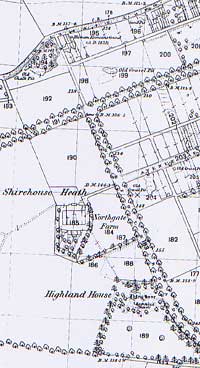
Shirehouse Heath
|
|
blank |
Until 1301, the Royal Assizes were held at Catteshall, a location in the Great Barton area. The Abbot, with his overriding authority within the town, had always ensured that the King's Courts for the Shire, the Assizes and Quarter Sessions were held outside the banleuca. By 1301 these courts were being held at Thingoe Hill, or Henhowe Heath, as it was called then. This was not far from the church of the Friars at Babwell, and when the weather was bad at the new courts, large crowds had sought refuge in the church. The Friars petitioned the king not to let the Hall of Pleas become a permanent fixture at Henhowe Heath. This does not seem to have worked, as the area became called Shirehouse Heath, indicating that it did, indeed, become the home of the Shire House or Hall of Pleas, for the duration of the monastic period. This was made permanent by the King in Parliament in 1305. The name Shirehouse Heath survived on Ordnance Survey maps up to the 1886 edition. After the Dissolution the Shire House moved into town.
|
|
1302
|
M D Lobel states that there is evidence that in 1302, the Mayor and six burgesses of Bury were summoned, along with representatives of 276 other boroughs to attend Parliament. Never again does the Sheriff require Bury to send or 'return' any burgesses to attend Parliament. From this date it no longer seems to have been regarded as one of the true Boroughs.
|
|
1303
|
From this date, it is said, the Abbey began sheep farming on a large scale. Presumably some of the arable land was replaced by sheep walks.
|
|
1305
|
On June 19th of the 33rd year of the reign of Edward I, membrane 20 of the patent rolls record that the following declaration was made at Parliament held at Finden:-
"Grant, after inquisition ad quod damnum made by the sheriff of Suffolk
and in consideration of a fine made in the Chancery by the abbot, to the
abbot and convent of St. Edmunds that pleas within the eight hundreds
and a half which are within the liberty of the abbot shall henceforth be held
in a place called 'Henhowe' near the town of St. Edmunds for the
convenience and use of the justices and other the king's ministers and the
people gathering there, as they used to be held in the place 'Catteshill'."
The townspeople of Bury had continued their resistance to abbey rule. There had been a series of incidents over the last ten years which led the abbot to charge the alderman and burgesses with withholding fines and tolls due to him, and resisting his tax collectors. He also charged some people with stoning the abbey roofs, and harassing workmen carrying out repairs.
The Abbey tried to make the Merchants Guild illegal following a long series of riots through the 35 years of Edward I's reign. Royal officials had to be called in to settle the matter. The court case lasted from August 1304 to January 1305, and the concessions made to the King back in 1266 to avoid punishment were quoted as evidence against many of the town's current claims.
After the judgements in 1305 the town was fined £333 and 50 barrels of wine. The biggest blow was that the Merchant's Guild was judged to be illegal. However, the Royal Commission granted some small alleviation of the Abbey's rigid rule, but it was largely a repeat of the 1292 arrangement. The town was allowed to elect its own Aldermen subject to the Abbot showing no reasonable cause to object to them. The town was also allowed to appoint the Keepers of all the Town Gates except for the East Gate which also controlled the Abbot's Bridge. This small advance did not satisfy either side. Trouble would continue to simmer right up to the great events of 1327.
The Town or Alderman's guild was apparently formally incorporated in Bury in this year. Dedicated to the Virgin Mary, it had been founded in the 12th century. It was mainly political and social in its aims, not promoting any one trade or craft. This may have been an attempt to replace the Merchant's Gild which the court case had declared outlawed.
The Holy See was transferred from Rome to Avignon. Popes were to be French from 1305 up to 1378.
|
|
1306
|
The Abbot had his own gallows at Westley, which for a time served the whole hundred. In 1306 William de Beresford and William Howard burned it down.
The gaol in Bury at this time was fairly dilapidated and in this year William Pugg, imprisoned on a charge of trespass on the abbey's fishponds, broke out. Prisoners were not generally held as a punishment, but as an incentive to make recompense for their crimes by paying compensation or fines. Money could usually buy you out, if you had not committed one of the many capital crimes. The prison usually held debtors who had no money to pay their creditors. The gaoler answered to the Sacrist, who answered to the Abbot. The power to appoint the gaoler did not pass into secular hands in Bury until the 16th century.
|
|
1307
|
Edward II became King and ruled until he was deposed in 1327.
|
|
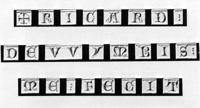
Bradley bell inscription
|
|
1308
|
Great Bradley, near Haverhill, has one of the three oldest church bells known in Suffolk. The oldest is probably at Hadleigh, dated to around 1280. Worlington has a bell made by John Godynge of Lynn, dated to around 1310. The bell at Great Bradley could be a little earlier, and was made by Richard de Wymbis of London. De Wymbis was known to have been working as a bell founder by 1290. The inscription shown here is a cast made from the bell.
|
|
1310
|
By 1300 Suffolk had reached the height of its early importance and prosperity. Ipswich, Norwich and Bury were major towns and many other new market centres had been established. From 1227 to 1310 it has been estimated that 70 new markets appeared in Suffolk. By contrast very few were created after 1350. Suffolk's population had doubled to about 140,000 from about 72,000 in 1066. Farming had become intensive but inheritance laws had divided plots up into many small units of around half an acre. Feudal dues were many and varied, but it is clear that people moved house perhaps further and more often than we have previously thought. The growth was such that a 13th century lawyer, Henry Bracton recommended a rule that markets should not be closer together than six and two thirds miles. In the Liberty of St Edmund, however, they were much more difficult to establish without upsetting the Abbot. Barrow and Ixworth had managed to receive market charters, but were further out than this minimum distance. Almost all other towns had won a measure of self government except those under monastic rule. Obtaining a Charter usually meant freedom from feudal dues, the control of trade in local hands and any tolls going to those who had clubbed together to pay the King for the freedoms enjoyed. Merchants got together in Guilds, regulating their own trade, including prices and entry to the right to trade.
|
|
1313
|
The abbey of St Edmund was in a poor financial state at this time. So much so, that in December 1313, they could only raise cash by mortgaging all the abbey's possessions with the great bankers, the Bardi.
|
|
1314
|
Robert the Bruce defeated the English army and the failure of Edward II's Bannockburn campaign alienated the Barons. He also made grants of land to personal friends which offended the established nobility.
The young Gilbert de Clare, the Earl of Gloucester, was killed at Bannockburn, and the male line of de Clare ended. Gilbert was the son of Joan of Acre. The lands at Clare were apportioned to Elizabeth de Burgh, one of Gilbert's three sisters. Clare was in the hands of the King until the inheritance was settled, and it seems that Elizabeth did not receive full title until 1322.
The mint at Bury was still operating as Roger Rede, its moneyer, recorded that he had coined £22,480 of bullion.
From 1314 the weather turned very wet. Torrential rains would lead to three harvest failures in the next three years.
|
|
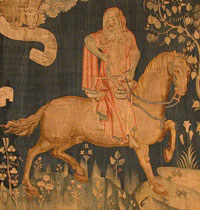
Famine - the 3rd Horseman of the Apocalypse
|
|
1315
|
The harvest failed throughout the Country. Poor and even terrible harvests would characterise the years from 1315 to 1322 to such an extent that some historians called this time the "Agrarian Crisis". Philip Slavin calculated that crop yields were 25% below average in 1315. The town of Bury was fined £200 for taking arms against the Abbot's bailiffs, flogging monks and throwing stones at workmen on the roof of the church.
|
|
1316
|
The harvest failed again and cattle died of disease. The scarcity of grain resulted in a steep rise in prices. Philip Slavin calculated that crop yields were 35% below average in 1316.
Mark Bailey reported that between 1314 and 1316 the prices of wheat, barley and rye sold in Eye market rose by 50%. The price of oats rose by 80% at Eye in the same period.
The next few years would be almost as bad. Bailey also reported a rise in thefts and petty larceny at this time, as shown in court records around Suffolk. The poorest might starve, but people of property also suffered, with many having to sell land or livestock over these years to raise the money to buy food at current high prices.
|
|
1317
|
The year 1317 may be described as a year of great famine throughout England. Philip Slavin calculated that crop yields in 1317 were 14% below average, but this was on top of the catastrophic harvest of 1316 and nearly as bad harvest in 1315.
It had rained heavily and constantly for much of the summer of 1314 and most of 1315 and 1316. This torrential rain, inevitably, caused flooding; crops rotted away and livestock drowned in the waterlogged fields. The result was the Great Famine, which is estimated to have killed at least five per cent, and perhaps much more, of the population of England. The rest of northern Europe suffered a similar or higher death toll.
Philip Slavin's major work on "Experiencing Famine in 14th Century Britain" published in 2019, concluded that, "England may have lost about 15 to 20 percent of her population."
He also wrote that, "The agrarian crisis of 1315–17, known to history as the Great Famine, was one of the most devastating environmental crises to hit Europe within the last two millennia. The impact of this crisis, and the major long-term environmental consequences that followed, thus mark a truly watershed moment in English and indeed European history."
To make matters worse in 1317 and 1318 there was an disease of livestock called murrain, which killed large numbers of farm animals.
|
|
1319
|
As the poor starved, the wealthy, as usual, might choose to help them or to exploit them. At Walsham, Bailey gives the example of William Lene, who, between 1316 and 1319, bought up 33 pieces of land from poorer families forced by circumstances to sell up.
Other wealthy patrons would give food or money to the poor as charity.
|
|
1320
|
William of Hawstead, the keeper of the king's exchange, complained that the mint at St Edmunds was producing more coins than was proper. The mint was under the sacrist's control, and depended upon a grant of the privilege by the crown. The first such grant at Bury was by Edward the Confessor. It would be a valuable source of income for the sacrist.
Times were hard in the abbey at this time, and the Burgesses accused the abbey not only of of usurping the royal right to appoint the warden of St Saviour's hospital, but of keeping it short of funds. They went so far as a petition to Parliament, but the case was wrong on a point of law.
|
|
1321
|
In 1321 and 1322 Bailey gives the example of the Manor of Hinderclay, where wheat worth 60 shillings was distributed as alms to the local population. There was a drought in 1321, making the farming of both cattle and grain very difficult. The lighter marginal lands of the Breckland were particularly hard hit. Some lands west of Bury St Edmunds must have been abandoned in these years.
|
|
1322
|
Both the harvests of 1321 and 1322 were very poor, as the drought continued for its second year. Prices rose in response, and the poorest were again the least able to survive.
At Clare the castle and lands of the manor of Clare finally passed to Elizabeth de Burgh, who was one of the sisters of Gilbert de Clare, who had died in 1314 without a male heir. Elizabeth de Burgh was the widow of John de Burgh, who had died before 1312. Elizabeth then married Theobald of Verdun, who was dead by 1316, when she married Roger D'Amory. Roger was to be declared a rebel by the King, but he died early in 1322. In November, 1322, Elizabeth finally inherited Clare. She was generally called Elizabeth de Burgh, despite her later marriages. Born in 1295, she would survive until 1360, having decided to take a vow of chastity after Roger's death. She was now one of the greatest heiresses in England, and would go on to finance the building of Clare College, Cambridge.
|
|
1323
|
By 1323 things began to improve, as the weather seemed to revert to normal.
In 1190 Abbot Samson had persuaded King Richard to sell the abbey the manor of Mildenhall for 1,000 marks. It had 1,200 acres of arable land in cultivation by this time.
Mark Bailey has pointed out that Mildenhall was the single most valuable manor in Suffolk. In 1323 it contributed £130 in cash to the coffers of the cellarer at St Edmunds abbey in addition to the large quantities of grain, livestock and produce that the abbey enjoyed from it each year.
|
|
1325
|
During the early 1320's drought was widespread and economic disruption caused civil unrest. Many people abandoned the land as farming seemed to fail them. This trend seems to continue in many parts of England, right up to the time of the Black Death. However, Mark Bailey believes that in Suffolk, at least, the worst results must have been avoided. By the 1340s he found that aggregate output in Suffolk reached a highpoint, and thus it must have been in recovery through the 1330s.
However, it is easy to consider that the deprivations and losses resulting from years of famine must have caused large numbers of people to be disaffected from society and the rule of law. These people might be more ready to join the rebellions which would erupt around the succession in 1326.
King Edward II spent Christmas at Bury Abbey. He produced a charter which redefined the the liberties of the abbot, as these had been eroded in the later years of Edward I. No Steward, Marshal or royal Clerk of the Market could now meddle in the borough.
|
|
1326
|
King Edward II had been king since 1307. Edward passed through East Anglia in 1325/6 where he spent his last Christmas and New Year. In January 1326 he was at the manor and palace of the Bishop of Norwich at South Elmham, where he enjoyed an al fresco meal in the park there.
In September 1326 Edward's Queen, Isabella, together with young Prince Edward (later Edward III), and her paramour Roger Mortimer, landed at Walton near Felixstowe with an army to attack the King. Edward II’s half-brother Thomas de Brotherton, earl of Norfolk, went to join Isabella, despite having been appointed to defend the counties of Norfolk, Suffolk, Essex and Hertfordshire against the invaders. Five days after the landing, Isabella and the others arrived at Bury St Edmunds, where she helped herself to £800 to pay her soldiers.
These events presented an opportunity for other groups to rise up, and this happened nationally as well as in St Edmunds town.
|
|
1327
|
In January the country was in turmoil, with chaos and disorder over the possible deposition or abdication of Edward II. One particular uprising took place in Abingdon, another monastic town, and news of this soon reached Bury.
On 14th January
some Londoners met local people in Bury to talk politics. Inevitably all the old grievances of the town against the abbey were aired. Thetford, Cambridge and Ipswich had held royal charters for over a hundred years, and were being governed by their own corporations. In Bury they could not even appoint Gate keepers or their own alderman without the say-so of the Abbot. The town paid tolls and fees to the abbey, and the fruits of their labour were being lost to the town.
A large crowd gathered at the Guildhall and swore on oath to ruin St Edmund's Abbey. There were many complaints to answer. By this time almost all towns had won a measure of self government except at places like St Edmunds, St Albans and Reading where the great local abbeys retained a control of life far greater than any baron or even the King. This was the source of a whole list of demands which the mob tried to extract from the Abbot in a "charter". They wanted the right to freely elect the Alderman, and the right to appoint and control the Gatekeepers of the town and to receive the tronage levied at the gates. Tronage was the duty charged on wool by weight. They also wanted the right to a Guild Merchant restored to them.
One demand was a return of the market place to its former position. The demand that the market should be returned to its old location is curious as it seems to have been on its present site in the Cornhill and Buttermarket areas since at least 1295. It seems even more curious if it really had been here since Abbot Anselm's day in the 1130's as is the traditional view. It may be that this was just a long-held grievance because change was imposed by the abbey, not because of any real desire to revert to an old site.
Next day, the 15th January, about 3,000 people stormed the Abbey gates, attacked the inhabitants and ransacked the legal archives. The Vestry and Treasury were raided and robbed. They blocked all roads to London and threw about 21 monks into jail. Amazingly it is reported that 32 out of the establishment of 80 monks were in the country at the time, on holiday.
By late January the villein rabble rousers were more or less replaced as leaders by the senior burgesses of the town, who wanted to retain some semblance of law and order to protect themselves. They named John de Berton as their Alderman, and contrary to the old agreements, did not submit his name for approval to the abbey. De Berton's first act was to authorise another foray into the abbey to pillage the abbot's personal treasury, as yet untouched. He cancelled all debts owed to the Abbey, and took into his own hands all aspects of municipal government. He took over all the collections at the town gates, and to show he meant business, he set up a Block with headsman and axe in the Great Market.
Meanwhile Edward II was deposed after a rising of the Barons. Edward III took the throne and reigned until 1377. When the Abbot, Richard de Draughton returned from attending Parliament on January 28th he was forced to seal the charter of liberties put to him by the people with the block and axe in full view. An interesting point about this charter was that it was written in French, not the latin of most official papers. The Abbot said he needed to take the Charter to London to get it ratified but as soon as he reached there, he repudiated it before Parliament. When the news reached de Berton, he was furious. He raised the mob again and on February 16th fresh rioting broke out and the abbey was pillaged again. Carts were brought to carry off the loot.
From February to May we have no record of what may have happened.
On May 19th, a new force entered the arena in Bury. The Franciscan Friars from Babwell and the secular priests turned on the abbey. The front doors of the parish churches of St James and St Mary, inlaid and jewelled, were ripped off and carried away. The priests took the jewels as they said, unlike the monks of the abbey, they got no generous stipends or income to live on. Everyone had ganged up on the abbey, and de Burton even asked the friars to take over the shrine of St Edmund. When in May the monks and their servants tried to attack some of the mob, the abbey church was burned in retaliation.
Abbot de Draughton tried to appeal to the Pope, but his messengers were too late. The town's secular priests had already reached Pope John XXII and persuaded him to support the town's position. Through the Summer things rumbled on. Monks were attacked and some left town. The burgesses fortified the town walls. In the country, the Sheriff of Norfolk and Suffolk, Sir Robert Morley, was weakened by the new King's minority.
In the Autumn, de Berton again encouraged the mob to attack the abbey. More buildings were burnt including Bradfield Hall, the King's own residence inside the Abbey. The monks planned to retaliate.
Later records from the Abbey record those buildings which were burnt. Whittingham summarised the various sources thus: "'All the buildings standing in the Abbey Court on the North side, namely, the Stables,
Brewhouse, Bakehouse and Granary ' were burnt in 1327, ' as well as the Almonry
buildings on the other side '. (Incidentally, this gives the sequence of main buildings starting from the
Great Gates.) Another account adds more details in order of time and says ' they first burnt
the great gates of the Abbey with the chamber of the porter, and of the stableman, and the
common stables, the chambers (on the South of the Court) of the cellarer and of his colleague
and of the steward and of his clerk, the brewery, the cowhouse and piggery, the mill,
the bakehouse and hay-house, the abbot's bakehouse '. It mentions the ' corn granary '
as burnt two days later. ' The whole Almonry from the gates of the Great Court together with a pentice for
the distribution for the poor as far as the Hall of Pleas ' was burnt in 1327."
On 18th October the townspeople were at prayer when the monks attempted a counter-coup. They attacked the congregation, resulting in retaliation which nearly destroyed the monastery. During this time the old Gate to the Great Court was destroyed in the rioting. The violence moved into the rest of the Banleuca and beyond. The abbey's barns were raided and the grain stolen. Cattle were rustled and most of the abbot's country estates invaded. Even St Saviour's Hospital suffered £800 in damages.
Another old grievance had been the loss of common land rights as the abbey gained land and extinguished these customs. The sacrist claimed exclusive rights to the 67 acres of pasture at Sexton's Meadows, and this was particularly resented. A ditch was dug across it by the local people at this time to try to retake their old rights.
Suddenly, in November things changed, when Pope John reversed his stance and backed Abbot de Draughton. He excommunicated all the looters except for the 30 richest burgesses, who he hoped to fine. A new Royal Council was set up around the king, and a royal writ issued to the Sheriff to restore order.
The town had set up a commune which had lasted for six months before it was now suppressed.
The Sheriff of Norfolk (and the geldable parts of Suffolk) was called in to restore order, along with John Howard, a prominent landowner. When armed soldiers arrived at Bury the town surrendered without a fight. Sheriff Robert Morley took 30 cartloads of prisoners to trial in Norwich. He also imposed a fine of £14,000 on the burgesses. After the rising, no fewer than thirty-two parish priests were convicted as ringleaders. The town was broke and broken.
The Candlemas Guild had been a religious group until the Great Riot when it became a focus of the anti-monastic faction. It was to develop eventually into the Guildhall Feoffment, but in 1327 it was suppressed, for
its abortive part in trying to obtain a charter of incorporation for the town, thus replacing the Abbot's jurisdiction.
The exact position of these guilds is not known, and the Candlemass Guild and the Alderman's Guild or Town Guild have become confused. Lobel believed that the Alderman's Guild had always existed and at this time had to take over the work of the suppressed Candlemass Guild. Gottfried believes that The Alderman's Guild became called the Candlemas Guild after the 1330's and was never a separate body. Margaret Statham believed that the Guild Merchant was suppressed at this time, and that the Guild of the Purification of our Lady in St James Church, also known as the Candlemass Guild, was definitely newly established at this time. This guild was to be the most powerful, exclusive and wealthiest of the Bury fraternities, however it arose.
Some of the monks had sought refuge at St Benet's at Hulme, in the Norfolk Broads, where they spent their time compiling the Chronica Buriensis, a history of St Edmunds from its foundation up to 1327. It contains quotations from the Bury Chronicle up to 1301.
In 1327 the entire kingdom was levied under a lay subsidy or tax. Although this event may be overshadowed for us in Bury St Edmunds by the momentous revolution of that year, this lay subsidy has left us with important information about the comparative wealth of towns in our area. For every township the collectors listed all the taxpayers by name, together with how much they paid.
The subsidy returns for Suffolk show that Ipswich was now richer than Bury, excluding the wealth of the church and Abbey. Ipswich had 210 assessed names to Bury's 154. Dunwich had sunk to 69 names and Orford had only 35 taxpayers.
As well as their wealth, we can glean something of the source of their wealth from their names. Of the 43 names listed for Lavenham, eleven were occupational. Betterton and Dymond showed that seven of these names were related to cloth manufacture. "Le Webbe" implied weaver, as did "Tixtor". A "Fullon" implied fulling cloth, while "Cissor" was probably a shearman, who cut the nap of the cloth with a pair of large iron shears or scissors. One "Dyer" was probably involved with dying the cloth. At this time one or two names were becoming hereditary, but often the occupation would still dictate the name.
At this time Betterton and Dymond also showed that 43% of textile related names in Suffolk occurred in the hundreds of Babergh and Cosford, which only accounted for 10% of Suffolk's acreage. So it is thought that the well known 15th century cloth towns of Lavenham, Sudbury, Glemsford, Melford, Boxford, Hadleigh, Nayland and Stoke by Nayland may have already been specialising in cloth production as early as this.
|
|
1328
|
John de Berton and Gilbert Barbour, the ringleaders of the 1327 revolt in Bury, escaped from gaol, and took refuge in a house of the Babwell Franciscan Friars. They stayed there from Winter to Summer. Following their enormous fine of £14,000 in 1327 some of the burgesses still refused to knuckle under.
In August the notorious outlaw gang of Thomas Thornham came to Bury to a hero's welcome by townsfolk against the protests of the Abbot, who, naturally, feared the worst. Thornham took over Moyse's Hall, and fought off the abbot's attempts to arrest him. The Abbot retreated to his Manor at Chevington Hall, a moated favourite place of Abbots from Bury. De Berton and Barbour came out of hiding and joined Thornham's band along with another burgess, one Richard Friosel. A
group of them marched on Chevington where they managed to kidnap Abbot Richard de Draughton from his moated country retreat. Today's Chevington Hall Farm is the site of this outrage. It is likely that the Hall was damaged in this assault. Great Horringer Hall was destroyed during the march, as were other local manor houses. After the Abbot was taken, some of the mob returned to Bury up Chevington Way and ransacked the Abbot's palace.
Some of the leadership then smuggled him out to London in a sack, where they moved him from house to house, and seem to have received plenty of help for this desperate manoevre. Apparently on the advice of Haimo Chigwell, a famous London fishseller, they moved de Draughton to Dover and on to Brabant as a hostage against remission of the fine. By now it was winter.
Back in Bury, Thornham and his gang left town in late 1328, and there were more gaol breaks and demonstrations. One group of "criminous clerks" headed for Cambridge, hoping to hide out with the students, but most were recaptured. By December, things had quietened down.
At Dunwich the sea was in the ascendancy. In 1286 Dunwich had suffered severe storm damage to town and harbour. In 1328 an even fiercer storm, causing great loss of life, finally blocked the harbour. The Blyth and Dunwich rivers forced their way to the sea between Walberswick and Southwold. Dunwich went into a slow decline accompanied by further losses to the sea.
|
|
1329
|
By 1329 the Archbishop of Canterbury had excommunicated the abductors of the Abbot of St Edmunds and King Edward III set up four Justices to investigate the kidnapping. One man of dubious reputation called John Cokerel was hanged for harbouring the kidnappers in London, but Haimo Chigwell, also unmasked, managed to use his wealth to buy himself out of trouble. A massive fine of £14,000 was imposed on the town. Abbot de Draughton remained in captivity in Brabant until discovered in April 1329.
The abbot got back to Bury late in 1329 and stayed as abbot until his death in 1334. The fate of the kidnappers de Berton and Barbour is unknown, but there has been a suggestion that de Burton was caught and died in Bury gaol.
Eventually the abbey regained its feudal position but enormous damage had been done to its fabric. This incident may have led to the defences at the abbot's manor house in Chevington being strengthened by a bank as well as the deep moat. The abbey had lost 20 missals, 12 bibles, 20 psalters, 10 journals, and 10 decreters on Canon Law, and many other manuscripts during the sacking of the abbey.
The powerful 4th Earl of Oxford, Hugh de Vere, had obtained a market charter for Lavenham in 1257. In 1329, his descendent, Robert de Vere, the 6th Earl, obtained an exemption from tolls on goods throughout the realm. On both of these occasions the Abbot of St Edmunds had not been in a position to obstruct these changes. This exemption covered all of de Vere's Lavenham manor tenants, allowing them to pass without toll through any towns and markets in England. This gave anyone trading out of Lavenham a great advantage in the country's markets and fairs. They could either sell their goods at lower prices to corner the market, or they could charge market prices at greater profit to themselves. This very likely encouraged an outgoing attitude amongst Lavenham people and gave a boost to the small cloth manufacturers who had been serving a more local market up to this point.
|
|
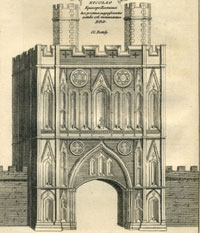 Abbey Gate early 18th century
Abbey Gate early 18th century
|
|
1330
|
From 1330 to 1350
the new Abbey Gateway was built. Margaret Statham has pointed out that it was built some 50 feet out of alignment with Abbeygate Street to replace the gate destroyed in the Great Riot of 1327. She suggested that the previous gateway was retained in action until the new one was finished, and that the older gate had been aligned with Abbeygate Street. That the new gate took twenty years to achieve shows the extent of the damage done to the fabric, power and confidence of the Abbey.
We must imagine that the niches on the Abbey Gate were occupied by statues of holy figures and saints. Although the Gatehouse survives today, the statues have disappeared, presumably during the Dissolution of the abbey.
|
|
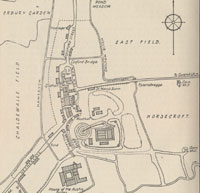
Clare 14th century
by Gladys Thornton
|
|
blank |
In 1330 the estates of the earls of Clare was worth £3,500 a year. The estate was inherited by Elizabeth de Burgh, and she thus became one of England's wealthiest aristocrats. However, only about £450 of her income came from her 8 Suffolk manors and boroughs. Her lands extended across England and Wales. Locally, she held Erbury, Clare, Desning and Hundon. Despite this she set up her main residence at Clare in the shadow of the Norman castle mound there. According to Mark Bailey, half of her entire income was spent on food. Of course this was not just for herself, or even just for her large household. Feasts were frequently given for guests, tenants and local lords, and general hospitality was the normal practice to demonstrate wealth, power and status for all to see. Her household included falconers, tailors, chaplains and goldsmiths, a mixture far beyond what we might expect today. Thirty knights and squires wore her livery, receiving an annual stipend. Her household was directed and run by local knight Sir Andrew de Bures. Lesser local lords were paid a retainer to support the de Burgh interest. An esquire might get £10 a year, while a knight would expect £30.
Clearly the presence of such wealth in Clare must have dominated the local economy.
Her wealth was rivalled in Suffolk only by the Abbey itself. In addition the Abbey and Bishopric of Ely had considerable landholdings in Suffolk. Lakenheath, for example, belonged to the Abbey at Ely, while Brandon, Glemsford, Hartest and Rattlesden belonged to the Bishop of Ely.
Among lay landowners, the Earl of Suffolk held only a handful of manors in the east and north-east of Suffolk, where Ufford, Wingfield and Sutton were the most notable perhaps.
The Earl of Norfolk held more of Suffolk than did the Earl of Suffolk. He held 11 large and important manors in east Suffolk like Staverton and Bungay, as well as the important castle at Framlingham.
At Norwich the population had probably reached 25,000 people. From 1300 to about 1330 the town of Norwich enclosed itself within the extensive walls which can still be seen, in part, today. The explosive growth of that city had generated enough spare cash to afford these grand walls, which were a sign of power and prestige rather more than for defence.
|
|
1331
|
The troubles in Bury from 1327 to 1328 were laid to rest by a peace treaty in 1331. The fine of £14,000 already imposed on the town was agreed to be paid by instalments. It was probably so massive that it was never actually meant to be a payment, but was to stand in abeyance as a surety of future good behaviour. After the first 50 Marks were paid, the town would get a letter of Quittance, relieving them of £10,000. The rest could be raised by the burgesses by taxing the town as they liked. Final discharge of the fine does not seem to have occurred until 1349.
|
|
1334
|
The Lay Subsidy rolls of 1334 throws further light on the non-church wealth of Bury. It was ranked 28th in the Kingdom at an assessment of £360. Great Yarmouth was 6th at £1,000, Norwich was eighth at £946, Lynn was 11th at £770 and Ipswich 14th at £645. Sudbury was assessed at £281. Bury's townspeople seem to have been in a relative decline in the first half of the 14th century. Strong recovery seems to come from about 1360, despite the impact of disease.
In 1334, a Bury monk called Walter of Pinchbeck started work on a register of all the abbey's lands and income, rights and privileges, as perceived by a monk of the abbey. Pinchbeck was a village in Lincolnshire, and Walter will have come from there. This work was probably a result of the recent disturbances, and the need to get the records sorted out. It included lists of tenants and their rents, and is known to us as the Pinchbeck Registers. Walter seems to have died around 1342, bringing his registers to an end.
The year 1334 was the last entry in the Bury Chronicle, which since 1301 had been kept extremely sporadically. It recorded a great storm on St Andrews Eve which "blew down trees, buildings and bell towers." However, it gives no specific examples of this destruction.
|
|
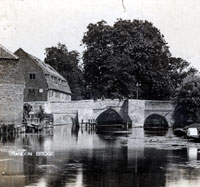
Stone bridge at Brandon
|
|
1335
|
Some time during the 1330s the ninety year old wooden bridge at Brandon Ferry was replaced by a stone bridge. The Bishop of Ely paid out £220 for this new bridge which effectively cut off the navigation to Thetford. Larger trading boats could no longer pass upstream of the bridge and this contributed to Thetford's further decline. At this time there were no specialist inland barges, as these rivers were still open to tidal influences, and coastal craft would routinely penetrate deep inland from Lynn.
|
|
1337
|
Edward III claimed the French throne and thus started the 100 years war. The mayors and burgesses of certain towns were ordered to send representatives to parliament. Although this was an extraordinary meeting, we know that Robert of Eriswell, John Osbern, and Lucas fitzEdmund went there to represent Bury. Although the town had lost much of its status following the judgements after 1327, the burgesses had set up the Candlemas Gild or the Gild of the Purification of our Lady. This became a substitute, or cover, for what would have been the corporation in a normal free borough.
Castle building came into fashion again as times became threatening.
In 1336, King Henry III had granted Orford Castle to Sir Robert d'Ufford. By 1337, he had made him the Earl of Suffolk.
During 1337, Edward III invited Flemish weavers into England to carry on their trade. We lack any evidence for their subsequent presence in south Suffolk, and it may be that this decree had little practical impact on our area. Earlier historians have suggested that Flemish weavers arrived in England at this time and were said to have revitalised the cloth industry. However, in East Anglia they were confined to Norwich and Colchester.
At this time in Suffolk there was very little textile manufacturing being carried on, other than on a very small scale. A few towns had some manufacturing, but these were probably well into the second league of national importance for weaving. Sudbury, Clare, Bury St Edmunds and Lavenham are the only Suffolk towns known to have any cloth making at this date. Suffolk broad cloth production did not increase rapidly until the late 14th and 15th Centuries.
|
|
1340
|
By about 1340 the population of Suffolk was about 225,000, compared to about 100,000 in 1086, according to Mark Bailey's "Medieval Suffolk." This doubling of the population had led to a pressure upon resources, particularly on farm sizes, which had become smaller as numbers rose. Many Suffolk villages were at a peak of population which would be decimated when the Black Death arrived in 1349. It would not be until the 1850s that numbers in most villages would recover to the levels of 1340. Lidgate had more people in 1340 than it would hold in 1801. At Walsham le Willows the 1340 population estimated at 1,250 would not exceed this figure again until 1851.
From 1100 to 1340 most new settlement had to be on the more marginal land, along the edges of greens, and on the wet clay uplands of Suffolk. Expansion on the edge of greens near parish boundaries can be seen in Woolpit, Hopton, Ickworth and Ixworth Thorpe. Cranmer Green at Walsham is another such site, doubling the number of dwellings there in the 13th century, and continuing into the 14th century. In Culford by 1348 it was noted that many residents held fractions of messuages, with cottages squeezed upon them.
During the early 1320's drought was widespread and economic disruption caused civil unrest. Many people abandoned the land as farming seemed to fail them. This trend seems to have been continued in many parts of England, right up to the time of the Black Death. However, Mark Bailey believes that in Suffolk, at least, the worst results must have been avoided. By the 1340s he found that aggregate output in Suffolk reached a highpoint, and this seems to be different from the conditions found by other scholars elswhere in the country.
|
|
1341
|
Despite Bailey's overall conclusion noted above, there were pockets of deprivation in our part of Suffolk. These can be found in the taxation survey made in 1341. In SIAH Volume 20, part 2, (1920), there appeared an article entitled " NONARUM- INQUISITIONES " FOR
SUFFOLK.
BY THE REV. W. A. WICKHAM, AMPTON RECTORY,
BURY ST. EDMUNDS. He wrote that, "the Nonarum Inquisitiones taken in 1341
(14 Ed. III.), (were) about fifty years after the Taxatio, (of 1292) about
two hundred years before the Valor Ecclesisticus (of 1535), and only seven
years before the awful Black Death of 1349, which so
greatly affected Norfolk and Suffolk."
The purpose of the survey was to aid the collection of a new tax or subsidy for King Edward III of one ninth of the corn, wool and lambs in every parish, for two years to pay for the King's wars. Boroughs were to pay a ninth of goods and chattels, although the poor who lived by labouring, were excused.
The survey records much loss of land to the sea at Kessingland, Gorleston and Corton. Although Dunwich still had six parish churches in 1341, it was very depressed as its harbour was destroyed in 1328, along with 400 houses. Church incomes at Dunwich had fallen as a consequence, and so the clergy were also suffering.
Wickham commented that, "The year 1341-2 seems to have been a trying time in rural England.
In Suffolk we do not find many complaints, but the Cambridgeshire returns
are full of them, and so are those from Buckinghamshire and elsewhere.
The winter seems to have been unusually severe. Sheep and lambs perished , and
various crops entirely failed. Some of the tenants were so poor that they
lacked both animals for ploughing and seed corn for sowing their land, and '
there are complaints also of the severity of the taxes. "
One local area which was suffering was at Risbridge Hundred. Wickham again ,
"The Hundred of Risbridge seems to have been (in
parts) in rather a bad way in 1341. In eight out of its
thirty parishes complaints are made,viz., Gayslee,Chedburgh,
Wickhambrook, Multon, Ousden, Depden,
Hawkeden, and Lidgate. In most of 'these parishes
land, once cultivated, was lying idle ("frisce").
At, Gaysley 400 acres were idle owing to the poverty
of the tenants, and the destruction wrought by the
rabbits of the Lord of the Manor, the Earl of Gloucester.
The value of the benefice was thus reduced by
54/4 p.a."
"At Lidgate
things were even worse ; 700 acres were idle. They
belonged to the Manor of Laurence de Hastings, Earl
of Pembroke. These had long lain uncultivated.
The Manor was in the hands of the Lord King during
the minority of the said Lord Laurence and so £6 p.a.
was'lost to the Church, and to the State. Apparently
there were only about 200 acres besides in the parish
in cultivation.
At Wickhambrook the case was
similar. Laurence, Earl of Pembroke, was Lord of
that Manor also, and during his minority the Lord
King had possession of his land, 240 acres of which
was lying " frisce." Had it been sown there would
have been 60s. more for the Nonae."
"At Multon the poverty of the tenants is blamed
for the waste condition of 240 acres, and this may
have been the root of the trouble in other parishes.
At Wyston 120 acres were lying " frisce," apparently
because the land itself was so poor. But in each
•parish there was a loss, more or less serious, to the
Parson, and to the State.
At Bury St. Edmunds they seem to have been in
rather a poor way in 1341, for they complain that
things were not what they were at the time of the
Taxation, " on account of the impoverishment of the
said town."
"The clergy were considerable landowners, and in a
great many of our Suffolk returns their Glebe is mentioned
in detail, and its value per acre. The land is
divided into arable, meadow, pasture, and wood, and
the annual value of each per acre is given. The size
of the estate differed considerably in different parishes,
Pakenham, e.g., had 212 acres of arable, 6 acres of
meadow, and 4 acres of pasture. Gaysley had 80
acres of arable with pasturage for sheep on the common
together with liberty of faldage. Lidgate had 80
acres of arable, 4 acres of meadow, 1 acre of
pasture, and also pasturage over the rabbit warren.
Culford had 30 acres of arable. Ixning had
180 acres of arable. Lavenham had 120 acres of
arable and 16 acres of wood. Timworth, Thurston,
Welnetham Par., Woolpit, Rougham had each 40
acres of arable. Norton had only 20 acres of arable
and 2 acres of meadow. Some parishes had less then
this. These are only specimens picked at random."
A very
common value for arable land was 4d. per acre. The
Elveden and Weststowe arable was worth only 1d.,
and the Brandon 2d. At Ampton and Culford it was
worth 3d., and at Stowmarket and Rougham 6d., at
Hoxne 8d., and at Ixning 14d.
Pasture land was
worth more than arable, and reached 1/- at Lidgate;
Ttddenham, Herringswell, and Mildenhall, and 1/6
at Stowmarket. Meadowland was worth more still,
and reached 2/- at Brandon, 2/8 at Lidgate, 3/- at,
Pakenham and Stowmarket, and 4/- at Norton.
The Norton meadowland must have been particularly good to make this much.
"Before leaving this subject of the land I must
speak of Lakenheath. There the Rector had 80 acres
of arable at 3d. per acre. But the Prior of Ely was
lord of the manor, and he was a very famous man, or
afterwards became so. The jurators swore that he
had some 27 ac. with barley, 200 ac. with white
wheat, 57 ac. with oats, 3 ac. with peas, and that
in the hamlet of Underley he had sown 50 ac.
with wheat and barley, and had 1,000 sheep and
20 lambs, the nonae on which would amount to
£6, and we can imagine the pleasure of the jurators
when they added the words " unde nihil
solvit, nec solvere vult," "He pays nothing, and wont
pay." The Lakenheath Inquisition was taken at
Henhowe, Northgate Road, Bury (where the Shire
Hall stood prior to 1571), on Thursday next before
12th March, 1342."
Other interesting items which Wickham commented upon, included these notes about items which were subject to tithe:
"the teazles grown at Melford and Glemsford,
probably for the use of the Melford and Lavenham
clothworkers."
"" broken wool, to wit ' lokys '
collected at sheep shearing." . It seems a very trifling
item, yet it was tithed, and its tithe brought in as
much as 10/- p.a. at Culford and Livérmere Mag.,
10/4 at Elvedon, and 13/4 at Honington. It is mentioned
in 18 Parishes,of which 8 are in the Hundred of
Blakebourn, 4 in the Hundred of Thedwastre, 4 in the
Hundred of Lackford, and 1 in each of the Hundreds of
Wayneford and Risbridge."
|
|
1342
|
Sir John de Norwich was given a licence to build a castle at Mettingham.
The rise in sea levels since about 1300 had severely affected the coastal communities by this time. In particular, by 1342, Dunwich had lost 400 houses, together with the churches of St Leonard's and St Martin's. A century earlier it had been at the height of its power and prosperity as one of the largest ports in eastern England, perhaps about half the size of London.
|
|
1345
|
A special episcopal commission complained of scandalous immorality among the Benedictine Monasteries of England, and cited St Edmunds as one of the worst offenders. The Abbot, William of Bernham, denied the charges before the Bishop of Norwich, but his protests were rejected. The abbey's reputation was severely tarnished.
|
|
1346
|
However, the civil unrest of the area was to be as nothing compared to the natural disasters of the time. According to the study of tree growth rings, the year 1346 saw a sudden interruption in the growth rate of trees. Little growth took place in the years from 1346 to 1353. Similarly the study of ice cores in the Arctic shows that there was a significant growth in arctic ice formation at this time. Grain yields would fall. All these factors indicate that a climate-changing event may have occurred such as a massive volcanic eruption. Recent studies have shown how the dust cloud from major eruptions can reduce the penetration of sunlight sufficient to have these global effects.
With a weakened population, the disease known as the Black Death broke out in China and would be brought back to the west by merchants and seamen. It may have been a strain of bubonic plague, but its behaviour and symptoms do not appear to be consistent with the disease as it is known today.
|
|
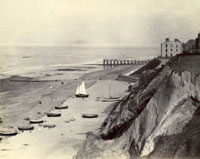
Cromer with Shipden rocks
|
|
1347
|
At Dunwich there had been a major loss of life and property to the sea in 1328. Further major losses were subsequently reported in the storms of 1347, resulting in the destruction of significant property (perhaps as many as 400 houses) in the low lying portions of the city. The decline of the city would continue with losses in 1560 and 1570 such that by 1602 that once major seaport town would be reduced to a quarter of its original size.
Similar losses to the sea were occurring around the East Anglian coastline. One village that completely disappeared was Shipden in Norfolk, located at a site off today's Cromer pier. According to the Norfolk Heritage Explorer website, by 1336 part of the churchyard had been washed away and an acre of land was purchased elsewhere in order to build a new church and churchyard. This land is where Cromer parish church now resides, and Shipden residents had retreated with it. Documents in the Bolingbroke Collection indicate that Shipden's St Peter’s church fell in 1350, but other documentary research states that it was last in use around 1400.
Local tradition holds that Church Rock, located about 150 yards east of the end of the Cromer Pier marks the location of St Peter’s Church, Shipden.
By the end of 1347 the disturbing news was arriving in England that plague had now reached Italy. Even in rural villages like Walsham, the priest had received letters containing the news.
|
|
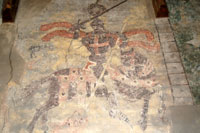
St George at Bradfield Combust
|
|
1348
|
Richard the Lionheart had adopted St George as his personal patron saint during his crusades to the Holy Land.
It was not until 1348, however - just a few months before the catastrophe of the Black Death - that Edward III adopted St George as England's patron. It was probably about 50 years later that this enormous painting appeared on the wall of All Saints church in Bradfield Combust. Little Bradfield came into the possession of the Lords Roos in the 14th century, apparently before the estate became called Bradfield Combust. Although mostly based in the north, they must have had local links, as the commemorative painting is thought to represent the 5th Lord Roos as St George. He died in 1393 in Cyprus on Pilgrimage or Crusade, and is known by his crest of Peacock feathers.
Talk about the spread of the Black Death on the Continent was becoming a major topic of conversation throughout the land.
During the spring of 1348 there were many pilgrimages undertaken across the country. Locally pilgrims travelled to shrines such as Walsingham, the holy well of Our lady at Woolpit, St Etheldreda's at Ely, and St Edmunds at Bury. It was believed that the plague was a scourge from God, and the faithful sought to avoid its effects by making due penance for past sins. People feared that it must be only a matter of a few months before the pestilence crossed the sea into England.
The Great Pestilence or Black Death was first noted in England at Melcombe, now called Weymouth, in Dorset. Weymouth was a great port at this time, and in this year Edward III's fleet sailed from here to lay siege to Calais. Plague may have come over from France with the returning fleet, but dates of reported sickness vary from late June to July. Bristol was infected by August 15th. In September the disease probably reached London, and was well established by November. By the end of 1348 the very wet weather helped the disease to spread.
Robert Gottfried has suggested that in 1347 the population of Bury could have been as high as 7,150, and that a fall of 40% would occur over the next 30 years, due to several epidemics of plague.
This date is sometimes used to mark the end of the Middle Ages and the start of the Late Medieval period. This period runs from 1348 to 1485, the start of the Tudor Dynasty.
|
|
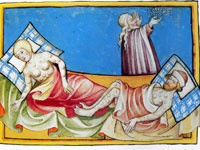
Black Death
|
|
1349
|
The years 1348 and 1349 would fundamentally re-align the development of people's lives in Medieval Suffolk, in a way that the First world War would do so centuries later. The structure of society, the relationships between the classes, and the country's economy, were all turned upside down. and It is believed that between one-third and one half of the country's population were killed by the Black Death. Many monastic houses were virtually wiped out. It was exceptionally severe in St Edmundsbury.
In January 1349 the Black Death arrived in Suffolk, perhaps first appearing at the inland port of Lakenheath, which suffered 20 deaths by February. The disease took four weeks to incubate, and death followed rapidly. Outbreaks now occurred up the Stour valley along the routes out of London. Coastal ports also introduced it into the Waveney valley.
In March the disease reached Bury St Edmunds. People started dying here in April.
By summer 1349 the Black Death was at its height in St Edmund's town. By September 1349, the Black Death had passed but the country was desolated. About 60% of all priests were dead, as were 45 to 50% of tenant farmers. Farms and stock were left to ruin as there was no skilled labour left to manage them. There was little or no normal production as employers were dead and established markets for produce were decimated. Those able to work were, for a time, able to pick and choose employers.
Villages like Depden and Hargrave were so devastated that the survivors seem to have moved the village to a new location, or certain parts of the village were abandoned, while other hamlets survived.
Monastic houses were in disarray and lacked leadership as the experienced monks were less able to resist the illness than the novices. Bury usually had about 80 monks, but in 1349 only 47 remained.
Plague would return on and off to the town for the next 300 years, with the next major outbreak in 1361 in Bury.
In September Abbot John gave a receipt for 50 marks to several important townsmen including Richard Drayton and Ralph Butcher. This receipt seems to have been for the final payment of the massive fine levied on the town for the riots and destruction of 1327 and 1328.
|
|
1350
|
In a desperate attempt to halt the social upheavals caused by new patterns of supply and demand, the Ordinance of Labourers and the Statute of Labourers (1351) were brought in to force people to work for the same wages as two years earlier. These new laws attempted to stop servants leaving their masters without permission to find better paid work, and aimed to fix wages at pre-black death levels. Labourers were bound to fixed term contracts and all able bodied men and women had to give compulsory service. This applied to both free and unfree, under 60 years old, without a trade or sufficient land to support them.
This was probably the first attempt to regulate wages by law, but unlike modern laws on wage rates, it tried to fix the maximum wages that could be paid, rather than the minimum.
Most of Suffolk agriculture was conducted on a series of irregular open fields before this time. The open fields were farmed in half acre strips. This small scale strip farming would now begin to change following the Black Death in 1348/49. Gradually these small plots would now be consolidated into two acre blocks, although in a piecemeal fashion. Blocks would now be enclosed by a hedge and ditch system. Some of these enclosed plots could be converted into pastures. This was the origin of the system which was to become admired in Norfolk and Suffolk by Thomas Tusser in the 16th century.
By 1350 perhaps about 3% of English textile production took place in Suffolk, mainly in the Stour valley, but Bury St Edmunds was also a small centre. After the Black Death, Suffolk textile production would begin to increase. By 1390 it would be producing 6% of the total English output.
Rabbits had been introduced into England, probably on several occasions since Roman times. However, they did not prosper at first. They were considered a delicacy and only the local seigneur had the right to own them. After 1350 there was a growth in rabbit production by landlords. They were kept inside artificial enclosures in special warrens. By the 1380s they would be protected by Warren Lodges, a fortified dwelling and production centre for the Warrener. Rabbit meat was regarded as premium food from 1350 to 1520.
|
|
1351
|
The Pope, Clement VI had to grant Abbot William de Bernham at Bury the right to ordain 10 monks as priests who were under 25 years old. This was due to the shortage of monks due to the Black Death. The prices of abbey crops were falling and the wages for its labourers were under pressure to rise. The abbey's overheads were not restrained in the same way and economic hardship and decline were inevitable until things improved.
|
|
1357
|
The Statute of Labourers was re-enacted showing that the market place for labour could not be governed by laws alone. Grain prices stayed high throughout the 1350s and despite the statute of 1350, wages had risen as well. The cost of bringing in the harvest had doubled in these few years.
|
|
1358
|
Cloth for sale was now attracting a complex series of taxations by the Crown. In October, 1358, two Commissioners were appointed to administer collection of this tax in Essex. The men appointed had to have a good knowledge of textiles in their many forms. Two Lavenham men, William de Lambourne and Alan Hunte were felt qualified to undertake the task.
|
|
1359
|
Sir William de Clopton bought the manor of Hawstead from Sir William de Middilton for £600. This included 200 acres of arable land, 8 acres of meadow, and 12 acres of woodland.
|
|
1360
|
The Statute of Labourers was again re-enacted with more severe penalties for men who were paid more than the legal wage. But landowners without labourers were willing to pay a bit more to hire workers, so it was not just the workers who bid up wages. Serfs wanted to buy themselves out of villeinage in order to sell their labour on the open market. By 1360 the peasants were getting increasingly frustrated. Social inertia was as strong as ever, despite the hard realities of the new economics brought into being by the Black Death. Large landowners tried to carry on as before, while the scarcity of manpower meant that men felt that they could now choose to work for another master who might pay more wages.
Because of the labour shortage women went to work as dairymaids, or brewers, and family incomes improved. However, this also led to a deferral of marriage in some cases. Most of the smaller manors went along with these changes. They began to let the old villein labour dues be replaced by a cash payment, and were willing to let land on lease to tenants rather than farm it themselves in this difficult labour market.
However, the bigger landlords such as the Abbey of St Edmund, clung on to their legal rights tenaciously, demanding all the old labour dues despite the changed situation. They gave no concessions to their tenants, and granted no new leases.
After 1360 the perpendicular style of church building came into vogue, just as the wool wealth became available in Suffolk to exploit it.
|
|
1361
|
There was a further outbreak of the Plague, referred to as the "pestis secunda" which hit Bury in the four months of summer, 1361. Probably another 5% or 10% of the population was killed. Another outbreak would arrive in 1368.
Mark Bailey's analysis of Suffolk subsidy returns gives us some idea of the population decline at this time. In the 1340s Suffolk had a population of about 225,000 people. By 1360 to 1365 this total was only 125,000. By 1520 the population would decrease further to only 100-110,000.
|
|
1362
|
A statute was enacted in 1362 which encouraged the use of English in the law courts. However, the use of French or Anglo - Norman in all forms of written communications would continue throughout the late 14th century and into the early 15th century.
|
|
1363
|
Robert de Eriswell was one of Bury's leading merchants. He became involved in a well known scandal with some royal officials involving the illegal preparation and sale of his wool stocks. There was a tax on the export of wool products, and it was the avoidance of this tax which heightened public interest.
Another Bury man, John Clever, won the right to pay the crown a lump sum, or farm, in return for the right to collect the wool aulnage, the tax levied on exported cloth. Although illegal untaxed exports continued, Clever became rich from his taxation duties.
|
|
1367
|
In 1364 and 1367, the town was petitioning for its rights to be clearly exemplified, and their relationship with the abbey clarified. The settlements of the disputes in 1292 and 1293 were obviously coming into question yet again, with the town no doubt wanting these to be brought into line with modern practices of the time.
|
|
1368
|
In 1368-69 there was a third outbreak of the Plague, called the "pestis tertia". The Black Death was now endemic and would cause problems throughout the 14th and 15th centuries. Outbreaks now continued periodically. The next would come in 1374, but with a reduced death toll. The next major outbreak in Bury would be in 1589.
The Alderman of Bury in this year was Richard Charman, a draper, but also a great property speculator. He lived in the expensive and prestigious Churchgate Street, and managed to raise a large family to adulthood. He became the biggest property owner in Bury, excluding church and abbey holdings. His property was let on short leases to the highest bidder.
|
|
1369
|
A strange crime occurred within the abbey of St Edmund when three monks quarrelled between themselves. John de Norton, John de Grafton and William Blundeston were the three, and one night while everyone slept, Grafton stabbed Norton to death. To avoid scandal the monks buried him in a shallow grave, but Abbot John de Brinkley, discovered it himself. He had them imprisoned, but again oddly the king pardoned them without any trial taking place. The judgement seems to have been that the crime took place in "hot blood", and that this could escape punishment for reasons which we cannot today comprehend.
Since about 1160 the abbey of St Edmund had jurisdiction over the Priory of St George at Thetford. Originally established as a male monastic cell, it was handed over to the nuns from Lyng in Norfolk when the monks had felt compelled to withdraw due to lack of funds. The Prioress had undertaken to be faithful and obedient to the abbot at Bury, and the abbey at Bury had supplied the nunnery with a waggon load of food every week. This cooked meat, 35 loaves of bread and 96 gallons of beer, had been subject to frequent robbery and spoilage en route. So in 1369 the nuns were given money, corn and barley in order to provide for themselves at Thetford. It is thought that between 12 and 20 nuns and their servants lived at St George's by Nunn's Bridges at any one time.
|
|
1370
|
John Wycliffe lived from 1329 to 1384. In 1360 he was forced to leave his post as Master of Balliol College at Oxford for preaching against clerical wealth and privilege, papal authority, confession, transubstantiation, and monasticism.
Wycliffe continued to preach the confiscation of the wealth of the monasteries, by now generally held to be more interested in money making than in religion. John of Gaunt and other nobles supported him because they feared and envied the wealth and power of the church. Wycliffe's followers, known as the Lollards, produced an English version of the bible in the 1390's and in general attacked monastic life and church ritual. Lollard preachers were well received by lesser gentry, yeoman farmers and particularly by the weavers of East Anglia over the rest of the century.
|
|
1371
|
At Lakenheath there was an incident of resistance which occurred when the king's bailiff arrived to collect taxes. About 30 villagers sent him packing. Upon their return they found an even larger crowd of 50 people waiting for them, led by Simon, the local vicar. John de Cavendish and three other armed men descended upon Lakenheath to exact the taxes due. Cavendish was well known as a tax collection enforcer in the area. He was paid a commission on all the unpaid tax he could collect.
|
|
1373
|
Walter Haderby of Suffolk was charged with taking wages of 6d or 8d a day for reaping, and also with inciting other labourers to ask for similar pay. The Statute of Labourers would have fixed the rate at 2d or 3d a day. Higher costs led to a squeeze on farming profits. Land which could earn an entry fine of 50d in 1370, would only make 40d by 1380.
At Melford, there were three manors mentioned in the Domesday Book. The largest was the 1440 acre Melford Manor, which was in the hands of the Abbey at Bury St Edmunds. The local church also held a manor known as Monk's Manor, made up of 240 acres in 1086, but two thirds of it seems to have been given to St Saviour's Hospital in Bury by Abbot Sampson. The third was called Kanewella in 1086, and seems to have been outside the possession of the Abbey. Each manor had dwellings clustered around its heart, Millford or Melford sat on the river crossing, Monks Manor was by the church, and Kanewella around what is now Kentwell Hall.
In 1373 the Manor of Kanewella was also called Lutons, and became the property of Katherine Mylde. In about 1382 she would marry Thomas Clopton, and Kentwell would start a long association with the Clopton family.
|
|
1374
|
The plague once again hit Bury with an epidemic, and the pattern would continue every five to ten years up to the 1420's.
Richard Charman, possibly the richest layman in Bury by now, took over a large mansion in Churchgate Street which reached back to Hog Lane. By now, the cash from his property business was being used to lend extensively about the town. By the 1390's money lending was the biggest part of the family business. Richard died in 1390, but the family wealth lived on.
|
|
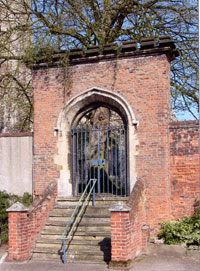
Simon's Gateway at Sudbury
|
|
1375
|
In this year Simon Teobald, Theobald, or Tybalt, also known as Simon of Sudbury, was made Archbishop of Canterbury. Within four years he would be made Chancellor of all England. In 1375 he founded a college for the training of priests at Sudbury in Suffolk. It was built on the site where the Walnut Tree Hospital now stands. The adjacent St Gregory's church was to become the chapel for the College, and a gateway was built to link the two precincts. This gateway is the only surviving relic of the College at Sudbury. Known as Simon's Gateway, it has been restored over the years, but still contains some of the original 14th century bricks. As part of the dissolution of the monasteries it was closed down in 1538.
On the face of it, the advancement of a local man might have engendered some local pride. Simon Theobald was born in Sudbury in 1317, the son of a wealthy local merchant. However, building his new college entailed the demolition of many local dwellings and a disruption of the lives of many ordinary Sudbury people. He was also now in charge of the established church, which many Suffolk people believed to be corrupt. Simon was to become a hated figure in the locality, and was to become a target in the uprising of 1381.
|
|
1377
|
Richard II took the throne and reigned until 1399. As he was very young, John of Gaunt was his Regent, the power behind the young monarch.
In 1377 the first Poll Tax attempted to list all the population over 12 years of age in order to collect the sum of 4 pence a head. This new tax, or subsidy, was to arouse great resentment, but it was to be followed by another levy in 1379 and 1380.
Using the information gathered for this tax levy can cast some light on the population at the time. If everybody in Bury was recorded, and they all paid fourpence, it gives a population total of 2,445 people over twelve. Robert Gottfried has suggested that this can be interpreted as a total population for Bury of 4,200 at this time.
The data from this Poll Tax seems to indicate that Bury was relatively better off than before the Black Death in the 1334 Lay Subsidy rolls. Norwich still led East Anglia at 6th in the country assessed at £65.17.0, followed by Kings Lynn at 9th on £52.2.0. Bury was 15th at £40.15.0, higher than both Yarmouth and Ipswich. Great Yarmouth was now 20th at £30.13.0 while Ipswich was 27th at £24.9.0. New Market also now appears in the rolls at an assessment of £19.12.0. Bury now seems to have regained its place as the leading town of Suffolk, but as this was a flat rate tax, some caution is needed in interpretation.
A new Statute was passed to try to suppress the continued gatherings and demands of the workers. The serfs and villeins responded by organising themselves into a "Great Society". Over the next four years they gradually drew up lists of demands and collected subscriptions to pay fines levied on members. These men had fought in the French Wars and were accustomed to bear weapons. They asked for the abolition of serfdom, commutation of their feudal services at the rate of 4d per acre and the abolition of the statute of Labourers. The poorer parish priests and
friars often supported these movements. Messages passed from village to village and the growing tax burden to finance the French Wars helped convince the villeins that things could not continue. They had managed an increase in living standards since the Black Death, but taxes and the law were trying to push them down again.
|
|
1378
|
In 1378 the church was divided when a second pope was set up in Rome again, the See having moved to Avignon in 1305. The two rival popes caused a split in the church from 1378 to 1417.
The Guildhall at this time was along the Great Market in St Edmund's town. It was owned by the abbey and the guilds paid rent for its use. For most of the last 50 years the Guild and the Abbey had argued over who should maintain it. In 1378 Richard II's advisers were forced to intervene to stop it falling down. The king ordered the Guild members to undertake the repairs needed. Only in the next century would the town guild willingly maintain its own hall.
At Lakenheath, the manor was owned by the abbey of Ely. Like Bury, the Ely monks clung to their old privileges of labour dues and taxes. In 1377 and 1378 Lakenheath suffered a series of events of arson and Ely failed to collect the rents due to the abbey.
In 1378 a monk known as John de Lakenheath began work on reorganising the archives of the abbey of St Edmund. In 1327, the townspeople of Bury St Edmunds had stormed the abbey, plundering its library and archives. Henry Kirkestede had worked to restore the library and Walter Pinchbeck and other monks had been working to replace lost archives in the 1330s. John Lakenheath's efforts would result in a document known as the "Lakenheath Registry". John was described as keeper of the barony (custos baronie), making him responsible for collecting dues and fines for the abbey’s manors and making decisions on their rates. As such, he needed the abbey records as precedent for his decisions, and reconstituting lost records from 1327 probably led to disputes with tenants, and made him a target when violence recurred in 1381.
On December 30th, 1378, John Brynkele, Abbot of the monastery at Bury, died at his house at Elmswell. He was buried in St Mary's chapel within the abbey. There would follow a serious dispute over the appointment of a successor.
One of the monks, Walter Colman, known by his monk's name of Walter de Totyngton, quickly sent an express messenger to Rome, where his friend, Edmund Brounfeld, or Bromfield, was currently living. Brounfeld was a Bury monk, but was in Rome as procurator-general for the the order of Benedictines in England.
|
|
1379
|
In Rome, the Bury monk and proctor-general of the Benedictine order in England, Robert Brounfeld, received the express message informing him of the vacancy for Abbot back home in St Edmunds Bury. He now prevailed upon the Pope to appoint him as Provisor to the post. It had been the custom for the Pope to pre-empt certain church appointments by nominating a provisor in this way. King Richard II was in the process of making Provisors illegal in English church appointments. Nevertheless, Brounfeld headed back to Suffolk with his papal bulls, expecting to take up the post of Abbot at Bury.
Meanwhile the majority of the Bury convent knew nothing of this. The Prior and Convent now asked the king for permission to elect a successor. He granted this, and they managed, after some delay, to appoint John Tymworth, the sub-prior, to the post of Abbot. Two monks left Bury on February 10th to seek the Pope's confirmation of their election. Arriving in Rome on April 4th, they found the Pope evasive and slow to assent. Eventually they found that he had already as good as given the job to Brounfeld.
By the time this news reached Bury, Brounfeld had decided to hide out at the Carmelite's house in Ipswich to await events. He knew that Richard II had outlawed papal provisors in England, but hoped that the abbey and town would unite around him. He sent the papal bulls to Bury to await their reception. One of his supporters attempted to read out the bull in the Chapter House. The Prior asked to read it himself quietly, which was refused. When the Prior tried to adjourn the meeting, there was a scuffle. The Brounfeld supporters then went into town and tried to raise support there.
The abbey at Bury was still hard up, and they now openly split into two factions over the vote for a new abbot. The pope had nominated Edward Bromfeld, and he had considerable support among the convent, but most of the monks wanted John Tymworth, whom they had properly elected themselves. Bromfeld was a Bury monk, but was also connected to some of Bury's leading Burgesses. The alderman, a man called Thomas Halesworth, claimed to be a cousin of Bromfeld and got the Alderman's Guild to support his candidacy. Burgesses who supported Brounfeld included Robert Westbron and John Clakke. But there was also church supporters such as John Smyth, parson of Stansfield, and Walter, parson of Ixworth. Bromfeld was expected to promise major concessions to the town if he got the job of abbot. This idea appealed to the burgesses who bitterly resented the powers exercised by abbot and convent over them.
On October 9th, the mob turned out when incited to do so by the minority of monks who supported Bromfeld. They entered the Abbey church, and read out the Pope's bull appointing Bromfeld. Next day Brounfeld arrived from Ipswich and was installed as abbot by force of numbers. The mob, meanwhile, terrified the rest of the monastery. Gosford reported that 42 monks opposed Brounfeld and only 17 supported him.
On August 4th the bailiffs and alderman of Bury were sent warrants to arrest Bromfeld for being in contempt of the crown and abbey statutes. This had no effect so the Earl of Suffolk and the Earl of March were sent to arrest the lot of them. The court case for riot and attacking the abbey lasted a year, and the townmen were all bound over to keep the peace for substantial sums of money. Brounfeld himself was tried under the statute against Provisors, and was sent to the Tower. He then seems to have been held prisoner in both Nottingham and Corfe Castle. Walter de Totyngton, was also tried and found guilty of inciting the whole incident by his express message to Rome. He, however, was pardoned by the King.
The violence and subsequent court case put pressure on the abbey and forced a delay in appointing Tymworth, which lasted a couple more years. In the meantime, the abbey had to be run by the Prior, John de Cambridge, who was described as a well meaning but inept muddler by Gottfried.
Simon Theobald of Sudbury had been made Archbishop of Canterbury in 1375, and in 1379 he was elevated again to become Chancellor of England. Although this gave him enormous power, it would lead him into personal disaster in 1381. As Chancellor it was his job to raise money for the King through taxation. In 1379 the second poll tax was brought in, only two years since the first poll tax levy. At the time it was known as a subsidy, and was levied at 4 pence per couple or individual, but was graduated so that tradesmen paid between six pence and two shillings. A higher sum was demanded of squires and merchants. This subsidy caused considerable resistance. In Woodbridge two men assaulted the tax collector and gave the taxes back to the people. Constables at Lakenheath refused to pay the common fine because they felt oppressed by the abbey of Ely.
Although Bury and Thetford were inland towns, they both acted as ports, particularly Thetford as it had a bigger river. In 1379 the royal council ordered the two towns to build a ship to be incorporated into the royal navy. This was a feudal duty of the town bailiffs in Bury.
|
|
1380
|
Even the ordinary people were by now willing once again to chance their arm in challenging the power of the abbey at Bury St Edmunds. In 1380 Alice of Hillborough set up a stall in her house and refused to pay the usual market toll. She said that she already paid the abbey its hadgovel or ground rent, on her house, and that covered everything. The abbot sued her and won, but the people were becoming less inclined to accept abbey rights.
A third poll tax was imposed of at least 4d for a labouring family whatever their means. They were due to pay 3 groats but up to 2 groats could be met by richer benefactors of a township. Everybody had to pay the first groat, ie 4d, themselves, and in most cases the full shilling. This subsidy was not graduated in any way, so a labourer paid the same as a knight of the shire. This bore most heavily on the poorest, and it was clearly seen as an attack on the standards of workmen and labourers. Heavy handed methods were used to collect the poll tax, which was levied to pay for the Duke of Buckingham's campaign in Brittany.
Small farmers were suffering from demands for higher wages, which by law they were forbidden to pay. But without labour the harvest could not be gathered. Land entry fines had fallen from 50d per acre in 1370 to 40d per acre in 1380. Incomes already under pressure from these economic forces were stressed to breaking point by these new tax levies, which piled up year after year.
|
|
1381
|
St Edmunds only had 47 monks following years of plague, compared to 80 monks and 21 chaplains in 1260. It looks as if up to half the monks had died from the disease.
The Bury burgesses were in uproar about the size of their punishments over the election for abbot in 1379, which had resulted in a lengthy court case only a few months settled.
Not only that, but the new poll tax was hurting everybody. Resistance to payment led in March 1381 to new laws to enforce payment. The bailiffs of each hundred now had powers to distrain on the goods and chattels of non-payers. In Suffolk it is estimated that about a third of people had refused to pay. Now they could have their property seized and sold at knockdown prices to pay off the tax levy.
Another prime grievance of the people nationally was the hold the manorial lords had over their villein tenants, particularly over their labour services. Villeinage was almost a state of being one of a lower caste in society. If your father was a villein, then you were also a villein by blood, however much you improved your financial situation. In Suffolk at this time it is thought that about half the population were villeins by blood. The other half were referred to as Free men. That is, they were free of the villein's labour services.
All over the country there was discontent, so that the poll tax became just the last straw.
Thus did 1381 become known as the year of the Peasant's Revolt. In modern times it is acknowledged that this was not a revolt of peasants, and is more properly called the Great Rising of 1381. A peasant was a continental class of persons, who were head of their household, but who had no legal right to dispose of the family home, ensuring that it was inherited within the family. Such a class of person did not exist in English law. A villein could dispose of his property, or have it distrained upon, so was not properly called a peasant. In addition, the uprising was led by men who were not from the very bottom tiers of society. Educated clerks and minor churchmen were regularly found among the leaders of gatherings.
In May 1381 villages in South Essex were at the forefront of trouble. On 30th May, John Brampton attempted to collect the poll tax from villagers at Fobbing in Essex. The villagers, led by Thomas Baker, a local landowner, told Brampton that they would give him nothing and he was forced to leave the village empty handed. Robert Belknap (Chief Justice of Common Pleas) was sent to investigate the incident and to punish the offenders. On 2nd June, he was attacked at Brentwood.
On June 12th 1381, the feast of Corpus Christi began. In normal times this was an eight day holiday which usually began demurely enough but always descended into a time of revelry and riot. Despite the minor skirmishes in late May, it seems that Corpus Christi was the designated time for a full scale rebellion to begin. Messages were sent to local organisers; "Now is Time." Large numbers of horses seem to have become available to the rebels, together with carts and baggage, food and supplies. On June 12th not only was there an army entering London, but risings occurred in many other places on the exact same day.
In June, a revolt at Dartford was followed by the storming of Rochester Castle and Canterbury. The Home Counties and East Anglia came out in general revolt. Near Haverhill John Hanchache (or Hanchet) from Shudy Camps, led a group of rebels to attack Cambridge University.
In Liston, near Long Melford, was the home of Sir Richard Lyons, one of the three men who were running the country alongside John of Gaunt. The mob attacked his property, before marching on Bury St Edmunds. But before examining the uprising in Suffolk, we shall review Wat Tyler's march on London, and the sudden end to the rebellion there.
|
|
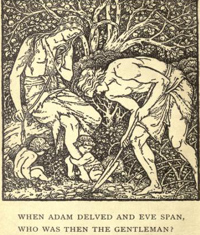
The rebel question |
|
blank |
Two armies from Kent and Essex, led by Wat Tyler and John Ball, marched on London, entering it unopposed on 12th June. When the rebels arrived in Blackheath on June 12, the Lollard priest, John Ball, preached a sermon including the famous question "When Adam delved and Eve span, who was then the gentleman?". In other words he was using the bible to question the established class system of the time.
Ball was a vagrant priest of a type who always seemed to crop up in these revolts of the time. These clerics were outside the church establishment, and were developing their own theology. Gradually this became known as Lollardy.
On June 13th, corpus christi itself, the rebels, encouraged by the sermon, demanded to see the king. Meanwhile the 'Men of Essex' had gathered with Jack Straw at Great Baddow and had marched on London, arriving at Stepney. At this stage there was only a systematic attack on certain properties, many of them associated with John of Gaunt or the Hospitaller Order. By now 60,000 strong, they brought a petition which called for the abolition of serfdom, tithes and the game laws as well as the right to freely use the forests. The rebels also demanded that the poll tax be abolished. Being unable to meet the king, the rebels attacked the prison at Marshalsea and King Richard returned to his mother at the Tower. The rebels plundered Lambeth Palace, burned books and furniture, crossed London Bridge and joined the London mob in the heart of the city. They made their way to Fleet Street, opened the Fleet prison and, plundered what food and drink they could find.
The Savoy Palace, home of the King's uncle, John of Gaunt, was burned to the ground. By the end of June 13th the Tower of London, with the King and his mother inside, was under siege.
Much of this detail comes from the Chronicles of Jean Froissart, a French monk. Another English source is called the Anonimalle Chronicle.
|
|
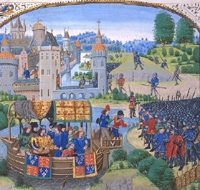
Richard II meets the rebels |
|
blank |
On June 14, King Richard II looked down upon the mob from his room in the Tower and managed to arrange an interview with the rebels at Mile End where, among other concessions, he granted their requests for the abolition of feudal services and their right to rent land at an agreed price. Some of the rebels returned home. But for those who remained near the Tower, violence was about to escalate.
The king had advised Simon of Sudbury, Archbishop of Canterbury and Chancellor, to seize the opportunity to escape. But as he tried to do so Sudbury was recognized by the rebels and the London mob either smashed their way into the Tower, or were let in by sympathisers.
It is said that members of the king's council hid in the Chapel of St John and they were all at prayer before the altar. Here they found Archbishop Simon Sudbury, Sir Robert Hales, the Lord Treasurer, John of Gaunt's physician, and John Legge who had devised the poll tax, and, like Sudbury, was associated with it. Robert de Hales was also Grand Prior of the Knights Hospitallers of England. They were dragged away from the chapel, down the steps and out of the gates onto Tower Hill. On Tower Hill, where traitors were traditionally executed, they were beheaded one after the other. Their four heads were stuck on pikes and carried in triumph around the city.
|
|
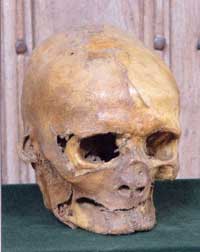
Simon of Sudbury |
|
blank |
Simon Teobald, or Theobald, of Sudbury was born in 1317 in that south Suffolk town, the son of a wealthy local merchant. He rose to become Archbishop of Canterbury in 1375, and Chancellor of England in 1379. After he was beheaded, the head was exhibited on a pole in London, then rescued and his preserved head was taken to St Gregory's in Sudbury. It is still kept in a niche in the Vestry behind a small flap, which can be seen by clicking on the skull shown here. His body was buried in Canterbury Cathedral. Simon had founded a College for Priests in training at Sudbury in 1375. The site is where the Walnut Tree Hospital now stands. The adjacent Church of St Gregory was used as the Chapel for the College.
On 15th June, the following day, the rebels met the King at Smithfield to discuss terms. At the Smithfield conference further concessions were granted the rebels: the estates of the church would be confiscated, all lordships except the kings would be abolished, and all the rebels would be pardoned. Wat Tyler rode up to the king, and his jocular and over familiar attitude apparently made William Walworth, the mayor of London, lose his temper. During the heated exchanges, in which weapons may have been drawn by both sides, Walworth knocked Wat Tyler off his horse with a broadsword and as Wat Tyler lay on the ground Sir Ralph de Standish, one of the king's squires, stabbed him in the stomach, killing him.
The rebel army was apparently unaware of the death of Tyler. The King hastily assured them that all was well and agreed to their demands to avoid retaliation. He told them to meet him again at St Johns Fields, with Tyler.
At St Johns Fields the rebels found that the the King had broken his promises. It was now known that Wat Tyler was dead, and the nobles quickly re-established their control with the help of a hastily organised militia of 7000 men. On July 2nd the King officially revoked all of the charters issued by the rebels, or agreed with them. Most of the rebel leaders were pursued, captured and executed. Wat Tyler's head was cut from his corpse and displayed on London Bridge. Jack Straw was executed and his head displayed on London Bridge. On 15th July, John Ball was hanged, drawn and quartered in the presence of Richard II and his quarters were displayed in four other towns as a warning to other rebels. The promises made to the rebels by Richard II were thoroughly broken although the poll tax was abolished.
Although the main action centred upon London, centres of power all over England had also been affected. All England had been in revolt. It was not just south east of a line from York to Bristol, as has been suggested in the past. There were certainly violent incidents further north as well. Local attacks took place where individual Lords were most hated. Monasteries who had refused to commute the services of villeins, and insisted on ancient rights suffered particularly badly. St Albans Abbey was sacked.
In Edgar Powell's 1896 account of the uprising, he wrote that,
"THE principal leader of the popular party in Suffolk, and,
indeed, it appears a chief mover and leading spirit in the
insurrection throughout the counties of Norfolk, Suffolk,
and Cambridgeshire, was a certain John Wrawe, of Sudbury,
described on the Coram Rege Rolls as a 'capellanus' or
chaplain."
Thomas of Walsingham wrote that John Wrawe had been in London immediately
before the outbreak in Suffolk, in close consultation with
Wat Tyler, the Kentish leader. Judging from subsequent
events, it would appear that they then finally arranged that the outbreak
should be simultaneous, as far as possible, in the districts over
which their organisation extended. After his final consultation with Tyler, Wrawe returned immediately to Suffolk, and, back in East Anglia,
in the town of Sudbury on Wednesday, June 12, 1381, Wrawe intended to call for revolution. The Sudbury History Society believes that on the 12th June a detachment of Essex men led by the priest, John Wrawe, came over Ballingdon Bridge and were met by the Vicar of All Saints, Geoffrey Parfrey and a group of Sudbury men.
They did not hang about, and later on Wednesday the 12th June, they crossed the River Stour, probably at Rod Bridge, and mustered their forces at the tiny village of Liston, in Essex. Liston is between Long Melford and Sudbury, just west of the River Stour, and therefore within the county of Essex. The Manor of Overhall at Liston belonged to Richard Lyons, at various times a wine merchant, tax collector, financier and lender of money to the royal family. Lyons was not liked by the East Anglians as he sat in Parliament for Essex during 1379-80 he had achieved little for his constituents. He was seen as another corrupt minister of the crown. At Bawdsey and Ipswich Lyons was notorious for the manner in which he had collected customs dues. He had collected an extra 20 percent for himself. In 1376, he had been impeached by Parliament for fraud and for other misdemeanours and his goods and land taken away from him, only to be given back to him a little later, aided by his establishment connections.
A massive assembly of men now took place at Liston. Messages were dispatched with a proclamation that John Wrawe was come "to right the grievances of all men". Thomas of Walsingham claimed there were 50,000 rebels. Anominale Chronicle states the lower figure of 10,000, but if they numbered in their thousands, it must be accepted that this had required a great deal of planning and preparation. No spontaneous riot in a tiny village could muster these numbers. John Wrawe and Geoffrey Parfrey of Sudbury, now apparently led the march to Over Hall at Liston, wrecking it and burning all the manorial records held by Richard Lyons. (Lyons himself appears to have been a particular target as he was killed in London on 14th June, 1381.)
Wrawe now sent ten riding men out to all parts of Suffolk on fast horses. John Ridgard has pointed out that such good quality horses were in short supply, again showing the planning behind the revolt. Suffolk men were urged to join the march to be held on Bury St Edmunds abbey, or to meet there on June 14th. As far as we know, nearly all the Suffolk rebels joined this action, rather than the march on London.
On 13th June, the feast of Corpus Christi, Wrawe led 30 men on horses (which now included a squire, Thomas Monchensy of Edwardstone and three priests from Sudbury) to the village of Cavendish beside the Stour about six miles north west of Sudbury. Here they were met by a dyer, Ralph Somerton, who had the keys to the church and proceeded to take the rebels to the belfry where they found that goods belonging to Sir John Cavendish, former Chief Justice to the King and Chancellor of the University of Cambridge, were hidden. Sir John was disliked because he was a man who earned part of his living by enforcing the Statute of Labourers. The main aim of this Statute was to enable an employer to obtain labour at rates which were not to be more than those which had prevailed before the Black Death of 1348. From the belfry they took a silver candlestick, a velvet jacket and other valuables. They voted how to to divide it up. There was no sign of Sir John de Cavendish himself and no damage was done to the church.
Still on the 13th June, they returned to Long Melford, where the whole force had agreed to re-muster. Some of John de Cavendish's money was used to buy a tun of wine from the nearby tavern owned by Onewene, possibly now called the Bull Inn. Holding 4,000 pints of wine, this demonstrates how many men were involved in the encampment.
In East Anglia the leader of the revolt was now generally accepted to be Jack Wrawe, a chaplain from All Saints Church in Sudbury in Suffolk. John, or Jack, Wrawe was the Suffolk equivalent of Jack Straw, now intent upon terrorising the Bury area, seventeen miles to the north. With the long hours of daylight at this time of year, they set off for Bury where they camped outside the town walls at the South Gate.
St Edmund's Abbey was rich and widely resented throughout West Suffolk, which included Sudbury, and since 1332 had been weakened by hard times, plague, scandal and poor rule. On 14th June Jack Wrawe entered Bury and issued a proclamation for the inhabitants to join him or face decapitation. Many needed no such threats, although some would later claim this was their reason for joining. With Wrawe as leaders were Robert Tavell of Lavenham, and John Talmache, esquire. Wrawe was able to lead a combined band of marchers from Melford and Bury townsmen down Cooks Row to the Great Gates of the Abbey. The Prior and several other monks had fled by the time the gates were stormed, as had Sir John Cavendish the king's chief justice. Sir John Cavendish was Lord Chief Justice of England, and had a house in Bury. As one of the chief ministers of the crown, he was a prime target of the rebels. His valuables had already been plundered from Cavendish church tower.
At Bury the Abbacy had been in dispute for 3 years, largely due to the town supporting the minority candidate, Edward Bromfeld, so there was no Abbot, and with no strong leadership, there was no attempt at armed resistance.
The Prior of the Abbey, John de Cambridge, was in charge during the long dispute over the vacancy for Abbot. His town house was the first to be attacked, broken into and ransacked. Having wrecked the prior's house, next John de Cavendish's town house was also pillaged and burnt. Robert Tavell was recorded as looting a valuable silver sword, set with jewels, and worth 100 marks. Not content with this, Wrawe sent out groups of armed men to search for the Prior and Chief Justice.
At the same time Wrawe sent Geoffrey Parfay, vicar of All Saints at Sudbury, to Thetford with a party of 17 men. There they extracted 40 marks in gold under the threat of a visit by Wrawe and the mob. The Mayor of Thetford was Simon Barbour, and together with the Thetford burgesses, they decided to pay up at once.
Other violent incidents occurred that day. Sir Thomas Cornerd, a knight, rode to Stansfield, where he sought out John de Rokewood. A further 5 marks was extracted from him, under the same threat of a visit from Wrawe himself.
Trial evidence shows that Wrawe received both sums of money, less a sum for the expenses of both adventures.
The tumult in the county led Simon Dominyk the vicar of Mildenhall, to lead a band of men to Newmarket to put right a different grievance. Ralph Attwyk had apparently carried off the daughter of Ralph de Walsham of Mildenhall. The Mildenhall men threatened to behead Attwyk unless the girl was returned to her father.
Meanwhile the manhunt for Prior John de Cambridge, and Chief Justice John de Cavendish was in full cry.
Many of these exact details and dates differ between different accounts and have also become confused over the years. The reverend Richard Yates in his history of Bury Abbey in 1805, wrote that John Cavendish had already been dragged to Bury from the village of Cavendish by the rebels, and so was already in custody before being executed in Bury. Some later historians record that Cavendish was caught that day at Icklingham, on the way to Mildenhall, probably making for the London Road, and killed on the spot. It is unfortunate that the trial indictments later taken at Bury have been lost, so some speculative reconstruction of the events is inevitable.
An indictment taken at Mildenhall on June 27th states that Lord Chief Justice Cavendish was apprehended at Lakenheath on June 14th. Knowing that Bury Abbey was under attack, he was apparently making for Ely Abbey. At Lakenheath he hoped to take a ferry across the river towards Ely. One Catherine Gainham, Gamen or Gammon, of Lakenheath recognised Cavendish from his tax collection enforcement days in Lakenheath a decade earlier. She had taken the ferry across the river to gather the hay crop. She released the ferry boat into mid stream to stop Cavendish making use of it. As he waited his pursuers caught up with him and killed him.
Cavendish was seized by John Peddar of Fordham, but killed by Matthew Miller. Others present were John Poter of Somerton, Stephen Martyn and Richard Rond.
At his trial, Wrawe claimed that this death was not due to him, but to Ralph Somerton, a dyer of Bury, and five other townsmen who had set out to catch Cavendish. His head was hacked off and placed on a pike to be taken back in triumph to Bury, and displayed in the Market place.
The abbey Prior, John de Cambridge, had fled Bury on June 13th and spent the night at a house in Mildenhall, hoping to lie low until things settled down. On the 14th he decided that Mildenhall was too dangerous for him, and he tried to head towards Ely. He was turned back by armed men, and in desperation, rode for Newmarket and the road to Cambridge. He took refuge in a wood three miles from Newmarket where he eluded his pursuers for some hours. Leaving the Prior in hiding, his guide set out to obtain provisions back in Mildenhall, but apparently, Once there, his guide betrayed him. Prior John de Cambridge was taken in these woods by the Mildenhall men, and taken on to Newmarket. Overnight they kept him prisoner and taunted him.
On Saturday June 15th he was taken back to Mildenhall where they were met by John Wrawe and the Bury mob, who were much more thirsty for blood than the Mildenhall men. He was taken on to Mildenhall heath where a kangaroo court was held, and he was summarily decapitated. Once again, Wrawe would later say that this deed was done by others, namely Robert Westbrom, Thomas Halesworth and Geoffrey Denham, all three Burgesses of Bury. This accusation was also supported by the Almoner of the abbey, John Gosford, writing in his chronicle. The Prior's head was brought back to Bury and exhibited on a pole next to Cavendish's in such a way as to make Cavendish appear to be whispering in the Prior's ear. The two men had been close friends in life. The two heads would be displayed over the pillory for eight days, until the Earl of Suffolk arrived with his force. Prior John de Cambridge's body was left on Mildenhall Heath until it was recovered by monks on the following Thursday.
Turning now on the monastery again, the mob called for the person of Walter de Totyngton. Walter had wisely disappeared, and so, the mob demanded to see John de Lakenheath, Custos Baroniae. John tried to face them down, but he was attacked and dragged to the market place. His head was hacked off by eight blows, and placed with the others over the pillory.
John of Lakenheath was Custos baroniae, the local Collector of Dues for the abbot's barony. William Yates described him as the Keeper of the Barony, possibly a post later known as the Steward of the Liberty of St Edmund. He collected manorial dues and fines for the abbey, based upon his own Register compiled to replace earlier lost or damged documents. His administrative work had made him a hated figure. Wrawe later attributed this death to another Bury man, Thomas Langham.
Not content with three deaths the mob returned to the abbey to demand two more monks for execution. Hearing that Walter de Totyngton had fled to Rougham, they abandoned that idea and set off after Walter. Somebody claimed to have seen him in the bell tower and after rushing about for a while the mob seems to have quietened down, leaving the two monks unmolested.
On Sunday June 16th, the Burgesses of the town made their own move when they demanded all the charters and muniments held by the abbey which concerned the town. Yet another execution now took place, but the name of the victim is unrecorded, save that he was a friend of the abbey. If the monks did not comply and if their old pre 1327 rights were not restored, then the burgesses said they would not be able to restrain the mob.
Saturday 15th and Sunday 16th June saw an outbreak of rioting across the whole of Suffolk. One particular man, Edmund of Lakenheath, was pursued with such vigour that he had to escape to France. Edmund had manors at Lakenheath, Herringswell, Stoke by Clare and Gislingham. These were all attacked over a period of days, his court rolls burnt, and goods taken. Edmund got away with his life but was held to ransom for 500 marks by a French admiral while making his escape. All in all, Edmund counted his losses at £1,000. He seems to have been persecuted by a band led by James de Bedyngfield, younger son of Sir Peter de Bedyngfield, so himself a man of substance, and by no means of "peasant" class. Bedyngfield was also leader of the gang who threatened William Rous of Denington, who was chief constable of the hundred of Hoxne. From him was extorted the services of the hundred's ten archers, although Bedyngfield promised to pay them 6d a day for their troubles.
At Methwold, John of Gaunt's manor was sacked and his court rolls were destroyed.
In Cambridge the university archives and library were systematically burned on a bonfire. Much of the early history of Cambridge University was lost in this destruction.
At Ipswich Thomas Sampson read out the rebel proclamation, which promised that if the people supported the rebellion, they would gain the following rights. This list included the following:
- An end to villeinage
- Land should be let for less than 4d an acre
- Sheep walks to be abandoned
- Church goods to be confiscated
- There would be only one Bishop for the whole country
- An end to Manor Courts
- No outlawry by legal process
- Everyone to have the right to bear arms
- There would be free contracts of labour
- There would be freedom of markets
- Existing rights of commons, fishing, and hunting to be retained
- All lawyers were to be killed
On Monday June 17th, a covenant was drawn up and signed by the Alderman and the Sacrist in the Guildhall. Abbey charters and records were carted off to the Guildhall, and the monks did not try to resist with violence as they had in 1327. No doubt the executions had showed that Wrawe meant business. The sub-prior was now acting on behalf of the abbey, and he agreed that when Edmund Brounfeld finally became abbot, the convent would grant to the town all its ancient liberties, together with any new demands they might make. Brounfeld's brother was to guarantee Brounfeld's position, while the abbey would pledge its good faith by giving up jewels to the custody of the Guildhall. It was believed that the London mob had forced the king to release Brounfeld, who was still in prison for breaking the law against Provisors.
On Tuesday June 18th, the monks at Bury St Edmunds were presented with more demands for documents and they handed over £10,000 in jewels and valuable relics as a surety. They agreed that the old charter of 1327 should be reinstated. It had been repudiated by the abbey in 1331. News that Norwich had been plundered by the forces of Geoffrey Litster and Sir Roger Bacon the day before must have strengthened the rebels and further weakened the resolve of the monks. Litster had been declared "King of the Commons" for Norfolk. They would not yet have heard that on that very day, June 18th, Sir Roger Bacon had marched on Great Yarmouth, and torn its charter into two halves. One half was sent to Litster and the other half to John Wrawe.
According to Chronicon Angliae, at some point, John Wrawe was acclaimed "king of the commons" for Suffolk. Wrawe refused on the grounds that his chaplain's tonsure was already his crown. He advised the mob to acclaim Robert Westbroun "king" instead. Charles Oman dismissed this report as idle talk, but there is other evidence that the rebels intended to elect shire kings to replace the structure of lords and sheriffs.
Meanwhile in London, Watt Tyler had been killed three days earlier, and the rebels were being rounded up. However well things had gone for the rebels at Bury and St Albans, and other provincial towns, the main ringleaders were under arrest in London.
As soon as the king regained his power he repudiated his promises made at Smithfield, and his army proceeded on a bloody progress to regain control of the country. By July the Peasant's Revolt would be completely put down.
Henry de Spencer, the Bishop of Norwich, was at Burleigh House, near Stamford in Rutland county when he heard news of the troubles. As more news arrived he realised that much of East Anglia was up in arms. His retinue was only eight lances and a few archers, but he set out to return to his diocese. At Peterborough he raised more men and drove the rebels out of the abbey there. He restored order by the sword and gibbet. By June 18th he recaptured Ramsey Abbey, where he caught Robert Tavell, one of John Wrawe's deputies.
Next he led his force to Cambridge, where he beheaded John Hanchach and some others, imprisoned others, and took oaths of peace from the rest. The university was given many new privileges in order to punish the town. This was probably on the 19th June.
Possibly around 20th to 22nd June Despencer then took his force through Newmarket and along the old road to Thetford, which crossed the River Lark at Temple Bridge in Icklingham. John Capgrave recorded that when the Bishop came to Icklingham, at a spot where a mill somewhat narrowed the roadway, between Cambridge and Thetford, he met Sir William Morley and another knight named Sir John Brewes. These men were accompanied by three rebels named Sceth, Trunch and Cubith. This party was a deputation sent from Geoffrey Litster in Norwich to request the king to grant a charter of manumission for all Norfolk. This would have meant freedom for all the villeins in that county, and a pardon for the rebels. To help the king make his decision, they were to give him all the money they had extorted in Norwich. The two knights had been held hostage by Litster when he seized Norwich, and were sent to London to give a respectable air to the petition. These two knights managed to talk themselves out of immediate trouble, and the three others were beheaded. The English Chronicle says this took place by the roadside and their heads were sent back to Newmarket for display over the pillory. Another account says that, taking them with the army on to Norwich, the Bishop had them beheaded at Wymondham. Meanwhile on the 19th, 20th and 21st June Litster was still wreaking havoc in the area between Norwich and the sea.
On 23rd June, 1381, part of the royal army arrived at Bury from London. William Ufford, the Earl of Suffolk arrived with 50 lances. Gosford's chronicle puts the number at 500 lances. Ufford had already had to flee the rebels when they attacked him on one of his Norfolk manors. He had fled to St Albans, but was now back to seek revenge. Wrawe made no attempt to fight, but tried too hide himself. The burgesses of Bury promptly turned their backs on John Wrawe and handed him over. By this time about 20 people had now been killed by the rebels in Suffolk.
It seems that rebellion melted away in our area when faced with this force, and within three or four days William of Ufford, the Earl of Suffolk, was hearing pleas of the crown in western Suffolk. He was at Mildenhall on the 27th June and at Bury on the 28th. While trying the rioters at Bury on the 28th his own manor house at Hollesley was being ransacked by John Northern of Bawdsey, and his manorial court rolls were taken and burnt. Other attacks were also still taking place on the Suffolk coast while west Suffolk was under martial law.
Leaders of the rising, like John Wrawe, were taken for trial in London. Wrawe himself turned King's evidence and made the prosecution case against many of his followers. Eventually, following an elaborate trial in London, Wrawe would be hanged, drawn and quartered as a traitor in May 1382. Nevertheless there was still passive resistance. The alderman of Bury St Edmunds hung on to the abbey's jewels for 16 weeks despite the demands of the Earl of Suffolk. For another 14 weeks the burgesses of Bury kept the abbey documents. The alderman and burgesses tried to plead that they had not begun the rebellion and that they could not be blamed for the chaos that followed.
When Bishop Despencer reached Norwich, he found that Litster and his force had retreated to a defensive position at North Walsham, with a ditch and palisades. His force having now grown in strength, the Bishop followed them there and launched an immediate frontal assault.
Final defeat for the revolt in East Anglia was thus inflicted at North Walsham by forces led by Henry Despencer, the Bishop of Norwich. The Norfolk rebels were led by Geoffrey Lister or Litster, a Norwich dyer. The Bishop had him hanged, beheaded and quartered straight away. His deputy seems to have been a knight, Sir Roger Bacon of Baconsthorpe, but he eventually received a royal pardon. Edgar Powell concluded that the battle at North Walsham took place on the 22nd or 23rd of June. Sir Charles Oman reckoned that it was on or after 24th June.
After the army's summary justice, followed the judicial retribution. In August Commissions were sent out to the Sheriffs of affected areas to gather the names of the rebels. Lists were drawn up of the principal leaders. The list for London contained 152 names, but Suffolk's list was the 3rd longest, containing 20 names. The lists were soon ready, and the crown established a panel or jury of eight men to use the list in Suffolk as a basis for indictments and trial.
The Suffolk list of twenty names is contained in the Parliament Rolls, Volume 3, page iii. They were:
- John Wrawe, capellanus. (chaplain)
- John Talmage. (or Tollemache, an esquire)
- Galfrid Denham. (Burgess at Bury)
- John Clack of St Edmunds. (labourer, villein of Drinkstone)
- Robert de Westbrom of St Edmunds. (mercer or wool merchant, appointed 'King' of Suffolk)
- John Cartere alias Robert Warner.
- Robert Sad of St Edmunds.
- William Benyngton of Bumpstead. (in Essex)
- Galfrid Parfay, vicar of All Saints Church in Sudbury.
- John Wrawe, formerly parson of Ringsfield Church. (Unclear if this is another Wrawe, or an error of repetition)
- Edmund Barbour of Beccles.
- John Batisford, parson of Bucklesham Church.
- Thomas Sampson. (later pleaded he was forced to act as a leader)
- John le Dene, peddere. (ie a peddlar. He was a chapman who sold packets of spices)
- James de Bedingfield. (Of knightly class)
- Robert Prior of Mendlesham.
- Thomas Halsworth of St Edmunds. (Burgess)
- Thomas Yoxford of St Edmunds. (Burgess)
- Thomas Undirwode of Finchingfield. (in Essex)
- ??? Botemor
Inclusion on this list of ring leaders did not guarantee a death sentence. Neither were some of the eventually executed Suffolk men to be found on the list.
Executions known to have been held in Suffolk were as follows:
- Executed at Bury St Edmunds
- George de Dunsby, one of the Messengers of the Great Society
- John Wright
- Executed at Mildenhall
- John Potter, a fuller from Somersham
- Executed at Hadleigh
- Executed at Sudbury
- Thomas Fuller of Bures
- Nick Roper of Sudbury
- Adam Bray of Sudbury
- William Pickard of Sudbury
On November 3rd Parliament was called to Westminster. It was considered that all serious danger of rebellion was now over. The sitting began on November 13th for one month. Their first act was to indemnify Bishop Despencer and all other agents of the crown who dispensed death to the rebels without process of law during the uprising.
Eventually the Commons asked the king to declare a national amnesty for all rebels except for their leaders. This was declared on 14th December, 1381. Of the 287 rebels personally excluded from amnesty there were 18 men of Suffolk specifically excluded. The Commons also suggested to the king that six towns should be specifically excluded from the amnesty. These were St Edmundsbury, Canterbury, Beverley,
Scarborough, Bridgewater and Cambridge. The king did not accept the whole list, and all but St Edmundsbury were allowed to buy a royal pardon by way of a heavy fine. Parliament rolls stated, "The king excludes the burgesses of Bury from his grace, because of their outrageous and horrible misdeeds, long continued, and will not have them share in the general pardon, nor take part in it." This left the inhabitants of Bury in a state of outlawry, an impossible legal position, which was not adjusted until the following year.
Geoffrey or Galfrid Denham, esquire, was included on the first list of Suffolk ringleaders, as shown above, but he escaped execution. However, he was not pardoned until 1388, but only in return for contributing to the Bury town general fine. Hervey of Lackford was pardoned in March 1384. John Clack was pardoned on 6th June 1385. Robert Westbrom was also excluded from the pardon of 1381, but seems to have been pardoned in January 1383. He was apparently still causing trouble in Bury's borough court in 1399.
The 1327 charter was yet again revoked as the monks said it was exacted under duress.
|
|
1382
|
After the Christmas recess, Parliament resumed its sitting on January 27th until February 25th, 1382.
In an attempt to suppress the ideas raised by John Ball which had helped to provoke the uprising in 1381, an act of parliament was passed to outlaw heretical preachers and their teachings. Such ideas were described as destructive of the laws and the estate of holy church.
So strong was popular support for Lollards that Parliament eventually forced the king to withdraw the law passed to help the arrest of heretics.
John Wrawe, the man blamed for much of the destruction in Suffolk in June 1381, was finally executed on Friday 23rd May, 1382.
A new Poll Tax was levied, but in view of the poverty of the country, it was imposed solely upon landowners.
The town of Bury had been in a precarious position since being excluded from the amnesty of December, 1381. During 1382 the town was pardoned in return for a fine levied on the town of 2,000 Marks, of which 500 marks was to be allocated to the abbey as compensation.Of the six towns originally indicted, this left only Bury St Edmunds to face a heavy financial penalty because it was considered to be the worst case of rebellion in the country.
Not all the money could be raised at once,so the main burgesses at Bury were told to appoint a 24 man commission under the alderman to collect the money. As usual, they tried to squeeze it all out of the less well off and less influential of their fellow townspeople. The poor appealed to the King's Sergeant for relief and he had to send in two bailiffs to enforce some sort of fair play. Even two of the 24 commissioners were so outraged that they supported the lesser folk's demands.
John of Lydgate was taken into the almonry school of the abbey at Bury, as a young boy of about 12 years old. He would become a monk by 1389, and then one of the greatest poets of the next century.
By 1382 the old Manor of Kanewella at Long Melford was now called the manor of Lutons, and was the property of Katherine Mylde. In about 1382 she married Thomas Clopton, and Kentwell Manor, as it is now called, started a long association with the Clopton family. Thomas Clopton died a year later, but left Katherine with a son, William Clopton. He died in 1446 but by then he would build a whole new section on Melford Church, now called the Kentwell Aisle.
|
|
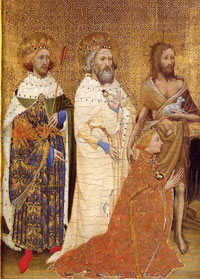
St Edmund, St Edward and St John
|
|
1383
|
King Richard II made a pilgrimage to Walsingham to visit the shrine to the Blessed Virgin Mary. On the way he also visited the shrine of St Edmund at Bury. He adopted St Edmund as one of his personal royal patron saints, along with St Edward the Confessor and St John the Baptist. These saints would feature in the famous Wilton Diptych, or two panelled portable alterpiece produced for King Richard II's personal use in around 1395. St George was much more popular on the Continent than in England at this time, although he was gradually later adopted as the sole patron saint of the country.
King Richard II and his Queen spent 10 days at the Abbey of St Edmunds, costing the Abbey over 800 marks.
The collection of the fine levied on the town of Bury for their part in the Peasants Revolt was still being extracted from the people. The distribution of the burden continued to be a source of complaint.
Things got worse when a new abbot, John Tymworth, was installed as he demanded the customary 100 marks from the town upon his inauguration. The king had to intervene to ensure that the better off also took a share of the load. Collection seems to have taken several years, well into 1385 or 1386.
There is some evidence that after the rising of 1381, and its subsequent repression, that the abbey of St Edmund exerted its manorial rights with renewed vigour. Edgar Powell quotes the manor of Barton Parva, whose income was owned by the Cellarer of the abbey. The court rolls show a small manor within it was held by Sir John Shardelow. He was a knight and chivaler who had to render service of 15 precariae each autumn. One precarious was a day's work, which the tenants of some Manors were bound to give the Lord at Harvest time. William R. Long writes "Why these days are called a precariae is not altogether certain unless by not doing the work one could get thrown off the land- i.e., one's tenure would be precarious."
Service at harvest time was one of the old labour dues which villeins had to suffer. Sir John had failed to provide this service for 30 years. Hitherto the matter had been noted that a fine was due, and no further action taken. In 1383 the Cellarer decided to distrain upon Shardelow's goods. Two of his horses were seized and he was ordered to pay 28 years of arrears. The rolls end at this point so the outcome is unclear, but the continued enforcement of such rights was the type of grievance which had led to the revolt in 1381.
|
|
1384
|
John Wycliffe died. He had been leader of the Lollards and had demanded religious reform.
At Bury the burgesses had still not yet paid off the last of their fine of 2,000 marks arising from the rebellion of 1381. They were now compelled to put up a pledge that they would never again engage in sedition. This pledge or bail was set at the enormous sum of £10,000, more than the value of the whole town. A list of 722 names were made personally responsible for this pledge, probably every householder in the town.
|
|
1385
|
Michael de la Pole was created Earl of Suffolk and was given permission to build a castle at Wingfield.
King Richard II sent a command to Abbot John of Timworth, to appear with all his household from the Abbey of St Edmund, to defend the Suffolk coast against French raiders. This feudal obligation arose as lord of the manor of Elmswell. The call was repeated in 1386, and the Abbot either had to attend or could hire merceneries, or could pay a scutage fee to avoid the duty. The abbots never failed to meet these obligations to the king.
Edgar Powell cited an example from 1385 where a group of villeins had banded together to resist the feudal labour dues which were exacted from them. The group were from the Manor of Littlehawe in Thurston, near Bury, whose lord was Robert de Ashfield. The case against them was heard at the Ipswich assizes. Villeins in this case were referred to as "natives by blood". They were advised by Robert, the parson of Thurston church, and there were 15 men in all involved. Part of the case against them was that they had taken illegal oaths to resist the lord's claims. Such oaths made them into a club or conventicle, and paying a subscription to such a conventicle was also unlawful. Their claim to be free men was not upheld and they were judged to be "nativi" or natives, a state which is also known as villeinage. Their fines amounted to £3, a considerable sum.
The dues listed in respect of one Robert Soutere of Thurston are an example of what was normal for a villein at the time. Soutere held 24 acres and two buildings, for which he paid the usual 4d per acre per year. He was one of the better off men of the group, but, being a "native by blood", he also had to pay the following:
- An additional 1d per acre under an ancient custom called "le unyeld"
- Three hens to the Lord at Christmas
- Fifteen eggs to the Lord at Easter
- Two day's ploughing a year for the Lord
- Four half days mowing grass
- Haymaking with the help of other customaries
- Two half day's hoeing
- Six days reaping each Autumn
- If he had a horse and cart, one day carrying corn
- If a son or daughter married a fine was due
- Upon death his tenement was subject to a heriot of a better beast
- Upon death his heir had to pay a fine upon entry to the tenancy
-
When it was his turn, he must act as head reaper for the lord. (Propositus and Messor)
It was little wonder that villeins tried to resist such requirements, which a free man was never asked to provide.
|
|
1386
|
In Bury the Burgesses had finally paid off the last of their fine of 2,000 marks in January 1386. This may have led to the pledge of £10,000 for good behaviour also being extinguished. Apparently the financial burden had been so great that a few people had given up their tenements, alienated their goods, and moved to Norwich or Colchester to avoid payment.
No further attempts were made to change the established order in the town by violent action after this time. After this time the town gradually got richer from trade and industry, and legal action rather than violence became the instrument of conflict. In other cases privileges or rights could be bought from the abbey as people got better off.
However, villeinage was still a major grievance in the villages. South east of Bury at Norton, Tostock and two other villages, a march against villeinage was held.
|
|
1387
|
Goeffrey Chaucer began his "Canterbury Tales". Chaucer is today acknowledged as a great writer of the English language, and it is his use of English, as opposed to French or Anglo-Norman, which established the English language as a respectable medium for written communications. Nobody before Chaucer had dared to use English for any form of literary expression.
Around 1382, a young man called John, from the village of Lydgate, had joined the abbey at Bury as a schoolboy. He would become ordained in 1389, and during his time as a monk at Bury, up to 1449, he was to continue this use of English, and by his vast output of books on a wide range of topics, from the most mundane domestic advice to high poetry, would consolidate the use of English as the norm for the new generation.
|
|
1388
|
Needham Market was a prosperous industrial and market town in the terms of 1388, with weaving and wool combing sheds. John Betts led an uprising here in 1388. The town's main road was barricaded off to prevent the Sheriff's men from entering to put a stop to the disturbances. Clearly the revolts of 1381 were still inspiring civil disobedience as a means of airing the grievances of the working classes.
In another attempt to control such uprisings a new law is passed which prevented a servant or a labourer from wearing a sword or a buckler, or a dagger. In an attempt to prevent riotous assembly they were also forbidden to engage in unlawful games. It was not unusual for the lower orders to carry a basilard or dagger of about 12 to 15 inches, when they felt it necessary. Swords and pikes were only available to more well off classes. The buckler was a round shield, but it carried a metal boss. Men called buckler players would demonstrate how to use the buckler as an effective attacking weapon, as well as a defensive shield. Such displays now came under the heading of unlawful games. The continued right to bear arms had been a demand of the 1381 rebels.
|
|
1389
|
William of Cratfield became the new Abbot at Bury. He would rule the abbey until 1414.
Richard II issued an order that all guilds and fraternities must submit accounts to the crown. Seventeen returns were made for Bury St Edmunds, out of 39 for all Suffolk and 507 for all England. The order seems to have covered those guilds not primarily related to trades and crafts. They had to quote their main duties, and the Alderman's Guild gave theirs as Maintaining the Guildhall. They were dedicated to the Virgin Mary, incorporated in 1305, and also seem to have been known as the Candlemas Guild at this time.
The other guilds gave their duties as providing lights in their church or providing masses or funerals for members, or to honour their patron saint. The other fraternities were two called Corpus Christi, St Ann's, St Christopher's, St Mary's, The Passion of St Edmund, St Edmund's, St George's, St James's, two called St John the Baptist's, St Margaret's, St Mary Magdalene's, St Nicholas's and St Peter's. Most were formally incorporated in the 14th century, although St Mary Magdalene and St Nicholas were first recorded in 1282.
St Nicholas's Guild was also known as the Dusse, Douse or Douze Guild at various times. This name seems to derive from its guild council fixed at twelve members. The Dusse had wide charitable functions but also cared for the needs of the alien merchants who came into Bury. It also maintained a college in Songschool Street, which was located at the east end of St Mary's Church. The Grammar School was located further east, on the site of today's Shire Hall. This part of Raingate Street was then also known as Schoolhall Street.
The first guild of corpus christi had a very large and diverse membership. It had low entry fees, and drew so many members from humbler classes that a second Corpus Christi was founded at St Mary's church. The Alderman's guild and the Dusse guild were more costly to join and membership was a sign of prestige, but the charitable duties were also extensive. Many people would routinely be members of more than one fraternity.
Guilds also existed by the 15th century in villages like Clare and Chevington, but there were no returns from either place in 1389. Both places had Guildhalls and Clare later had several guilds. At Chevington the Gild of St John the Baptist may not yet have come into existence, but the Guildhall there is now known as Church Cottage.
Glemsford made a return which seems to show a curious link with the abbey of St Edmund at Bury, recorded by the Reverend Glass in his 1962 publication, "A Short History of Glemsford." An extract follows:
"In the year 1870 about 300 old documents were found lying in the Government Archives, which upon examination proved to be the official reports sent back in answer to a Royal Inquiry made in 1389 in the reign of Richard II. This enquiry was made to obtain information about the Medieval Gilds and the documents have been translated and arranged by the Revd. H.P, Westlake. They show that one of the earliest Gilds in England was formed in Glemsford about the year 1020 A.D. It was known as the Fraternity of the Clerks of Glemsford, also as the Dusse Song School, the Assembly of Twelve or the Congregation of Glemsford. The reply to the Royal Enquiry sent by Glemsford men in 1389 was as follows.
"CNUTUS. (Canute),
"In the time of King Canute faithful Christians then existing, with the counsel and help and licence of that most pious king, began it and handed it down to our brethren and to us. And from the time of William the father and William the son, and the most wise and prudent King Henry has been kept with great diligence and reverence, and to the end of the world will, by God's gift, be observed and kept for the benefit of all the saints of God, living and dead".
This amazing testimony so surprisingly brought from the past is documentary evidence of one of the most ancient Gilds recorded in existence in the year 1389 and obviously proud of its long history of three and a half centuries at that date, and all this 600 years ago.
The Gild referred to above is the Fraternity of the Clerks of Glemsford and it appears that they were formed by King Canute to provide priests to carry out certain specified duties at his new Church at Bedoericworth (St. Edmundsbury) in honour of Edmund the Martyr King. If this be so the Gild was founded about 1020 A.D. It is certain that Abbot Baldwin in the time of Edward the Confessor (1042 - 66) granted them special privileges and an immunity from watch and ward. They were founded in honour of Our Lord, St. Mary, St. Peter and All Saints, their chief purpose was to chant at the funerals of the monks of Bury, and it is probable that their services could be obtained for similar offices on behalf of others whose friends were willing to pay for them. The Fraternity consisted entirely of priests or of those who were to become so. ......................................
At some period in their history they became the possessors of eight acres of land, some shops and a cottage in Bury, They are mentioned in records in the time of Abbot Ording (1156 - 1180) when these rights and privileges were again confirmed. Westlake locates the Gild at Bury but he wrote without local knowledge, and the persistence of the name Glemsford in connection with their Gild, the obligation to the Monastery AND to their Fraternity and the fact that they were to 'go and bring home a sick brother' clearly indicates that the House of the Fraternity was in the Manor of Glemsford, and as will be shown there existed until medieval times a College of priests in the Parish."
Whether the Glemsford Guild really did have any connection to Bury St Edmunds in the way described by the Reverend Glass must remain open to question.
Another new law was passed banning anybody from hunting deer unless they had a sufficient living. The ability to hunt was another right which the 1381 rebels had demanded, and which was now made illegal.
|
|
1390
|
A new Statute of Labourers allowed JP's the power to fix local wages in accordance with prevailing prices. After 1381 the villein or serf was to become a free peasant farmer or a wage labourer in a long process extending well into the next century.
Richard Charman died, leaving his family one of the richest in Bury. By now the family business had moved from drapery, through property speculation, and they were now the biggest financiers and moneylenders in town. In his last few years he left goods and movables to the town, and left four messuages to the abbey.
|
|
1392
|
Sir William Talmage held lands at Hawstead, Whepstead , Nowton and Brockley. These now passed to his daughter, Alice, the wife of William Bokenham. These land holdings and estates, formerly known as Talmage's, now became known as Bokenham's. This transaction was not without difficulty as Sir William Clopton claimed he had bought these lands from Sir William Talmage, but eventually the property was released to the Bokenhams.
The other major property owner in Hawstead was Sir William Clopton , who held Hawstead Manor itself.
Documents from this period sometimes referred to Hawstead as Halsted.
|
|
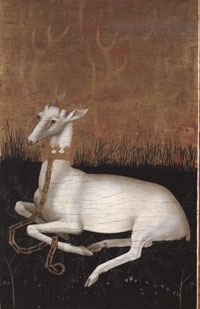
The White Hart from the Wilton Diptych
|
|
1393
|
The Abbey Church at Bury was flooded.
Richard II has been credited with the origin of pub signs as he issued a decree in 1393 stating that
"Whosoever shall brew ale in the town with the intention of selling it must hang out a sign; otherwise he shall forfeit his ale".
The intention of this decree was so that the official ale taster could identify all the ale houses in London, which is the "town" referred to.
In fact, most businesses erected some form of pictorial sign to advertise their existence long before this time. In Roman times local 'Tabernae' would hang vine leaves outside to show that they sold wine. In Britain small evergreen bushes were sometimes substituted. One of the first Roman tavern signs was the 'Bush'. Early pubs hung long poles or ale stakes outside their doors. If both wine and ale were sold, then both bush and pole would be hung outside.
The naming of inns and pubs probably became common by the 12th century. However, signs such as "The White Hart", have been associated with the time of Richard II as this was his own badge. Other names including "white" have similar early royal attributions. Supposedly most 'White Lion' inns are said to date from the time of Edward IV and the 'White Boar' was the emblem of Richard III. Such ideas have to be treated with caution. For example, the White Hart in Southgate Street, Bury St Edmunds was known as The Mitre in a document of 1741.
|
|
1397
|
An amazing incident took place at Hawstead in 1397. A close, or enclosed area, at Hawstead, owned by Sir William Clopton, was broken into by a party of men armed with swords, bows and arrows, led by Philip Fitz-Eustace. The party included John Heyden, John Clerk ( a chaplain), Hugh de Baldwyne, Roger and Thomas Gebon, John Lausele John Smyth of Ashton, and John Waryn. They cut down and carried off 20 oak trees, 100 ash trees, 40 poplars, as well as linen and woollen cloth, vessels of silver, brass and copper, other utensils belonging to the house, and barley, peas, beans and oats worth £40. Fitz-Eustace claimed that the property all belonged to him, but he was found guilty of the crime, and ordered to pay £23 damages. He seems to have dragged the matter out in the courts to 1407, when he had still not paid any compensation for the thefts.
|
|
1399
|
Richard II was deposed by his cousin Henry, Earl of Derby when Henry's troops captured him in August, 1399. He had to resign the crown in the Tower of London on 29th September, and was kept prisoner in various castles. Richard had been fascinated by the ideals and trappings of royalty and had created a glittering court, but ended his days in misery, probably finally starved to death in Pontefract castle by February, 1400. Henry IV of the House of Lancaster reigned until 1413.
|
|
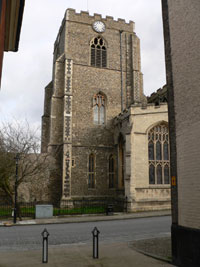
St Mary's church tower
|
|
1400
|
St Mary's church at Bury St Edmunds was given a tower, probably under construction from 1395 to about 1403.
Around 1400 the Thetford Warren Lodge was built by Thetford Priory. It may have begun by being a hunting lodge for the Prior and his aristocratic guests, but the story is that it was later used by the Warrener to protect the valuable rabbit warrens built nearby.
From about 1400 to 1600 the Stour Valley and its surrounding villages would become one of the major industrial areas of Britain. Its wealth was based upon the production of woollen cloth. Much of its output would be passed through the great market at Bury St Edmunds. The so-called wool churches of this area might be better called cloth churches, as it was not wool itself, but its manufacture that generated this wealth.
Raw wool was still a valuable commodity in Bury's trade, but raw wool was available throughout England in its market towns. However, high quality finished woollen cloth was available in only a few places, and Bury was one of them. By 1400 cloth was the most valuable commodity traded in the Risbygate Market.
This thriving cloth industry was not typical across the country and it has been written that towns in general suffered an urban decline from 1270 right up to 1530. This decline was most noticeable between 1420 and 1530. This has been called the Urban Crisis of Medieval Britain, but in the wool towns of Bury, Lavenham, Long Melford and the other local cloth villages, this was a time of growth and prosperity. The setbacks of disease and war were just as bad as elsewhere, but in these areas immigration and money helped to soften these blows.
In contrast, Thetford had been in decline since the Norman Conquest. In 1100 it had a population around 5,000 people, but by 1400 this had fallen to about 2,000. Its surrounding arable land was now worked out, and consisted of sandy heathlands. The bridge at Brandon had cut it off from the sea because boats could no longer freely pass upstream.
By 1400 Suffolk peasants could afford to eat beef. During the 1360s, 1370s and 1380s their meat diet was restricted to pork or mutton. Similarly, cheese made from cows' milk replaced goat's cheese. The labouring classes had managed to push up their incomes by earning a better daily rate of pay, and working for more days in the week.
|
|
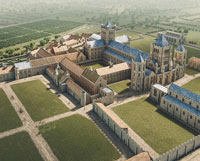
St Edmunds Abbey c1400
|
|
1401
|
This visualisation of the abbey of St Edmund by about 1400 was made by Carlos Lemos and Bob Marshall for English Heritage, as part of the production of Information Panels to be erected in the Abbey Gardens in July, 2022.
Despite widespread support for the Lollards, a law was passed ordering the burning of obstinate heretics. A number of executions were carried out. Henry IV's statute was called "De Heretico Comburendo".
|
|
1406
|
John Nottingham was first made Alderman of Bury in 1406, and again in 1407. He was Alderman again from 1425 to 1427. In his will he was described as a grocer, but moved into property, and then high finance.
It seems likely that from 1406 to 1408, John Lydgate, a monk from Bury, was attending university at Gloucester College, Oxford. The Dominican black monks kept Gloucester College as their own college for the study of divinity and theology. Bury had close links with this college, and regularly had two or three students attending there. It is also likely that while at Oxford, John Lydgate translated Aesop's Fables, which was to be published and circulated by the great literary distributor of his age, John Shirley.
John Shirley ran a private scriptorium in London, where teams of clerks would copy out books for sale to the general public. He was like a modern publisher, but in the days before printing, all books were copied out by hand. Originally literacy had been confined to the abbeys, but by this time, there was a great demand for written knowledge from a well to do and educated secular public. John Shirley was born in 1366, and lived to the great age of 90, dieing in 1456. He published most of John Lydgate's works, adding valuable notes and introductions to each work, as was his custom on all his publications. His large enterprise consisted of producing books, acting as a bookseller, and even operating a lending library. You could have a book written to be well read and used, or you could order a sumptiously illustrated presentation copy, meant to be shown off and admired.
|
|
1407
|
The Lollard Bible was banned. It had been produced in English in the 1390's. Lollard ideas against the established religion continued to get grass roots support, as well as some high ranking assistance.
|
|
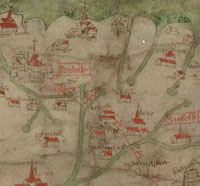
Gough map E Anglia only
|
|
1410
|
The Gough Map or Bodleian Map is a Late Medieval map of the island of Great Britain. Its precise dates of production and authorship are unknown, but recent studies suggest that it dates to around 1410, but was probably a copy (with additions) from an earlier prototype from around 1360. Here we see just the East Anglian part of the map. It is named after Richard Gough, who bequeathed the map to the Bodleian Library in 1809. He acquired the map from the estate of the antiquarian Thomas "Honest Tom" Martin in 1774.
As was the convention at the time, East is at the top of the map. Bury St Edmunds is shown as "Bury" with a stylised representation of the abbey with a cross on a spire. A red line shows a route from London to Norwich via Bury St Edmunds.
In 1895 M R James wrote his book, "On the Abbey of St Edmund at Bury." The first half of this work was dedicated to the Library of the Abbey. He wrote that from 1410 to 1430, a monk called John Boston of Bury, had made a Comparative Catalogue of the contents of the Monastic Libraries of England. He travelled the country, and examined the contents of 195 monastic houses to discover the books which they held. He gave each house a reference number. Bury Abbey was number 82, while an establishment called Batewell monachorum (minorum), was given the number 173. M R James believed Batewell to be the Babwell Friary of the Franciscan Friars Minor.
Boston of Bury's great catalogue was arranged by Author, and the title of the work. He then gave a list of the reference numbers of the monastic institutions which owned a copy of the book.
Institution number 82, (Bury), held works by Anselm, Alexander Neckam, Alcuin, and 22 other authors. One author listed was Radulphus Niger, who James recorded as a native of Bury. However, it was not yet usual practice to hold these books in a central library, but following John Boston's efforts, purpose built libraries would now start to appear at monasteries.
|
|
1412
|
In 1412, the Prince of Wales, soon to become Henry V, commissioned John Lydgate, a monk of Bury, to translate the Tale of Troy into English. This work probably took until 1420. The Prince attended Oxford University in 1398, and either met Lydgate there, or heard of him through Edmund Lacey, who was Master of University College in 1396 to 1399. Lydgate had definitely been at Oxford in 1406-8, and J Norton Smith believed he was there as early as 1397.
|
|
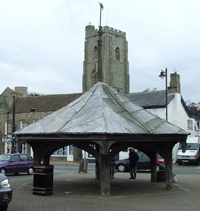
Mildenhall Market Cross
|
|
1413
|
Henry V came to the throne.
Manorial rolls at Mildenhall recorded that a new tollbooth was paid for in the market place. This tollbooth may well have survived to the present day, known as the Market Cross. Mildenhall was now growing, despite the impact of the Black Death. The Abbot had set up a new fair at Mildenhall, and dredged the River Lark to improve navigation. The new trades were based upon rabbits and textiles. The prosperity of Mildenhall was to prove short lived, and it would decline after the mid 15th century.
|
|
1414
|
At Bury, the Abbot William of Cratfield died. He was succeeded by William of Exeter, who would rule until 1429.
An attempted uprising of Lollards failed and its leader Sir John Oldcastle was burnt in 1417. With these events any support of the well to do fell away. However, the sect's following amongst the weavers was to survive for many years driven underground. Support in Suffolk was mainly in the Waveney Valley, such as Beccles and Bungay. Lollards pre-dated Protestants in nearly all of their key beliefs.
|
|
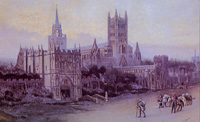
St Edmund's Abbey in 1415
|
|
1415
|
Henry V defeated the French at the Battle of Agincourt, famous for the use of archery to overcome heavily armoured cavalry.
|
|
1417
|
Deeds to the Angel Hotel show that at this time it was occupied by the Castle Inn with a property called Le Cookery next door.
|
|
1418
|
In 1418 Sir Roger Drury of Rougham died, and was buried in Rougham Church. The Drury family had been associated with Thurston since 1066, when a Drury arrived with William the Conqueror, according to family legend. It was Sir Roger who removed the family from Thurston to Rougham. In 1464 another Roger Drury would buy the manor of Bokenhams at Hawstead.
|
|
1420
|
Having just finished his Book of Troy,
John Lydgate wrote the Siege of Thebes. In it he describes himself as "Lydgate, Monk of Bury, nye 50 year of age." This meant he was born about 1370, and like all monks, took the name of his village when he entered the priesthood. "Born in a village which called is Lydgate, Be old time a famous castle town, In Danish time it was beat down, Time when St Edmund, martyr, maid and king, Was slain at Oxne, by record of writing."
The story of the village of Lidgate was not quite as John Lydgate told it. Lidgate was, and is, situated on the road from Newmarket to Clare. During the anarchy of King Stephen, Lord Hastings built a huge earthwork there, topped by a castle. A market was set up and tolls collected, so that Lidgate become one of the eight Boroughs in Suffolk. By the 13th century the castle had been abandoned, and burgage plots were established within the old bailey, and a new road was created. However, following the Black Death, Lidgate failed to prosper any further, and became a failed town, a victim of the so-called urban crisis.
By 1420, John Lydgate's own literary reputation was well established, and he moved into a wider world. For the next ten years his work would become involved with the great occasions of the time. He became almost the official poet of the establishment, praising coronations, and producing a poem or homily to dignify any event or undertaking. Much of the time from 1420 to about 1432, John Lydgate travelled around the country, and even went on foreign trips, sponsored by rich patrons of the arts.
|
|
1422
|
Henry VI became King until he was deposed in 1461. John Lydgate, by now the most well known monk at Bury, wrote a poem to celebrate the occasion, " Ballade to King Henry VI on his Coronation."
|
|
1423
|
John Smith or Jankyn Smyth was first appointed Alderman of Bury St Edmunds, a post nominated by the men of Bury, but subject to the approval of the Abbot. Between 1423 and 1461, Smyth was elected Alderman at least seven times, but there are many gaps in the record. In the 58 years from 1423 to Smyth's death in 1481 there are twenty years missing records of Aldermen. The post was the official interface between town and abbey, and in representing the townspeople, the Alderman could run the risk of offending the Abbot.
Jankyn Smyth would become well known even to future generations of Bury people because he was the first, if not the greatest, of benefactors of the town.
|
|
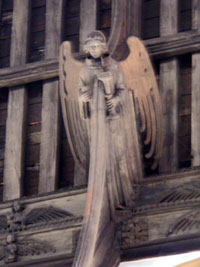
Carved angel in St Mary's
|
|
1427
|
Unlike many monasteries in the 15th century, Bury was revitalised at this time. In about 1427 St Mary's Church rebuilding was finished with its celebrated carved wooden angel roof. The new nave was longer than its predecessor.
|
|
1428
|
Population decline over the last 70 years in the countryside left 74 Suffolk Parishes with fewer than 50 people. Farmers who remained were able to take over bigger land-holdings, often enclosing their land with hedges and ditches. This trend continued throughout the century and beyond.
John Lydgate finished a major poem, written in France during a long period away from the Abbey at Bury, called "Pilgrimage of the Life of Man."
|
|
1429
|
When William of Cratfield died, William Curteys became Abbot of St Edmundsbury. He was very pious but also worldly wise and business like. He would keep matters to do with the town on an even keel throughout his reign up to 1457.
Having completed his Life of Man, John Lydgate was asked by French clerics to translate into English a French text of the Danse Macabre written on the cloister walls of the Church of Holy Innocents in Paris. The French text was inscribed in 1424. His translation is very close to the original and the theme is that whatever a man's station on his earth, everybody dies and comes to the same end. The word Macabre is thought to be the name of one of the French writers on this theme, as Lydgate called it "the daunce of Machabre". The word has now taken on its own meaning in English, derived from the theme of the poem. Lydgate's translation was to be largely responsible for the Dance Macabre becoming a part of English religious life for many years to come.
|
|
1430
|
Samson's central tower over the West Front of the great abbey of St Edmund collapsed in 1430. It came down over a period of days as firstly only the south side fell. Then came the east side, but great jagged parts of the north and west side would stand for the next year or so before rebuilding could begin. Abbot Curteys blamed the negligence of previous sacrists and the excessive ringing of the bells. M R James wrote in 1895 that the two collapses were a year apart, the south side falling in December 1430, and the east side falling in December 1431.
In 1430 Abbot Curteys made an agreement with John Arnold and Herman Redmond to burn bricks for him at Chevington. It is difficult to know whether brick was widely used yet in Bury, but this is an early record of its use.
Abbot Curteys also began to build a new library for the abbey's book collection, which by this time included about 2,000 volumes, one of the biggest collections in the country. Previously the abbey's books had been scattered around the church buildings, and many had been in the hands of individual monks, and even towns people.
It is likely that Abbot Curtys took advice from the monk, Boston of Bury, as to how best to organise the collection. John Boston seems to have died in 1430, but he had spent at least twenty years working upon the organisation and cataloguing of monastic papers. Abbot Curtys' first job was to take control of every book, so that it could be given a place in the library. He gave everybody 15 days in which to surrender any books they held, on pain of punishment. A secular person who stole a book, or kept a book in his possession could be excommunicated. He drew up rules for the subsequent use and borrowing of books.
The location of the library is not definitely established. M R James concluded that it was probably over the Cloisters.
John Lydgate was now back in England, and was commissioned to have the verses of the Dance Macabre inscribed on the cloister walls of Pardon churchyard near St Paul's. This was to be the start of an an English fashion for such murals and a morbid concentration on death.
William de la Pole was Earl of Suffolk at this time. On his return from France he was soon appointed to be on the Council that was governing England while King Henry VI was still a minor. His home at Wingfield was regarded as a castle, and was only a few miles away from the Duke of Norfolk's seat at Framlingham Castle. An intense rivalry arose between these two powerful figures and their followers.
|
|
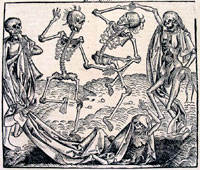
Dance of Death
|
|
1431
|
Joan of Arc was burnt at the stake. In Suffolk, Lollards were persecuted for opposing many Catholic religious practices. From 1428 to 1431 there were many prosecutions and two executions, particularly around Beccles and Bungay. A hundred years later Martin Luther would repeat many of the Lollard teachings.
As Lord Protector of England during King Henry VI's minority, it was Humphrey, the Duke of Gloucester who was largely responsible for the suppression of the Lollards. John Lydgate had written an anti-Lollard poem called "Defence of Holy Church", possibly as early as 1414. The Duke was a supporter of arts and interested in scholarship as well as politics. Thus it was Humphrey, the Duke of Gloucester, who asked John Lydgate to translate Boccacio's De Casibus Illustrium Virorum into English. The commission set the seal on Lydgate's full time return to Bury, and he needed to have a secure base if he was to attempt such a major work. This work took eight years and was completed as "The Fall of Princes" by 1438.
By this time, John Lydgate had returned from an extensive foreign tour including Paris where he saw the mural cloister paintings of the Danse Macabre or Dance of Death. Not only did he translate a poem describing this, he was responsible for spreading the Danse Macabre concept in this country. Lydgate had entered Bury Abbey at age 15 and studied at Oxford and Cambridge before his foreign tour. On his return to Bury he ran the School for the sons of noblemen and under his patron, Humphrey, Duke of Gloucester, was effectively to become Court Poet to Henry VI.
|
|
1432
|
The remains of the collapsed Tower were taken down and work began to rebuild the Abbey Church following the collapse. The library would also be rebuilt, and this work may have dragged on for the next 50 years, particularly as a great fire would be caused by a workman's brazier in 1465.
The second Duke of Norfolk died in 1432, leaving his under age son, John Mowbray, to become the 3rd Duke of Norfolk. This allowed William de la Pole, Earl of Suffolk, to build up his power and influence in East Anglia, eclipsing the Mowbray family power and prestige. In 1433 Suffolk would become steward of the King's household, giving him a prominent national position.
|
|
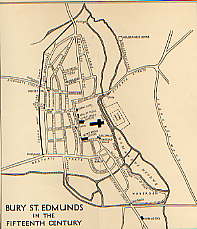
Lobel's map of Bury |
|
1433
|
It is not known where or when Jankyn Smyth, a wealthy merchant of Bury, was born. However, a rental of 1433
shows him occupying property on the north side of Churchgate Street, between Hatter Street and Angel Lane.
One of Jankyn Smyth's contemporaries was called John Baret. We know a bit more about his origins. Baret was the second son of Galfrid and Joan Baret who came to Bury from Cratfield. John was probably born in Bury around 1400. His older brother, also called John died around 1431, and John the younger inherited the family fortune, which was made in wool and cloth.
Both Jankyn Smith and John Baret would become remembered as benefactors of the town.
In her publication, "The Book of Bury St Edmunds," Margaret Statham published a map of Bury based on the Sacrist's Rental of 1433/34. The map is shown here and her analysis of the Rental in street by street order, is contained in a document which she lodged at the Record Office, which you can view by clicking here:-
Margaret Statham's translation of the Sacrist's Rental of 1433 (1961)
|
|
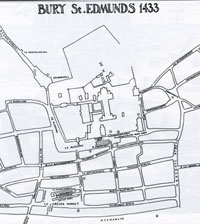
Bury in 1433 by M Statham |
|
blank |
The map shows that today's Abbeygate Street was divided into areas called Cook Row, Barber Row, Spicer Row and Fish Market. Later the whole street was called Cook Row, before being re-named Abbeygate Street in 1792.
In 1433 King Henry VI toured Eastern England. The last king of the Lancastrian dynasty, Henry VI was born at Windsor Castle on 6th December, 1421 and became King of England in his cradle. He was only eleven when he made this tour, and the country was being run by the Great Council, lead by Humphrey, Duke of Gloucester, the youngest of Henry V's brothers.
At this time, no king had visited Bury St Edmunds for 100 years. He arrived on Christmas eve with a vast retinue along the Holeway from Cambridge, and was met at Newmarket Heath by the major figures of the abbey and town, all dressed in scarlet or red in honour of the king. The entry to the town was made through the South Gate and up Southgate Street, the main processional way at the time. They went straight into the Abbey Church for a service of thanksgiving.
|
|
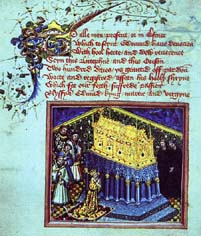
St Edmund's Shrine |
|
blank |
Henry VI was to become friends with Abbot Curteys of Bury following this stay, which became extended, and the abbey was aware of the great status which this long stay was to give them. During this visit, Abbot Curteys asked John Lydgate to write The Life of St Edmund, as a present for the king to commemorate his visit. It would take six more years before this work was finished and lavishly illustrated by the scriptorium monks.
It is likely that one reason for the visit was for the king to meet Lydgate, who was not only well known, but had already written a poem praising the king's coronation, and another on his return from France. In 1433 the
King arrived on Christmas Eve and stayed with the abbot until Epiphany. The king then moved into the Prior's lodging and then to the Abbot's manor of Elmswell. At Elmswell the abbey maintained a rabbit warren to provide fur and meat. He returned at Easter. By 1433 St Mary's Church was enlarged westwards beyond the Abbey wall giving it a town doorway.
|
|
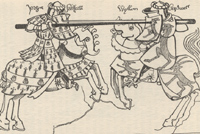
Suffolk Knights jousting |
|
1434
|
This illustration of Suffolk knights in a joust or tournament, is believed to have taken place as part of the celebrations around the visit of King Henry VI to St Edmunds abbey in 1433/34. On the left is George Seckford from east Suffolk, and on the right is William de Bardwell, from west Suffolk.
The abbey monks had a bell cast for them by William Powdrell of London, suggesting that they did not have the capacity to make such a bell themselves. However a bell foundry does seem to have started in Bury St Edmunds around 1450, according to "Bells and Bellringing in Suffolk", by R Clouston and G Pipe.
At 10 pm on 21st July, 1434, one James Andrew, was ambushed near Bury St Edmunds, and wounded so badly that he died. Andrew had been in a dispute over land at Baylham with Richard Steresacre and various other Framlingham men, who had threatened his life. Andrew had asked a JP to issue writs against these men to keep the peace, and they had been summoned to the assize judges at Henhowe, just outside St Edmund's town, to answer the case on the following day. The killers were alleged to have been under the direction of Sir Robert Wingfield and other followers of the Duke of Norfolk. They hid out in Bury at "hospices", occupied by Wingfield et al. At midnight, the alderman, John Edward, went to arrest the attackers, but had arrows fired at his men, and later the attackers escaped out of town at 5am.
John Andrew was a prominent landowner around Ipswich, and in 1421 had been a knight of the shire for Suffolk. He was a lawyer and had been associated with the Earls of Suffolk since 1408. His legal dispute with Steresacre had been going on for 20 years, and by 1434 it had become an issue of the de la Pole / Suffolk faction with the Mowbray / Duke of Norfolk faction.
|
|
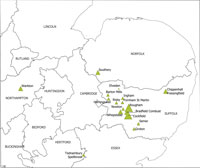
Lease values of cellarers manors |
|
1435
|
Before 1400 most of the lands of the large landlords such as Bury Abbey were cultivated and managed directly by the landlord and his employees. By around 1400 many of these landlords had decided to change to leasing out much of their lands for a cash income, allowing their tenant farmers to make decisions on the ground as to how and what to cultivate. The Black Death and its aftermath had largely been responsible for this change in attitude, bringing labour shortages of both workers and monks to manage their lands. The old labour dues exacted from tenants before the Black Death were replaced by cash payments for rentals.
|
|
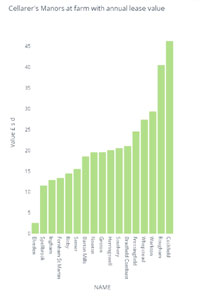
Plot of Lease values |
|
blank |
In 1435 the Abbot William Curtis introduced his budget or Economica which imposed strict weekly allowances upon the Cellarer to address the abbey's continuing losses. For example, each monk, previously allowed 8 pints, was now restricted to 5 pints of ale per day. As part of this attempt to gain control over the abbey finances he produced a register of all the leased out Cellarer's manors together with their annual rental income.
Both the Cellarer and the Abbot kept direct control of their most valuable holdings, such as the sheep pastures around Bury. These were the new income generators of the day. For example, the abbot had 2000 sheep at Culford and 1,500 at Fornham All Saints. Similarly the manor of Mildenhall was still held as a Demesne Manor, and was the most valuable of the Cellarers holdings. Mildenhall probably generated up to 20% of the Cellarers income and was far too valuable to be leased out to anyone else.
Neither Mildenhall nor these sheep pastures are reflected in the attached map, or the plot, which shows the relative income generated by Manors belonging to the Cellarer, but leased or farmed out for cash.
Of the cellarer's leased manors the most valuable were Cockfield, (£46.4s.5d) Rougham, (£40.9.1) Warkton, (£29.6.0) and Whepstead (£27.6.8).
The least valuable leases included those areas where the abbot and cellarer kept vast flocks of sheep directly under their own control, like Elveden, Ingham, Fornham and Risby. There was no leased manor at Culford, where the biggest flocks were kept.
In 1435 agents of Henry VI commissioned the Jervys brothers of Bury to outfit two fleets for the French Wars. John Jervys was linked by marriage to John Nottingham, and with his brother Thomas had business interests all over eastern England. The bulk of his property was in West Suffolk, which he ran from his house on the Great Market. Most of the major land deals in mid 15th century Bury seem to have involved him, but he was often in trouble with creditors, sometimes being arrested and ending up in court.
The rivalry between the Duke of Norfolk and the Earl of Suffolk had turned to violence. On 15th February, 1435, both parties were ordered to appear before the King's Council, and were asked to give security to keep the peace. John Andrew's murder in 1434 had threatened to provoke open hostilities between his supporters and those of the Earl of Suffolk on the one hand, and the Duke of Norfolk's household and retainers on the other. Suffolk juries had considered the indictments at Henhowe, and found them to be true, but in April, writs came from on high to send all the documents to the court in Chancery. The case would drag on for several years with both sides using their influence to get pardons for their own followers. In general terms it was de la Pole who rose in power during these years, becoming Duke of Suffolk in 1448. This left the Duke of Norfolk much the weaker until Suffolk's death by execution in 1450.
|
|
1436
|
King Henry VI visited Bury Abbey again.
The abbot was having to defend his local privileges after several prisoners escaped from the gaol in Bury. Nominally the abbot's goal for the whole of the liberty, it was kept in repair by the sacrist, who also paid the gaolers wages. When the keeper of the gaol failed to keep his prisoners safely, it reflected badly on the abbot, and there was a seven year attempt by the crown to take back the administration of justice in the Liberty.
|
|
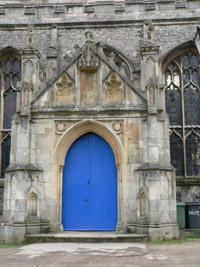
Nottingham Porch |
|
1437
|
John Nottingham left money in his will to build porches on St Mary's West and South doors. In the event the money was used to provide a grand porch on the North door. In his will, Nottingham was recorded as a grocer, and his name has been spelled variously as Notyngham or Nottyngham etc.. However, whether starting in groceries or in the draperies, he moved into property owning, where his real wealth was made.
By this time he owned more tenements and messuages in Bury than any other individual. He also owned property throughout West Suffolk and in London. He had been Alderman at least five times.
|
|
1438
|
In 1438 John Lydgate, a monk now residing full time at Bury, completed his longest work, "The Fall of Princes". It was a translation into English of Boccaccio's "De Casibus illustrium virorum," originally written in 1358. The end product contained over 36,000 lines, and itself was based on a French translation of Boccaccio dated around 1409.
Being so long it could not easily be published in full, but extracts from "The Fall" would be best sellers throughout the 15th century, and even in the 16th century, "The Proverbs of Lydgate", would continue to be a popular publication.
One of the earliest known references to Morris Dancing appears in a will made in Bury St Edmunds in 1438. The widow Alice Wetenhale leaves her daughter Catherine, 'Three silver cups sculpted with a morris dance'.
|
|
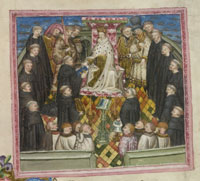
King Henry VI at Bury |
|
1439
|
In 1433–34, the 12-year-old King Henry VI had spent Christmas until Easter at the Abbey of Bury St Edmunds in Suffolk. To celebrate this royal visit, the abbot had commissioned one of his monks, John Lydgate (c. 1370–1450), who was by then a renowned poet, to write a history of St Edmund (the Abbey’s patron saint) in Middle English verse. This poem is known as "The Lives of Saints Edmund and Fremund."
According to the British Library:- "Over the next six years the monks of Bury created a spectacular copy of Lydgate’s poem, which they presented as a gift to the king in 1439. The monks worked on the manuscript in the scriptorium – a dedicated ‘writing room’ found in monasteries, where manuscripts were copied and illuminated. It contains 118 half-page illustrations from the life of the saint. In the image shown here you can see Henry surrounded by the monks of Bury, which is followed by a verse account of the king’s visit. Because of these amazing, elaborate images the manuscript has a claim to be one of the most important illustrated Middle English manuscripts in existence."
A facsimile edition was published by the British Library in 2004. Click on the thumbnail to see the full page.
It has been suggested that as an acknowledgement of his pleasure at receiving this gift the king granted Lydgate his royal pension which began in 1439.
|
|
1440
|
From about 1440, the rearing of sheep became more profitable around Bury than the rearing of cattle. Cattle had been kept for years in and around the town, supporting the leather industry as well as for food. The wool from sheep was now becoming much more valuable for weaving into cloth. This led to an extension to the number of sheep folds around the area.
With the increased cloth production around Bury, it would appear that the fulling and dying of cloth were polluting the waterways of the town. At any rate the number of people in the town calling themselves fishers seems to have fallen dramatically at this time. The river and fen fishing industry became moribund.
Betterton and Dymond found at least six wills from Lavenham which mentioned stocks of blue wool. The earliest of these wills was from 1440. This tells us that in Lavenham at least, it was the wool that was dyed in its unworked state, rather than the finished cloth. This gave rise to the saying of "dyed in the wool." Lavenham's finished blue cloth was a speciality of that town, and there were rules to protect its integrity. The right sort of blue could only be obtained from woad, which was mainly imported from around Toulouse in France. The woad was crushed and dried into woad balls for transportation. Dyers had to break up the balls and soak them until fermentation occurred. This resulting sludge was used to dye the wool. The use of Indigo for blue dye would not appear until about 1600. A cheaper red dye came from Madder, which was grown around Great Waldingfield. Other colours came from a variety of plant materials and substances.
Dyers needed a constant water supply and in Lavenham a stream ran from the manor house pond down through Water Street. Water was drawn off by dyers into their collecting vats, but dirty water would inevitably return to the watercourse. Over the following decades this stream would become culverted and managed by elaborate brickwork, until it eventually became completely subterranean.
|
|
1441
|
John Edward died in Bury. He was another wealthy man who made his money from the wool and cloth trade. He had been Alderman at least three times, and also used his money to buy land. His children were to abandon commerce altogether to become landed gentry.
|
|
1445
|
Between 1425 and about 1445 most of St Mary's church had been rebuilt except for the tower and chancel.
Simon Clerk was an English master-mason, who worked on the great Abbey of Bury St Edmunds from 1445 until his death in 1489. Around 1480 he took on John Wastell as his junior at Bury Abbey. These master-masons were not expected to restrict themselves to one location, and Simon Clerk is known to have worked at Eton College between 1453 and 1461. He is also known to have been employed at King's College Chapel, Cambridge (1477–85), where he also worked with the young John Wastell, and was involved in the design of the celebrated fan-vault. Clerk may have designed the tower of Lavenham Church, Suffolk (c.1486–1525), and was probably responsible, with Wastell, for the naves at Lavenham and at Great St Mary's, Cambridge. He also worked on the church at Saffron Walden in Essex.
|
|
1446
|
At Melford Kentwell Manor was inherited by John Clopton from his father William, who had just died. John was 23 and would hold Kentwell for 51 years. John Clopton would be responsible for a great rebuilding scheme at Melford Church in the years after 1461.
At Bury, Abbot Curteys died. He had been a very good ruler of the relationships between abbey and town since 1429. Had he lived, his influence over the king was such that it is possible that the events shortly to involve the Duke of Gloucester may never have got out of hand. He was succeeded by William Babington, who ruled until 1453.
King Henry VI held a Parliament in Bury St Edmunds. Parliament met in the Great Refectory of the Abbey and was presided over by the king in person.
|
|
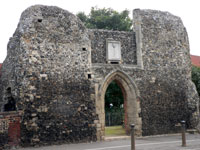
St Saviours today |
|
1447
|
King Henry VI summoned his Parliament to sit in Bury St Edmunds in the Great Refectory.
Humphrey, Duke of Gloucester, was lodged in St Saviours, on the Fornham Road, outside the North Gate. Apparently out of the blue the Duke was summoned to appear before the House for high treason. Aged 56 his doctor said that the shock gave him a stroke from which he died 5 days later. This incident led to rumours of murder and these persisted so that William Shakespeare was to refer to the incident in one of his plays, Henry VI, Part II.
In the play, the action moves between London, the abbey at St Albans, and the abbey at Bury. The references start in Act two scene 4 when a herald addresses Gloucester "I summon your grace to His Majesty's parliament, holden at Bury, the first of this next month." Act Three is at the abbey at Bury St Edmunds, in parliament, where the Duke of Suffolk arrests Gloucester on charges of treason. The king does not believe it, and expects him to be found innocent. Cardinal Beaufort, the Bishop of Winchester then suggests that if the rest will support him, he will provide an executioner. The Queen, the Duke of Suffolk and Richard Plantagenet, the Duke of York, all agree. In act three, scene 2, in a room of state at Bury St Edmunds, 'enter two or three murderers, running over the stage, from the murder of Duke Humphrey.' "Run to my Lord of Suffolk, let him know We have despatched the Duke, as he commanded." Duke Richard of York owned land in the area to the north of Bury, around Babwell. He endowed some of this land to the friars at Babwell who had their priory on the site of today's Priory Hotel.
|
|
1448
|
The King again summoned Parliament to Bury St Edmunds.
|
|
1449
|
It is believed that the monk John Lydgate died near the end of 1449. He had been a prolific author, producing twice as much as Shakespeare, and three times as much as Chaucer.
In his day he was considered the pre-eminent poet of the English language, and was probably even more highly regarded than Geoffrey Chaucer. This acclaim continued through the next century, until critics of poetry turned on him by about 1600, accusing him of using difficult and obtuse language, and his reputation faded, never to rise again. Today, it is best to see Lydgate as completely typical of the medieval period, both in his use of language, and his thought patterns. He reflected nothing of the new ways of the Renaissance. Today we praise a poem for its conciseness, or brevity, getting its point over with economy of phrases. By 1802, Ritson referred to Lydgate as 'this voluminous, prosaick, and drivelling monk'. In the early Middle Ages, nobody wanted economy in an author. In a society where few people could read, and books were only for the rich, the written word was there to be read out loud. Dramatic writing was based on the theory of "amplification", the very opposite of brevity. People wanted a point to be spelled out, so that even the dullest could follow the moral of the tale. They wanted to enjoy the flow of words; they had plenty of time to fill, once the daylight had gone. Books only partly replaced the oral tradition of the bards, and a good reader was still prized for his skill in holding an audience.
Ritson's summary dispatch of Lydgate is as much the dismissal of a now alien mode of living and social outlook as it is a dismissal on the grounds of literary quality. Since 1600 we are no longer as equipped to enjoy, and judge, as his peers.
John Lydgate, a monk of Bury, wrote for his age.
|
|
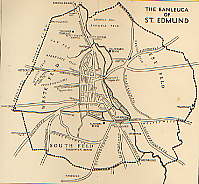
The Banleuca by 1450
|
|
1450
|
By 1450 only about 30% of Suffolk was under the plough compared to 50% in 1300. Many farmers had shifted from growing grains to rearing animals.
From 1450 to 1530 the cloth industry would reach a peak of prosperity.
This was particularly marked in the broad cloth area of Suffolk, between Clare, Bury St Edmunds and East Bergholt. Bury St Edmunds was the principal market outlet for the woollen cloth of the Stour Valley, as well as being a major producer in its own right. Merchants came to Bury's wool markets from London, Norwich, Kings Lynn, Great Yarmouth, the Low Countries, Germany and Italy. They were seeking the cloth from the finest fleeces in Western Europe.
As well as the better known textile villages, places within ten miles of Bury like Woolpit, Rattlesden, Thorpe Morieux, Boxstead, Icklingham, Stanstead and Mildenhall were centres of the weaving trade, sending cloth to Bury. Today, Lavenham and Long Melford are well remembered as wool towns, but it is important to understand how widespread the trade was in this area.
Some clothiers would become extremely rich on this trade, particularly in Babergh and Cosford hundreds. Lavenham became the greatest centre for cloth with the most clothiers. Hadleigh, Lavenham and Bury St Edmunds had the greatest output of cloth followed by Ipswich, Nayland, Waldingfield, Long Melford and Sudbury.
By 1450 it is reckoned that about half of Bury's export trade was through Kings Lynn, by way of the Rivers Lark and Ouse.
|
|
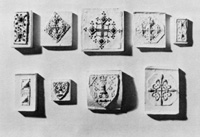
Bury bell foundry marks |
|
blank |
A bell foundry seems to have started in Bury in 1450, by a founder with the initials HS. His foundry mark included a cannon and cannon ball, so he probably cast more than just bells. The crossed arrows indicate Bury as his foundry. If he cast guns as well as bells, he would need to vary the mixture of his bronze. Such foundries would, no doubt, make bread and butter items like cooking pots as well.
Bells are cast in bronze, but in order to get a good sound, the tin content is increased. A bell is made of 77 percent copper and 23 percent of tin. The high tin content has the disadvantage of making the bell brittle and liable to crack. Bronze age swords, for example, were typically made with around 10 percent tin.
|
|
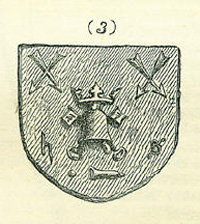
Bury HS foundry mark |
|
blank |
Although HS is unknown, he was followed in 1470 by Reignold Church as the bell founder. The HS shield was still used by Church until his death in 1498, and by his son Thomas Church until 1527.
During the later Middle Ages, Haverhill prospered and was featured prominently on 15th and 16th century maps of England, much more so than some of its neighbours like Linton, Clare and Sudbury. Records of the market in the reigns of Henry V and Henry VI (1431 - 1461) give evidence of a significant trading centre, with shops and stalls selling meat, fish, cloth, small goods, lace etc and traders coming in from places like Hundon and Steeple Bumpstead. Haverhill was also a minor centre of the woollen industry and became a weaving town, a characteristic it maintained for several centuries.
The Queens Head is one of the oldest buildings in Haverhill; its mediaeval roof remains. It probably dates from the 15th century, when the Saturday market was very active and "many Inns abut upon the Highway leading from the market to Cambridge and other Townes". The lands belonging to these inns were know as "ye Market Meadowes". In addition to the Queens Head, the Bull, the Bell, the Crown (in Crown Lane) and the White Lyon were prominent.
|
|
1451
|
A fish seller called Cranford, from Steeple Bumpstead, and a peddler called Fisher from Hundon were fined 12d (5p) for selling fish and sprats at an excessive price in the Haverhill market.
|
|
1453
|
The 100 Years War ended with France. The Wars of the Roses began.
|
|
1455
|
By the mid 1400's the Breckland area to the north-west of Bury, began to change in character. The light soils had been ideal farmland from the earliest years because of its good drainage and easy ploughing and cultivating. By this time the soil was exhausted, and tillage gave way to the keeping of sheep and rabbits. Climate change may also have resulted in lower rainfall resulting in crop failures. Sheep farming was also becoming more profitable, but the resulting over grazing would lead to the great erosion problems of later centuries.
|
|
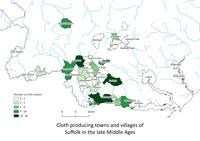
Suffolk cloth producing towns |
|
1460
|
By 1460, Suffolk was the largest textile producing area in the country. It had achieved this position since the Black Death in 1348/1349. In 1350 Suffolk textiles made up about 3% of total English production. By 1390 this figure had increased to 6%, but by 1460 Suffolk was producing 14% of the country's output. In the past this growth has been attributed to an influx of Flemish weavers, but there seem to have been comparatively few Flemings in the county except for traders in the ports. Another suggestion has been a rapid adoption of fulling mills, but Mark Bailey has pointed out that there were only 25 fulling mills known in Suffolk at this time, insufficient for such an impact. Bailey suggests that the reason was simply the entrepreneurial spirit of Suffolk producers, who chased the market for cheap, mass produced clothing. The workforce did not need to be particularly skilled to make these coarse cloths, and low cost production could be set up in small villages. Lavenham and Hadleigh had grown with this trade, as did Long Melford and Waldringfield. The lower quality Suffolk wool was used, rather than best Lincolnshire wool.
At Lavenham, the producers would now begin to turn to a better quality of cloth, known as blues and broadcloths. These were not top quality materials, but certainly appealed to the better off sections of society. By exploiting this market, the growth of Lavenham exceeded that of Hadleigh. This growth of Lavenham would extend into the early 16th century.
|
|
1461
|
The Candlemas Guild elected the Alderman and by 1461 Jankyn Smyth had been elected to this post seven times. The job tended to be seen by townspeople as defending their position against the Abbey. Jankyn was certainly not a favourite of the Abbot as his appointment was vetoed at least once under the provisions of the 1305 arrangement.
John Clopton of Kentwell Hall at Melford was a friend of the Earl of Oxford, who resided at nearby Lavenham. The de Vere family had held the manor of Lavenham since before 1086, when it was recorded in the Domesday Book as in the hands of Aubrey de Vere. In 1461 John Clopton was arrested with the Earl and others for corresponding with the exiled Queen Margaret of Anjou, a treasonable offence. The Earl of Oxford and his son Aubrey de Vere were executed, but Clopton was allowed to return to Kentwell. Soon after this narrow escape from death he started organising and fund raising for major new building works on Melford Church.
Henry VI was deposed and Edward IV of the House of York took the crown.
|
|
1462
|
Hugh Babyngton and Edmund Lorymer and others were arrested for rioting in the town of Bury. It is possible that this riot was about national issues rather than local ones, as the crown had just changed hands.
However, the townspeople of Bury maintained their grievances against the Abbot and the abbey of St Edmund. Other towns were gaining more freedoms to govern themselves, whereas Bury folk had to rely upon discussions within religious guilds to consider matters of common interest. At Norwich, which was already a Borough, the town was now granted a charter to become a County in its own right. The whole of Norwich, except for the castle and the shire house, were separated from the county of Norfolk, and called the County of the City of Norwich. They could chose a Mayor instead of an alderman, and could replace their bailiffs by two sheriffs, and they could run the city as they saw fit.
|
|
1463
|
Smallpox was mainly a childhood disease, and it tended to appear in early spring. Bubonic Plague was an autumn disease and and the winter belonged to influenza. In 1463 there was a bad outbreak of the smallpox in Bury.
John Baret was a wealthy cloth merchant, who lived in his house on Chequer Square in Bury. During 1463 he wrote his will, copies of which survive in records today. He recorded that he had a spinning house at his home, which was unusual for the time, as most spinning and weaving took place in the cottages of the workers themselves. Fabrics known as dornix or darnick were produced by many weavers, while Bury coverletts were well known as well. John Baret would die in 1467.
|
|
1464
|
There were three separate manors in the area of Hawstead at this time. One of these was called Talemaches or Talemages in the past, but by 1464 it was usually called Bokenham's. In 1464, the manor of Bokenham's was acquired by Roger Drury of Rougham, and the Drurys would be associated with Hawstead until the Cullums arrived in 1656. Roger Drury moved his seat to Hawstead, and lived there until his death in 1500.
The other manors were called Hawstead, held by the Clopton family and Fyletts, held by the Rokewoods. As the Drury's fortunes rose, they would buy Hawstead Manor in 1505.
|
|
1465
|
On 20th January 1465, during restoration of the lead roof of the great St Edmunds abbey church, the plumbers left a brazier burning at their 10 o'clock break. It was blown over and the roof caught fire. By noon the whole chancel was a furnace and the main central spire collapsed into the choir beneath. The canopy over the saints relics crashed onto the shrine and the church was completely gutted. There is no subsequent reference to any inspection of the saint's body, and in 1931 Goodwin wrote that "it seems probable that the saint's body was more or less cremated on that occasion".
St James church was also severely damaged by fire. The abbey had to raise funds as best it could for the repairs. We can see from wills made after this time by the wealthy townspeople, that the abbey was not mentioned as an important beneficiary as often as it might have been two centuries earlier.
|
|
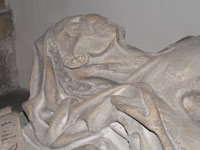
Tomb of John Baret |
|
1467
|
John Baret died and in his will left money to repair the Risbygate, which he called "the most ruinous of the town". He had made his money from draperies, as had the Drury family, and they were the most influential families in town at the time. It seems that much of the town's old infrastructure was in a state of decay at this time. For the next 50 years many rich citizens left money to repair the other gates as well. All the roads also benefitted from bequests. In contrast, the abbey was left little or no money, and did not itself carry out any major repairs to its own fabric or to the fabric of the tenements it owned throughout the town. Abbey property seems to have decayed considerably over this period.
John Baret's will was written in 1463, and contains some interesting points. After the usual "In the name of Almyghty God,Amen," he begins, "I John Baret, of Seynt Edmudys Bury, of good mynde and ......". Later he refers to John Smyth, "Itm to Jankyn Smyth my grene bedys with ...". Perhaps the town was as often referred to at this time as St Edmunds Bury as Bury St Edmunds, and Although John Smyth was his given name, he was widely known as Jankyn.
This John Baret was John Baret II, and was married to Elizabeth Drury, the daughter of Sir Roger Drury, a prominent local landed gentleman. Their son, John Baret III entered the abbey and rose to become Treasurer of the Abbey hoard, one of its most powerful positions. Because John III could not marry and carry on the Baret line, the Baret fortune was spread among the various nephews and nieces, who mainly lived other than in Bury.
|
|
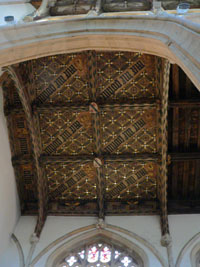
John Baret's ceiling |
|
blank |
John Baret ordered his memorial tomb to be in the shape of a cadaver wrapped in a funeral shroud, to be installed in St Mary's Church. The roof over the grave was to be a ceiling of mirrors representing stars, and incorporating the letters SS, referring to a ceremonial collar given to him by Henry VI.
Baret also left the Feoffees 250 acres, the income of which was to go to the Poor of Bury. He also left Baret House in Chequer Square to the town.
Thomas Hervey had married Jane Drury the heiress of William Drury of Ickworth, thus acquiring her property. When he died in 1467 the Hervey family of Thurleigh in Bedfordshire inherited the manor of Ickworth through the Drury family arrangements. Ickworth was a small village with a church on the banks of the River Linnet. The village was located in today's Ickworth park, between the Rotunda and the church by the canal. Only the church remains today as the village was removed when the Park was enclosed and landscaped. The Herveys lived in the Manor House somewhere near the church.
|
|
1468
|
In the most valuable and important parts of trade it was found that to avoid later disputes, an agreed standard was sometimes necessary.
A statute of 1467-1468 laid down the dimensions of an East Anglian broadcloth. It had to be 28 yards and 28 inches long, 5 feet 3 inches wide, and be of a weight of 38lbs. Given a guaranteed size such cloth could be more easily sold into foreign trade where goods could not be examined in advance.
As well as broadcloth, there was narrow cloth and straights. Straights were half the length and half the width of a broadcloth, and only one quarter of its weight. So four straights equalled one broadcloth. Possibly there were two narrow cloths to the broadcloth. These measurements were also the basis for a tax on cloth known as aulnage
There were many other cheaper types of cloth which were sold unregulated and escaped taxation. These seem to have included kerseys, handywarps, coxshall whites and Glemsfords.
Betterton and Dymond found that in 1466 Lavenham, Glemsford and Clare were taxed completely on broadcloths, while Great and Little Waldingfield were producing narrow cloths and straights. Hadleigh was mainly taxed on narrows, with a small number of straights and broadcloths.
|
|
1469
|
King Edward IV visited the Abbey at Bury St Edmunds.
A new Abbot was appointed at Bury and the town was, as usual, asked to pay the customary feudal dues of 100 marks. This payment was known as the Abbot's Cope, and no doubt originated from a custom of the town providing each new abbot with his ceremonial cope or robe. Like most feudal dues, these arrangements had once been made in kind, and over the years commuted into a cash payment.
At Barningham, Adam Berweham, a local yeoman, left instructions in his will for "three acres of land at Alfatysmer to be sold to aid the making of the new beam, called Candylbem." The Candlebeam was part of the Rood Loft arrangement which was being added to St Andrews Church in Barningham. The beam would extend across the nave alongside the top of the Chancel Screen. It would hold a figure of Christ on the Cross, with figures of the Virgin Mary on one side and St John the Apostle on the other. It probably included its own side altar, and would have been lit by a row of candles along the Candle Beam. These Rood Lofts were completely removed during the time of the Reformation. At Barningham this may have been following the new Regulations of 1643.
|
|
1470
|
Margaret Odeham of Bury set up her charity for the relief of prisoners in the town gaol although she did not die until 1492. As a woman, she could not be a Guildhall Feoffee, but could join a religious guild. She was married to John Odeham, an important Draper and Burgess, who also moved into property. However, his wife was well connected, widely travelled and educated in her own right.
The town gaol at this time was on the Cornhill roughly where the Electricity showrooms were for many years, until sold to a compact disc and video shop, MVC.
By a Deed sealed on 10th September, 1470,
John Smyth, or Jankyn Smythe, conveyed to Robert Gardiner, and 23 others, some of his lands in Bury, Barton and Fornham. They were to hold it for the benefit of the whole town. This was Smythes' foundation deed for setting up his Charity for the town of Bury St Edmunds. It was considered so important at the time that it was witnessed by many Suffolk gentleman like the Cloptons, Highams and Waldegraves. A notable addition was Sir John Howard, later to become the first Howard to be Duke of Norfolk. In 1473 Smythe would add his estate at Rougham to the Charity lands.
Smyth referred to the 24 as holding these lands, "of the gift and feoffment of me the foresaid John Smyth by a deed tripartite indentured in the 10th day of September in the year of the reign of the said King Edward the 10, yoven and made at Berton (Barton) foresaid."
Robert Gardiner was the Guild Alderman and also on 10th September, 1470 he had drawn up an agreement between the Alderman and the Abbot which recited a list of the customs and rights enjoyed by the town. It was not meant to be a declaration of independence, but merely rehearsed a list of protections from excessive rents or dues which the convent may try to levy, and the old rights to a market and fair court, to its freedom from tolls for town burgesses etc.. In turn the Alderman would be responsible for assessing and colllecting those taxes which were imposed upon the town. These would include the tax called the Abbot's Cope, which required the town to pay each new abbot a sum of 100 marks, or £66.13s.4d. If abbots changed frequently, this levy would quickly become intolerable.
It was no coincidence that these two documents were sealed on the same day. Smythe's conveyance of rent bearing land gave the 24 trustees the wherewithal to meet some of these taxes without the need to levy an impost on the townspeople. They were eager to get their responsibilities and their rights down on paper, now that they had some funds to back them up. Although Smyth's trustees were, to modern eyes, legally a separate body from the Guild, in 15th century practice they were likely to be the same thing.
From 1470 the bell foundry set up by the unknown HS in about 1450, was taken over by Reignold Church. He would run the foundry until his death in 1498. His son, Thomas Church, then took over from him, running the business until 1527.
For over 40 years Suffolk cloth had found a good market around the Baltic, traded out of Ipswich or Colchester via the Hanseatic League traders. By 1470 Nick Amor has shown that the Hanseatic traders had moved to London, and the old local trading arrangements collapsed. This led to a new orientation of Suffolk cloth business to the capital, and the rise of new clothiers who were able to reorganise the whole cloth making process. The new men needed a network of contacts in London, and access to London lines of credit.
|
|
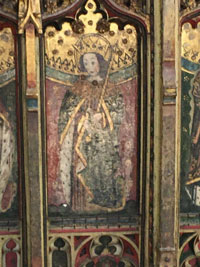
Henry VI Eye parish church c1480
|
|
1471
|
During the 15th century, civil war raged across England as the Houses of York and Lancaster fought each other for the English throne. In 1471, the Yorkists defeated their rivals in the battles of Barnet and Tewkesbury. The Lancastrian King Henry VI and his only son, Edward of Lancaster, died in the aftermath of the Battle of Tewkesbury. Their deaths left the House of Lancaster with no direct claimants to the throne. The Yorkist king, Edward IV, was now in complete control of England. Remnants of the House of Lancaster either submitted to Edward IV, or fled to France, including Jasper and Henry Tudor, who landed in the Duchy of Brittany under Duke Francis II.
Dr Heather Falvey :- "Although known today as an ineffectual king, many people in late medieval England regarded Henry VI as a saint on whom they might call for help at times of trouble, accident or illness. He was buried at Chertsey Abbey in May 1471 and the phenomenon of his saintly cult emerged soon after. He was venerated as a helper of the weak, sick or wrongly accused."
His image appears on several surviving East Anglian rood screens, such as this one at Eye parish church, supplied by Anne Willoughby. She notes, "Both Henry VI and Edward the Confessor have very feminine faces, but we think that these were later painting after the screen was defaced at the reformation."
|
|
1472
|
William of Worcester surveyed St Mary's church and included the Sanctuary and the crypt beneath in his
measurements, which remain the same today.
Both the sanctuary and crypt were provided by Jankyn Smyth although the exact date is not known, only to say that it obviously preceded 1479 and was probably during the 1470's.
In 1472 the Candlemas Guild revised its statutes to prepare it for the administration of the wills of Jankyn Smyth and Margaret Odeham. This guild, properly called the Guild of the Purification of our Lady in St James' Church, had come about after the Guild Merchant had been suppressed in 1327. Ostensibly a religious group, in practice it represented the local secular Establishment, and within what they could get away with under the Abbot's rule, they ran the town. Since 1470 they had the reassurance of Robert Gardiner's charter with the Abbot to confirm their basic rights and duties. Jankyn Smyth's land conveyance of the same date had named trustees, (later called feoffees), who were to administer his bequest on behalf of the Alderman and Burgesses of Bury St Edmunds, and they were probably all members of the Guild. The Guild met for its religious pursuits in the north aisle of St James' Church but it held its social and business meetings in the Guildhall. Thus either 1470 or 1472 could be said to be the founding of the Guildhall Feoffees, although this name does not seem to have been used until 1637.
|
|
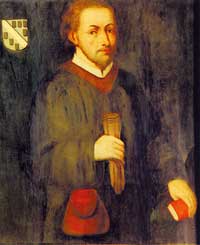
Jankyn Smith
|
|
1473
|
Jankyn Smyth made a further will concerning his property on 10th August, 1473, leaving an estate at Rougham, his house and more land in Bury to the alderman and 21 others. This property, and his 1470 conveyance, was for "relief and aid of the alderman, co-burgesses and the whole community and poor inhabitants of the said town of Bury Saint Edmunds in support of the burthens daily falling upon them." He was not to die until 1481, but this gesture would undoubtedly have been known to the Guild members. The people to whom the administration of the property would fall were known as Feoffees.
|
|
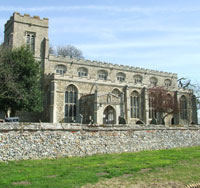
St Nicholas' Denston
|
|
1475
|
A new College of Priests was founded at Denston in 1475. John Denston had left provision for a college of chantry priests in his will to pray for the souls of himself and his wife and heirs, and all the faithful departed. He died in 1473 or 1474, and it was his executors who carried out his will. So, in 1475, King Edward IV granted a license to Sir John Howard and John Broughton to found a chantry for daily services for the good estate of the king and queen and the souls of John and Katherine Denston. The establishment was to be one master and two co-brethren. William Cooke wrote a history of this college, and one of the underlying reasons for it was to remedy as much as possible the diversion of tithes and lands to the use of monasteries to the detriment of the local church clergy. The system had been for the monastery that benefitted from the bequest to provide priests for the parish, but often the parish felt neglected, as the priests very rarely attended in the parish. By setting up a local college, it ensured that there would always be resident ministers who could carry out all of the regular parish duties on a daily basis.
The parish priest would be a member of the College to his own advantage. Various local churches became "affiliated" to the College, including Depden church. Otherwise many such churches would have obligations to the College at Stoke by Clare. Depden also had long standing obligations to the priory at Castleacre, arising from earlier links to the de Warenne family via the de Wancey family who were lords of the manor of Depden under the de Warennes.
St Nicholas' church at Denston was modified over the rest of the century to accomodate the needs of the college, and a property was built adjacent to the church for living quarters. Denston church has three aisles, and is very much like a minature copy of Lavenham church. About 42% of the church was allocated to the College priests at the eastern end; a division which is still marked by the position of the Rood Screen. All the chantry property would remain in use until 1547/48, when the endowment was sold off under the Act providing for the Dissolution of Chantries of Edward VI.
Another new Abbot, Richard Hengham, was appointed at Bury St Edmunds, and a further 100 marks of "cope money" was demanded from the townspeople for his inauguration.
|
|
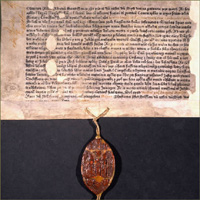
First English printing
|
|
1476
|
William Caxton set up a printing press in Westminster. Books were already being published for the general public, but they were produced in large scriptoria by teams of clerks who copied out texts by hand. Most such production had originated within religious houses, but for the last century, private businesses had hand published the works of Geoffrey Chaucer, John Lydgate, and a host of other classical texts in translation. Printing would now increasingly replace this hand copying.
The first item printed in England was made by William Caxton, and was an indulgence - a certificate written in Latin and issued by the Church. It gave the person who received it a reduction in the time that they had to spend in Purgatory (the place where souls were thought to go after death to spend time suffering before going on to heaven). John, Abbot of Abingdon, signed this indulgence for a couple called Henry and Katherine Langley. Early printing copied the look of manuscript books, which is why Caxton's indulgence looks like it has been written by hand.
William Caxton was born in Kent in 1421 and worked abroad as a diplomat and merchant. While in Europe, he became interested in the new technology of printing developed by Johannes Gutenberg during the early 1450s. Caxton returned to England and set up a printing shop near Westminster Abbey. He printed over 100 books before his death in 1491, including Chaucer's 'Canterbury Tales'. The design of the flat bed wooden hand-press used in Caxton's printing house remained the same, except for minor changes, for over 350 years.
In the printing process, ink was spread over the raised surfaces of individual metal letters held within a frame. The printer then pressed this against a sheet of paper, screwing down the press by hand. Printing presses were first invented in the Rhineland in Germany. The craftsmen there were used to building grape presses for making wine and applied the same methods to building printing presses.
Printing revolutionised life in Western Europe. Previously, all manuscript books had to be copied out carefully and slowly by hand. This was very expensive. Now it was quick to make lots of copies of books. This meant that books circulated faster. People had easier access to new ideas and new views of the world.
|
|
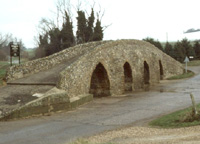
Moulton Packhorse bridge
|
|
1477
|
On 18th November, Caxton published the first book to be printed in English. It was a translation from the French work entitled "The Sayings of Philosophers."
In 1477 the Weavers' and Linendrapers' Guilds of Bury were allowed by the king to enact bye-laws to protect their prerogatives and privileges. Their formal incorporation in this way demonstrates their economic power at the time. Bury never quite had the amount of cloth producers as did Lavenham, but it was not far behind. In the same year the burgesses restricted the sale of cloth to specific days, and only then in the town's official Woolhall.
One decree forbade any weaver from owning more than four looms at any one time. This rule perpetuated the old system of independent weavers, who produced cloth on their own behalf, or on behalf of a clothier on an 'outworker' basis. There were to be no large weaving sheds or manufactories in Bury's cloth trade.
At this time it is believed that Suffolk was producing more woollen cloth than any other county in England. Suffolk would remain the industrial heartland of England until the 1520's.
Moulton, a village four miles east of Newmarket, is known for its 15th century Pack Horse Bridge, now maintained by English Heritage. The bridge is on the old Cambridge to Bury St Edmunds packhorse route and was one of the main arteries for Bury's wool trade. Its low parapet walls enabled the packs to swing clear and avoided the need for a wider, more expensive structure. However, it was probably not restricted to packhorses, as it is wide enough to allow the passage of small carts. It can still be used to cross the River Kennett, but nowadays the river is usually completely dried up. There was probably another packhorse route from Clare to Newmarket joining up with this route.
The River Kennett drains towards the north west, flowing into the Lee Brook at Freckenham, and thence into the River Lark between Jude's Ferry and Isleham.
Such was the strength of the local wool industry by now, that although they continued to pay tolls to the Abbot, he could no longer enforce the total control over weaving and fulling rights that his predecessors had done up to the twelfth century. In theory the abbot held the rights to all mills and perhaps all looms, but the weavers treated the looms as their own property by this time.
These wool and linen weavers rules and regulations included a reference to the Corpus Christi procession of Mystery Plays, performed in Bury at this feast time. Half of any fines levied for the breaching of the Guild Rules would be applied to finance the Pageant of the Ascension, which was well established by this time. "yt hath be customed of olde tyme owte of minde yeerly to be had to the wurschepe of God." It is quite likely that the version currently in use at Bury had been written or adapted by John Lydgate, the poet monk of Bury, who had died in 1449. But the custom of Passion Plays had been going on since 'time out of mind', as we have seen.
|
|
1478
|
The abbot, Richard Hengham, had several burgesses hauled into court for usurping his privileges. The alderman, Walter Thurston, had appointed Keepers of the Market, constables and watchmen, saying that he had ancient rights to do so. He did not seem to take any notice of the list drawn up in 1470 by Alderman Gardiner, and the abbot was able to prove that he was right by quoting the 1327 decisions of the court. Once again the town had done itself no favours as this produced yet another legal judgement against them in 1479, when the Star Chamber settled the case.
|
|
1479
|
In 1479-80 there was the worst outbreak of plague in Bury since 1361-62. Perhaps 15% of the population was killed.
Abbot Thomas Rattlesden was appointed, following Hengham.
This was the third new Abbot within the last 10 years at Bury, making due three payments of 100 marks each from the town. It is possible that Jankyn Smyth personally met the whole 300 marks, as there is a reference to this sum in a bidding prayer in praise of him.
|
|
1480
|
The Heigham family had Gifford's Hall built between Hartest and Shimpling. This was restored in 1904, and can still be seen today. A respected Vineyard has been established here in the late 20th century.
John Smyth of Bury, Esquyer, made his final will dated 12th December, 1480. Probate was granted on 20th September, 1481, and so the man we know as Jankyn Smythe must have died at some point in mid 1481. This will superceded his earlier wills, except in the case of the 1473 will, where he intended all those provisions for property that were in feoffees' hands to stand, " where it more pleynley appeareth." However, on his death, all the profits and issues arising from those properties would now be wholly converted and applied to the inhabitants of the town of Bury, and their successors. The money was to discharge certain impositions and charges "wont to be boryn the seid inhabitauntes."
|
|
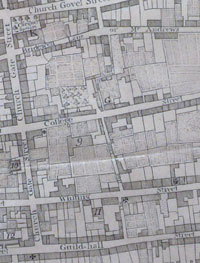
G=College of Jesus
|
|
1481
|
Jankyn Smyth died and he left several important bequests. One was to the College of Sweet Man Jesus, his chantry in College Street. A chantry was an institution where prayers could be said for the dead for a period of years upon payment of the appropriate fee or donation.
A priest called Henry Herdeman was granted a royal license to set up this chantry in 1481, together with a new Guild of Sweet Man Jesus whose sole purpose was to say prayers, a daily mass for the king, the queen and royal family and for the soul of the great benefactor, John Smith. Another bequest was to the Franciscan Friars at Babwell, but the bulk of his will went to 24 Guildhall Feoffees drawn from the Candlemas Guild. This fund was to pay for 2 masses on 28th June and 2nd February to remember Jankyn and then to pay the 100 marks or £67 feudal dues paid by the town to every new Abbot on his election. The money would come from rents on 238 acres of land in Eastfield, Southfield and Vinefield in the town as well as in Great Barton, Rougham, Fornham St Martin and Nowton.
|
|
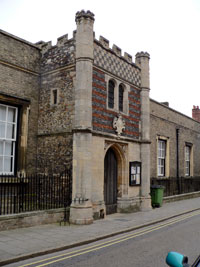
The new Porch at the Guldhall
|
|
blank |
Jankyn Smith's executors were charged with the duty of providing a safe place to store the money arising from his bequest to the town. This would result in a rebuilding of the porch on the Guildhall, to contain a strongroom above the entrance. An older porch, possibly dating back to the original building in the mid 13th century, can still be traced in the outside wall.
He made substantial contributions to many religious houses, and also to the town's other key guild, The Dusse of St Nicholas. Most of the other guilds also got something, as did the poor and the prisoners.
John Smith, or Jankyn Smythe, as some would say, was the greatest single benefactor of the Bury town burgesses and ordinary people in late medieval Bury St Edmunds. He had probably owned more property even than Richard Charman, a century earlier, and having very few, if any, heirs, gave it all away on his death.
His will is interesting in itself. It was written in English, and published by the Camden Society in 1850. It begins "I John Smyth, of Bury Seynt Edmude, esquyer ......".
|
|
1483
|
Edward IV died after a twelve year reign, on 9 April 1483. His young son, the boy King Edward V, reigned briefly from April to June until Richard III usurped the throne. Richard's reign began on 26th June, 1483 when he seized the throne from his twelve-year-old nephew Edward V. The boy Edward, and his nine year old brother Richard soon disappeared within the Tower of London, causing public unrest sufficient to encourage some armed rebellion. Across the English Channel Henry Tudor, a descendant of the weakened House of Lancaster, seized on Richard's difficulties and laid claim to the throne. Henry's first attempt to invade England in 1483 was frustrated by a storm, but he did not give up.
An Act of 1483 declared that any taxation without parliamentary approval was illegal. Broadly speaking this principle held true in Britain up to the present day. The king needed Parliament to vote him the taxation he needed to carry out his wars or other projects. Even Henry VIII withdrew his Amicable Grant in 1525, because the people resisted paying it as they thought of it as illegal without Parliamentary approval.
The Spanish inquisition began, and ushered in an era where the torture of heretics and supposed witches would become accepted and widespread. The Inquisition would last until 1834.
|
|
1484
|
John Wastell was an English master-mason, said to be one of the greatest of the last phase of English Gothic architecture. He worked under Simon Clerk at the Abbey of Bury St Edmunds, Saffron Walden Church, Essex (1485), and King's College Chapel, Cambridge, where he was active from 1486, by which time he appears to have been Clerk's partner. However, according to the Oxford Dictionary of Architecture and Landscaping, Bury was his normal place of residence, and he probably spent most of his time in the 1480s working on the Abbey there. The construction of fan vaulting seems to have been a hallmark of his work.
John Wastell was believed to have been born around 1460, and died in about 1515.
It has also been suggested that he worked on the nave at Lavenham Church, Suffolk (1495–1515), and St James's Church (now the Cathedral), Bury St Edmunds (1503–21). Dr Harvey confidently attributed the latter to Wastell.
Wastell's greatest surviving work was the completion of Kings College Chapel, Cambridge, where building operations began in 1508 and finished in 1515.
|
|
1485
|
From about 1485 another disease appeared on the scene to harry the people of Bury. It was called the Sweating Sickness, but although unpleasant it did not cause a significant number of deaths in the way that the plague could do. As if this was not enough, the disease Syphilis seems to have first reached England about this time.
On 16 March 1485, Richard III's queen, Anne Neville, died, and rumours spread across the country that she was murdered to pave the way for Richard to marry his niece, Elizabeth of York, daughter of Henry IV. The gossip alienated Richard from some of his northern supporters, and Henry Tudor, still in France, had himself hoped to marry her to secure a better claim to the throne. Henry Tudor assembled approximately 2,000 men and set sail from France on 1 August, intending to take the English throne. His force landed in Wales, and then proceeded into England, gathering supporters. By 22nd August the two opposing armies met at the Battle of Bosworth Field.
Richard III's most loyal subject was Sir John Howard, whom he had created 1st Duke of Norfolk in return for supporting him in his grab for the throne in 1483. The Howards held the manor of Stoke by Nayland. Howard was in command of one third of Richard III's 10,000 strong army. The Earl of Northumberland led another third. Richard III himself led the third part, positioned in the centre of the line of battle.
|
|
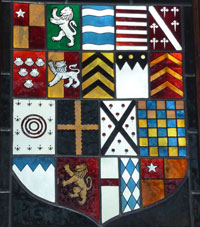
Lord Oxford's Great Shield
|
|
blank |
On the rebel side John de Vere, 13th Earl of Oxford, was Henry's principal military commander. The earls of Oxford owned the manor of Lavenham among other estates, although their family seat was at Castle Hedingham. Lavenham was generating huge amounts of cash at this time arising from the processing of wool into cloth. Oxford had joined Henry in France, and his presence raised morale in Henry's camp and troubled Richard III. Henry Tudor did not divide his force, but gave Oxford complete command of his whole army of 5,000 men.
Meanwhile Sir William Stanley and Thomas Stanley from Cheshire had also brought about 6,000 men to the battle but avoided taking sides until the outcome became clearer. Both sides sent messengers to invite the Stanleys to join them. After some fighting, Henry Tudor himself rode to parley with them. Seeing this, Richard decided to end the fight quickly by killing the enemy commander. He led a charge of mounted men around the melee and galloped into Henry's group, killing Sir William Brandon in the process. Richard had now exposed himself and the Stanleys decided to attack his small group, forcing them into marshy ground, where the king lost his horse. Overwhelmed by the numbers around him, the last Yorkist king died on the battlefield. Richard's forces disintegrated as news of his death spread. Northumberland and his men fled north on seeing the king's fate, and the Duke of Norfolk was killed.
Henry Tudor was crowned on the battlefield as Henry VII, and was the first Tudor King to come to the throne, founding the Tudor dynasty. Of his supporters, Henry rewarded the Stanleys the most generously. Aside from making William his chamberlain, he bestowed the earldom of Derby upon Lord Stanley along with grants and offices in other estates. Henry rewarded Oxford by restoring to him the lands and titles confiscated by the Yorkists and appointing him as Constable of the Tower and admiral of England, Ireland, and Aquitaine. For his brother, Henry created Jasper Tudor the Duke of Bedford.
Henry VII tried to present his victory as a new beginning for the country. Today some historians do indeed see it as the Middle Ages ending in 1485, and the start of the modern period. As for the view of William Shakespeare, writing around 1591, Richard III punctuates his entrance with the classic line, "A horse, a horse! My kingdom for a horse!"
|
|
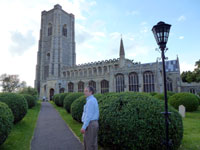
Lavenham Church today
|
|
blank |
In the aftermath of the battle, the 13th Earl of Oxford, John de Vere, lord of the manor of Lavenham, is said to have instigated the rebuilding of the church at Lavenham in order to thank God for his survival and to herald the new Tudor dynasty. He canvassed the rich Lavenham cloth merchants for donations, and the richest of all, Thomas Spring II gave 300 marks or about £200 to start the building of a new tower. The ending of the long years of the Wars of the Roses would mean that merchants and manufacturers could look forward to a new boom time.
|
|
1486
|
King Henry VII visited the Abbey at Bury St Edmunds shortly after his victory at Bosworth. He confirmed the immunities of the abbey, and its control over the town remained unshaken.
|
|
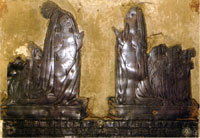
Thomas Spring II memorial brass
|
|
blank |
Around this time the tower of Lavenham's great church was begun. The mark of Thomas Spring II, a great wool merchant and clothier at the base indicated his involvement. Unfortunately Thomas Spring II died during 1486, only a year into Lavenham's church building programme, but his son, Thomas Spring III, continued with further lavish support for the project.
|
|
1492
|
Christopher Columbus reached the New World. Columbus was the commander of a Spanish expedition that set out to find a westward route to the Indies. On 12th October he stepped ashore in what was to become called the West Indies.
Margaret Odeham died in 1492, leaving a large number of bequests to church and town charities of Bury St Edmunds. She left money to two daughters and her late husband John had provided for his son. She still had so much property that she left as wide a number of bequests as John Smyth. There were large rural estates left to the Alderman's Guild, and even her large mansion on Skinners Row was left to the town.
In her will she refers to her town as "Bury Seynt Edmond" and "Bury Seynt Edmud's".
|
|
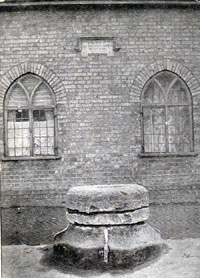
Spittle Houses and plague stone |
|
1494
|
In the council yearbook for 1896, there is a list of local charities. One of these is “Sir John Frenze, by deed , dated 20th April, 1494, gave property in Risbygate Street to Trustees, for the use of the sick lepers abiding in the house Out Risbygate.“ The trustees were the Guldhall Feoffment Trust by the 19th century, and the properties were by then almshouses, although still known as the Spital almshouses. The properties were probably rebuilt in 1606 and 1672, according to a plaque still in place up until 1909, when they were demolished to make way for an extension to Cornish and LLoyds foundry and premises.
The plaque on the wall behind the plague stone reads as follows: "ENDOWED BY / THE REVD JOHN FRENZE/ MCCCCXCIV, (1494)". The date 1606 is seen to the left bottom and something over 1672 at the bottom right.
Chalk Road was not called Chalk Road on the 1776 map, but was labelled “Spittle House Lane”, so this name was probably used soon after 1494, and lasted two or three centuries.
|
|
1495
|
The lands of the Honour of Clare had included a small part of Bury, around the Manor of Maidwater, apparently since the time of William the Conqueror. In 1495, they were granted in jointure to Queen Elizabeth, the wife of Henry VII. In 1509, they would pass to Katherine of Aragon.
|
|
1496
|
Possibly the first dissolution of a monastic house occurred when the Bishop of Ely acquired the small Benedictine nunnery of St Radegund outside Cambridge. He obtained a papal bull and a licence from the King to take possession of the priory, its lands and properties and displace the two nuns still in residence. He used the site to found Jesus College.
In 1496 Melford Church's great period of rebuilding was finished. John Clopton of Kentwell had been a leading contributor and driving force behind the work, although the Martyn Chapel had been rebuilt at the same time by the Martyn family of Melford Place on what is now called Chapel Green.
|
|
1497
|
John Clopton of Kentwell Manor at Melford died, and was succeeded by his son William Clopton who was now aged 47. The grandeur of Melford Church left behind by John Clopton inspired the Earl of Oxford and Thomas Spring at Lavenham to make Lavenham Church even grander than Melford. This may have begun a second burst of activity in the rebuilding of Lavenham church.
|
|
1498
|
In 1498 a burgess of Bury, called Reginold Chirche, died. He was a caster of bells, having taken over the Bury bell foundry in 1470. There is a bell on display in Moyse's Hall museum which bears his name. This bell was made for Hollesley Church in Suffolk.
After Reignold or Reginold, died, the business was taken over by his son Thomas. The Chirches were bell founders into the next century. In 1527, Thomas Chirche the bell founder, left a will in which he left 12d to every priest who bore his body to "chirche".
According to the anonymous Brief History of St Peter's Church at Fakenham Magna, that church contains a treble bell cast in Bury St Edmunds around 1500. It is a 26 inch diameter bell, weighing about 4 cwt, but no maker's mark has been identified. Two other bells date to after the Reformation.
|
|
1499
|
From 1499 to 1500 the plague struck Bury yet again. Many people died from it.
|
|
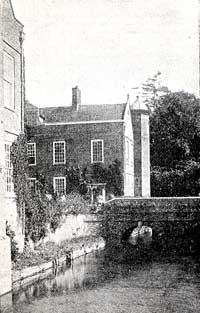
Rushbrooke Hall
|
|
1500
|
It is thought that the initial building of Rushbrooke Hall began in 1500 for the Jermyn family. The picture shows the east wing which was probably the original hall of around 1500. By 1552 work was well under way on the building of the central range and west wing. The hall had an ornamental moat.
The family prospered under Henry VIII, and Sir Thomas Jermyn was once referred to as "the best housekeeper in Suffolk". By the time of Elizabeth I, his families wealth would be challenged by Sir Thomas Kytson's great house and estates at Hengrave Hall.
In 2016 Nick Amor published his book, "From Wool to Cloth - the Triumph of the Suffolk Clothier." One of his conclusions was that by 1500 Suffolk was the leading cloth making county in England, making 5,000 broadcloths a year. The London market was crucial to this success. In the years 1480 to 1500 Suffolk had 100 clothiers, whereas Essex and Kent had about 50 each. These might range from being relatively poor to being mega-rich, with Thomas Spring III of Lavenham, (c1474-1523) being the archetype rich clothier, taking over from his father, Thomas Spring II (d 1486).
In his 2007 book "Medieval Suffolk", Mark Bailey wrote that:
"One could claim that by c 1500 this (Suffolk) was the most industrialised and urbanised county in England: indeed, at this date one might reasonably regard Suffolk as the most likely candidate to become the first industrialised region of Britain." In 1300 eastern Norfolk and the Lincolnshire fenlands had been the thrusting commercial centres of England. By 1500 Suffolk shared this distinction with Devon. By 1700 Suffolk would decline into a rural backwater.
The lack of coal and iron ore would, of course, be the main reasons why it did not gain the full fruits of the industrial revolution.
At Hawstead, Roger Drury died, and was succeeded by his son Robert.
|
|
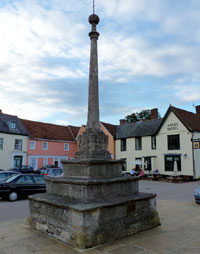
Lavenham Market Cross
|
|
blank |
At Lavenham, William Jacob, one of that town's many rich clothiers, left in his will that a new market cross should be erected at his cost on the Market Hill in Lavenham. It was to be a copy of the market cross at Cambridge. Today the Cambridge Cross is lost to us, and only the base at Lavenham survives with a later shaft, dated to 1725.
|
|
1501
|
Michelangelo started work on his statue of David, and it would be finished by 1504, and put up in the square at Florence.
|
|
1502
|
Robert Drury applied to the Pope for the right to have a private chapel on his manor at Bokenham's in Hawstead. This was probably already in existence, but lacked official approval according to Sir John Cullum in 1784.
|
|
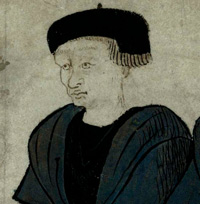
Abbot William Bunting 1512
|
|
1503
|
Under Abbot William Bunting work begun on extending St James' Church in Bury St Edmunds westwards partly to give it a street access, and partly as a major improvement. Three shops were demolished to provide the space needed. The resulting nave survives today, and was probably the work of John Wastell, the Master Mason of the abbey, who lived in Bury. The work would take many years, probably not being completed until 1551.
Dr Francis Young recently announced that he had discovered this portrait of Abbot William Bunting, also called William de Coddenham, dated to 1512. He writes:-
"William Bunting was the penultimate abbot of St Edmunds; he was the abbey’s cellarer when he was elected to succeed Thomas Rattlesden in 1497. Bunting played a role in the early career of Thomas Wolsey, presenting the future cardinal to some of the abbey’s ecclesiastical livings, but his lasting achievement was the decision to rebuild St James’s church in 1503. Originally built by Abbot Anselm in partial fulfilment of a vow to visit the shrine of St James at Compostella, the old church was in a poor state of repair by the early 16th century. Abbot Bunting constructed an impressive nave and aisles, which survive, together with a chancel that has long since gone."
John Salter left tenements and land in Bury to the Gild of the Purification of the Blessed Virgin Mary, which he wanted administered on the same terms as the will of Jankyn Smyth. As far as we know, Smith's will was administered by a separate group of feoffees, but the guilds were always inter related by mixed memberships, and may at this time have been the same people, wearing different hats, as we say.
Leonardo da Vinci painted the Mona Lisa.
|
|
1505
|
Margaret, Countess of Richmond and Derby, mother of Henry VII refounded Christ's College at Cambridge. She bought up several small monasteries to endow Christ's College with their properties, including North Creake in Norfolk.
Little Saxham was divided into three manors called Larges, Geddings, and Graces, but by 1490 they were all held under a single ownership. They were inherited in 1490 by Roger Darcy, but in 1505 Darcy sold the three manors of Little Saxham, together with some land in Risby, to Thomas Lucas, for the sum of £240.
In 1505, Thomas Lucas was Solicitor General to King Henry VII, a post he had received a year earlier. Thomas immediately set about building a Hall that was to be a splendid example of its time. It was probably built on the site of the old manor house of Large's. It took some eight years to complete, but it was to be a massive construction. From 1505 to 1514 Little Saxham Hall was built at a cost of £1,425.
John Gage, in his History of Thingoe Hundred, written in 1838, described Little Saxham Hall as follows:
"It was one of those picturesque, brick, embattled manor-houses, with towers, irregular gables, finials, and clusters of ornamental chimney..the style of which prevails in an inferior degree in the neighbouring Hall of Westow. It was moated, fenced with deep ditches, and approached by a causeway, having a drawbridge across the moat, and a tower gate-house. There was an outer and an inner court, with bay windows to the hall and parlour embattled, a fumerel rising in the centre of the hall roof; and the tower staircase, as well as the gate-house, was crowned with vanes."
There had been members of the Lucas family living in West Suffolk probably since the 12th century. They had filled the posts of aldermen and bailiff of St Edmundsbury at various times in the 13th and 14th centuries. Thomas Lucas had gained his preferment through being Secretary to Jasper, Duke of Bedford, an uncle of King Henry VI.
At Hawstead, the manor of Bokenhams had been held by Sir Robert Drury's family since 1464, while the principal manor of Hawstead was in the hands of Sir William Clopton. Clopton now sold Hawstead Manor to Sir Robert Drury. The Drurys now engrossed almost the whole village, and the joint manor was now technically known as Hawstead with Bokenhams. Drury would proceed to buy up any other parcel of land in the village which came up for sale.
|
|
1507
|
During 1507 the city of Norwich suffered a series of fires which destroyed 700 dwellings. Norwich was probably the second biggest city in England at the time, but much of the city would still lie in ruins 30 years later. Timber framed houses with thatched roofs would stand along narrow alleyways which would also include bakehouses, stables with haylofts, and brewhouses. All heating and lighting depended upon open flames. Any small initial accident with fire could spread easily in these conditions.
|
|
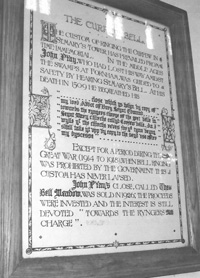
Plaque recording the Parfay bequest
|
|
1509
|
In 1509 John Parfay, a draper, bequeathed to the churchwardens of St Mary's a piece of meadow in Fornham All Saints "..towards the ryngers charge of the gret bell in Seynt Marychirche, callyd Corfew belle". Parfay is said to have lost his way in the marshy land between Fornham and Bury and was guided home by the sound of this bell. The curfew was not in the modern sense a signal to stay indoors, but to extinguish household fires. The land situated in Fornham Road was sold by the church in 1926, but the name Bell Meadow still survives".
Henry VIII inherited the crown and would rule until 1547, bringing a period of tremendous social change. The country had rejoiced at the death of Henry VII, because of the very tight rein he had kept on his subjects. The new king married his older brother Arthur's widow, Arthur having died in 1502. Katherine of Aragon now inherited the lands of the Honour of Clare, including those within Bury in the manor of Maidwater. The town of Bury had been fairly quiet under Henry VII, but now there began further unrest against the rule of the abbey.
Unfortunately the plague again struck the people of Bury.
|
|
1510
|
Sir Robert Drury had been a privy councillor to Henry VII, and soon after the accession of Henry VIII, he obtained royal permission to improve his estates in Suffolk. His moated home was at Bokenhams, which he later re-named as Hawstead Place, at Hawstead, just outside Bury St Edmunds. Permission was given to crenellate all of his manor houses at Hawstead Hall, Bokenhams and at Onehouse in Suffolk. He was also given permission to empark his lands, and he would then import deer for hunting purposes. The emparking extended to 2,000 acres of farmland and 500 acres of woodland in Hawstead, Whepsted and Horningsheath, the latter now known as Horringer. This showed that he was one of the aspiring new gentry of the age. The Drurys would become so wealthy and influential that Hawstead Place would be visited by Queen Elizabeth in 1578.
|
|
1511
|
John Parfay, a prominent draper of Bury, left enough money in his will to pave the entire road from South Gate to Ipswich. In the same year there were other road improvements. All the bridges over the Linnet were fixed and a Civic Road Repair Fund was set up. Since 1450 the wealthier townspeople gave up leaving money to the abbey, and instead left it to repair and improve the public buildings, roads, bridges and gates of the town, or to improve the parish churches of St James and St Mary. Parfay himself also left money in 1509 to cause the bells of St James to be rung every evening at Vespers.
|
|
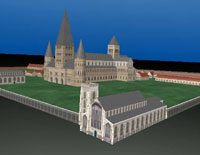 View of virtual abbey
View of virtual abbey
|
|
1513
|
The town and abbey of St Edmund were probably by now in the forms in which we still know them today. Although now ruined, the layout of the abbey is preserved within today's Abbey Gardens, and has led to a number of speculative reconstructions over the years. Some of these can be seen as paintings in Moyse's Hall Museum, and a cork model was produced in the early 20th century which no longer seems to exist except within some people's memories. The most ambitious attempt at a reconstruction took place in 1998, when a company called PERA were commissioned by the council to produce a Virtual Reality model of the town and abbey. With sponsorship from the brewers Greene King, and assistance from local archaeologists and historians, the "model" was produced, existing only by way of three-dimensional computer modelling.
The project is described more fully, with video links, here: The Virtual Reality Abbey
Alternatively, you can go straight to see a short six minute video version on YouTube here:The Virtual Abbey of Bury St Edmunds Video
|
|
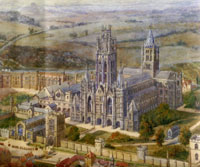
St Edmunds Abbey by W K Hardy 1883
|
|
1514
|
A new abbot was appointed, Abbot John Reeve, a man from Melford in Suffolk. Like all monks he changed his last name to his place of origin when he entered the priesthood, and so became John de Melford. He would rule until the Dissolution in 1539, and thus would be the last Abbot of the great abbey of St Edmund.
The abbey of St Edmund, which he now ruled, was one of the grandest in Europe. W K Hardy attempted to reproduce how it may have looked in this painting from 1883. However, it would be unwise to rely too much upon the details shown, as we just do not know its full appearance.
John Reeve had an affinity with Melford Hall, as it was in his home village, and as it was already one of the Abbot's country homes, he proceeded to rebuild it in a grand style.
Little Saxham Hall was completed at this time as a residence for the Lucas family.
|
|
1515
|
Thomas Wolsey of Ipswich, better known as Cardinal Wolsey, became Lord Chancellor of England. In practice this made him the King's first minister, a position he would hold until 1529.
|
|
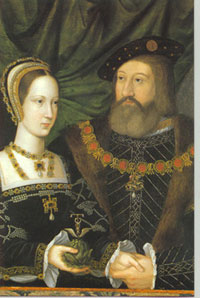
Mary Tudor and Charles Brandon
|
|
blank |
Mary Tudor also known as Mary Rose, Queen of France, was the sister of King Henry VIII, and had been married to King Louis XII of France. Following his death on New Year's Day, 1515, only three months after the marriage, she was courted by the son of King Louis. She was persuaded to stay in France for six weeks to ensure that she was not pregnant with a possible future French king, but she was obviously keen to return to England.
Henry VIII sent Charles Brandon to France to escort her home, but while in France the couple were secretly married.
Once back in England the king was at first angry with Brandon for marrying Mary behind his back, but faced with this fait accompli he ennobled him. However, the king insisted upon a public wedding in England, and so she
married Charles Brandon in May at Greenwich. Brandon was then made the Duke of Suffolk by the king. When Charles Brandon was created Duke of Suffolk by Henry VIII he was also granted the Honour of Eye. Later Brandon would gain other rewards for dealing with civil unrest in East Anglia.
Westhorpe manor was an old house near the centre of the land holdings known as the Honour of Eye. At Eye itself was an old castle in a poor state, hemmed in by streets, the market place and dwellings of the common people. Mary Tudor decided that it was better to redevelop a palace at Westhorpe, rather than be constricted by the old manor headquarters in Eye. Thus a fantastic new palace was built at Westhorpe for the Duke of Suffolk and his royal wife, often referred to as the French Queen. Sadly, only a few tiles, the remnants of a moat, and a bridge remain of this great palace today.
|
|
1516
|
Thomas Lucas owned Little Saxham, and had recently finished the construction of his great house at Little Saxham Hall. He seems to have been on poor terms with Cardinal Wolsey, the Lord Chancellor, and was sent to the Tower for a short period in June 1516 'for speaking scandalous words of the Lord Cardinal'.
|
|
1517
|
In Germany Martin Luther sparked off the Protestant movement. By the 1520's some English intellectuals would follow his ideas.
|
|
1519
|
Cardinal Wolsey first proposed reform of the monasteries when he became Cardinal Legate. Wolsey was born in Ipswich and had a brilliant career at Oxford before becoming Chaplain to Henry VIII and then his Lord Chancellor in 1515.
Meanwhile Cortes was conquering the Aztecs.
|
|
1520
|
In 1520, Cardinal Wolsey visited Abbot John de Melford at Bury, on route to Walsingham. William Adams and John Hawkyns were two Bury burgesses leading the town's attacks upon the abbot's high rents and exactions upon the town. While avoiding appearing in court to contest these charges, the abbot had the two men arrested and brought before Wolsey in the abbey. The abbot demanded to know all the names of the townsmen who were behind the two men. It was shown that many townspeople had contributed money to take legal advice, and to help fight the case in court. The abbot then had these men arrested as well, and bound them over for £100 not to bring any law suit against him in future.
John Crofts acquired lands at West Stow, probably in order to raise flocks of sheep. In 1526 he would lease West Stow Hall from the Abbot of St Edmund's. The abbot may have used it as a hunting lodge at first, and Crofts would extend the Hall to include its well known gatehouse in the 1530s.
In 1520, Henry VIII held the event known as the Field of the Cloth of Gold, in order to impress the French King. It was called the eighth wonder of the world, but in order to pay for it, massive taxation was levied on the English people. In Bury, as elsewhere, everybody worth under 40 shillings had to pay a subsidy of five percent. For those worth over 40 shillings, the rate was two and a half percent.
|
|
1521
|
A wealthy London merchant, Sir Thomas Kitson, purchased the manor of Hengrave. In later years he would extend his holdings to become one of the great Suffolk landowners. Kitson or Kytson had bought the estate of Hengrave from Edward, Duke of Buckingham, in 1520 or 1521. The Duke was subsequently beheaded in 1521, and for a time the King seized the estate for himself, having backdated the Bill which condemned Buckingham for 4 years. Kytson managed to persuade him to let the estate remain in his hands.
Hengrave Hall was started in 1525 for Sir Thomas Kytson.
|
|
1522
|
Henry VIII tried to draw up his own version of the Domesday Book called the Military Survey or the Muster Rolls. Lord Walsingham wanted to establish the Country's fiscal base in order to levy a fair rate of taxes. Its official purpose was "for mustering the King's subjects" and establishing "the true extent of rents and revenues". This 1522 Muster Roll is important evidence of the population at the time. It listed the heads of household, occupation and their wealth.
In Bury and surrounds the Muster Roll found 6,476 men of which 2,900 were able bodied for service in the military. Robert Gottfried has assumed that the Borough's population might have been 5,438 based on an analysis of the evidence, and applying certain formulae.
Work by John Patten in 1979, would suggest that this figure was far too high. His estimate for 1525 was 3,550. In any event this made Bury the largest town in Suffolk at this time.
The Muster Roll survives for the hundred of Babergh and lists 157 heads of household in Lavenham. Thirty three were listed as clothmakers together with fourteen weavers, three fullers, three dyers and three shearmen. Betterton and Dymond estimated that probably half of Lavenham's working population were involved in cloth making. They also point out that the 33 Lavenham clothiers, who financed and organised the other trades and then sold the finished product, was an unusually high proportion of the total industry. Glemsford had 20 clothiers, Nayland had 14, while Melford and Sudbury had only 8 each. While Lavenham recorded only 14 weavers, Boxford had 37, but only 11 claiming to be clothiers. Fullers needed a good water supply and there were 9 at Melford, 6 at Bures and 5 at Sudbury. The highest numbers of shearmen were in Nayland, with 9, and Boxford, with 6. Thus it seems that villages seemed to have developed their own local specialisms to some extent.
A new disease called Typhus first struck Bury this year. This year the outbreak was not too bad, but it would recur worse in the future.
|
|
1523
|
The abbot of Bury was appointed by the king to extract further taxes from men worth over 40 pounds. The same happened elsewhere.
In 1523 Thomas Spring III died at Lavenham, and his will was proved at St Paul's in London on 3rd July. Among his many bequests, he left 40 shillings to the Friars at Babwell. He wrote "I give and bequeath to every house of Friars of Clare, Sudbury, Babwell, two houses of Friars in Thetford, and the Nunns of Thetford to pray for my soul and all my benefactors' souls and to every of them xls."
"Item, I give and bequeath to the furnishing of the steeple of Lavenham two hundred pounds". He also left 1,000 marks for the repair of highways around Lavenham. Despite these lavish gifts to the church at Lavenham and to the West Suffolk friaries, like many other wealthy men at this time he did not feel inclined to leave money to the Abbey of St Edmund, or to any other monastic institution.
|
|
1524
|
The Bishop of Rochester used the properties of two poor nunneries to supplement the income of St John's College at Cambridge.
By this time, Cardinal Wolsey had also decided to found a new college at Oxford, to be known as Cardinal College, later as Christchurch College. In 1524 he obtained a papal bull to dissolve 21 religious houses and he persuaded the King to let him use their revenues on his new college. In Suffolk the list of closed houses included Dodnash and Snape with Blackmore, Horkesley, Stansgate, Thoby, Tiptree and Wix in Essex. Wolsey sent as his agents John Allen and Thomas Cromwell in the first concerted moves to reform monasticism in England.
The Lay Subsidy of 1523 and 1524 was a record of taxes which allows us to see that Lavenham was ranked fourteenth in wealth of English towns at this time with an assessment of £402. Thomas Spring III of Lavenham paid more tax in 1523 than any other layman in England. The source of this wealth was the rise of the industrial production of cloth. The water powered fulling machine, cheap local labour, a ready supply of local wool, and the drive and energy of local entrepreneurs had pushed the Stour Valley to the forefront of English Industrial output in these years. Three generations of Thomas Springs were the main Lavenham Wool producers. Much of this cloth was sold through the market at Bury in competition with the ports of Colchester and Ipswich. The road from Lavenham to Bury, called Buryweye, was the most heavily travelled route in West Suffolk.
Bury was ranked just above Lavenham at 13th with a subsidy assessed at £405, barely any different. If Bury and Lavenham are considered together as an economic unit, they would together rank 7th in the land for combined wealth.
At this time London was first at £16,675, but Norwich was 2nd in the land at £1,704. Ipswich was 8th at £657, Kings Lynn 9th at £576, and Colchester was 12th at £426.
|
|
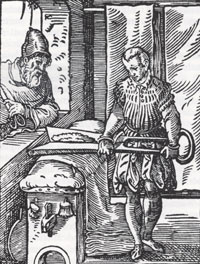
Shearman at work
|
|
blank |
By now the burgesses of Bury and its surrounds were wealthy independently of the Abbey of St Edmund. Occasionally the Lay Subsidy for Bury St Edmunds mentions a man's occupation, and sometimes we can glimpse Bury's cloth industry. In Risbygate ward both William Brown and Richard Burdon were described as "sherman", paying 4d each in tax, the same amount as a domestic servant. Another "sherman" was John Thomson, also assessed 4d. In North ward, John Kyng was a "sherman" at 4d, while Thomas Orsby was a weaver paying 4d, but Thomas Bull weaver paid 1/-. In the West ward, Robert Baker was a fuller paying 4d, while Edmond Tailour, a "sherman", paid 2/-. I am assuming that a "sherman" was a shear man, a trade in the cloth trade which cut the nap on the finished cloth using a large pair of shears. Old illustrations show these shears as formidable iron tools of considerable size. It is unclear why this trade should be mentioned in the Lay Subsidy for Bury, when most individuals do not have a trade recorded.
As for population, this is very hard to estimate. Work by Dr John Patten in 1979, would suggest that Gottfried's figure of 5,438 for Bury was far too high. Patten's estimate for 1524/25 is 3,550 for Bury and 3,100 for Ipswich. In any event this still made Bury the largest town in Suffolk at this time. By 1603 Bury would be overtaken in size by Ipswich. Lavenham was at the peak of its prosperity in the 1520s, but Betterton and Dymond had estimated its population as a mere 1,100 people.
|
|
1525
|
The great tower of Lavenham's church was finished. Started by Richard Spring II, his son's heraldic shield at the top shows that Richard Spring III, the great clothier largely paid for its completion. At his death in 1524, his widow was worth £1000. In Suffolk her wealth was exceeded only by the Duke of Norfolk. Spring had owned 26 manors and much other property and was probably the richest commoner in England.
Taxation was racked up once again when the king ordered a levy of one sixth of every man's estate. This so-called Amicable Grant was made by Henry VIII without Parliamentary approval. Tax rises had been levied from 1523 to 1525, and the prospect was for further increases to come in the next two years. The wealthier clothiers of the Stour valley certainly felt the pinch. They would have found that they had less working capital available to fund their operations, and as a result it seems that the spinners, weavers, dyers and fullers who relied upon cloth production found their work reduced by the clothiers. They began to experience unprecedented setbacks and hardships.
This was the last straw for some people, driven to desperation.
Steadily rising prices, higher taxation and a decline in the broad cloth industry led to an uprising of 4000 people around Lavenham and Brent Eleigh, with lesser riots in Bury and Cambridge. Suffolk was a centre of resistance to this new tax. Cardinal Wolsey wrote a series of urgent despatches to the Dukes of Suffolk and Norfolk who managed to contain the situation. They identified Lavenham as the centre of discontent, and recruited John Spring the eldest son of Thomas Spring III, and Sir Thomas Jermyn of Rushbrooke as intermediaries. These were local men, known to the population, and were able to warn of the grave consequences of what would be interpreted as high treason without arousing further resistance. Spring took more direct action in suppressing the Lavenham revolt by the simple action of removing the church bells of Lavenham so that the rebels could not be called to arms.
Such recessions in the cloth industry now continued in the rest of the 16th century as work for spinners, weavers and finishers fluctuated down as well as up. Vast amounts of cloth were still produced, but the continuous boom from the 1470's to 1520 was over. Suffolk broadcloth now faced a long slow decline in popularity.
|
|
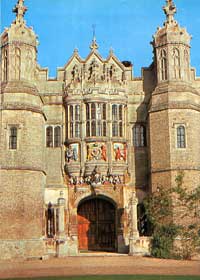
Hengrave Hall
|
|
blank |
There were still many extremely wealthy merchants like Thomas Kytson, who would build Hengrave Hall from 1525 to 1538 at a massive cost of £3,500. The hall was built of brick and faced with stone. Building materials were brought to Hengrave by barge up the River Lark. Kytson's sister Margaret was married to John Washington, and Kytson would employ their son, Thomas Washington, as his agent in Flanders. George Washington, a direct descendant, became President of the United States of America.
|
|
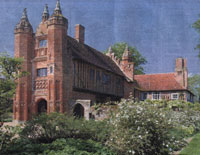
West Stow Hall by 2009
|
|
1526
|
Holinshed's Chronicle recorded the alarming rebellion in Suffolk in the area of Lavenham, Hadleigh and Sudbury, rumbling on since 1525. Many of the insurgents had been brought to Bury.
In 1526 some of the rebels from Lavenham and Brent Eleigh were brought there before the Earls of Suffolk and Norfolk, who held a court in Bury. They knelt in their shirts and pleaded that they misbehaved for lack of work. After receiving a royal pardon, things were quietened down, but the hardships continued.
As part of his money raising exercise at this time, the manor of West Stow was leased by the Abbot of Bury St Edmunds to Sir John Croftes. Sir John was a substantial flockmaster, or sheep farmer, who would eventually purchase these lands from the Crown in 1540, after the Dissolution of Bury Abbey. The building of West Stow Hall possibly pre-dates Sir John's acquisition of it and therefore might in fact have been built by the then owner of the manor, the Abbot of Bury. The ornamental gatehouse is thought to have been added around 1530, and therefore this addition would have been built by Croftes. Sir John Croftes other distinction was that he was 'Master of the Horse to Mary Tudor', Dowager Queen of France and Duchess of Suffolk. Mary Tudor was currently living at Westthorpe in Suffolk, and would die in 1533.
|
|
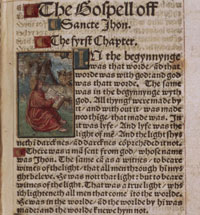
Page from Tyndale's New Testament
|
|
blank |
In 1526 William Tyndale published a translation of the New Testament in English, which was immediately denounced by the English Bishops. By now he had been forced to work abroad, and his books were printed in Worms and Antwerp and smuggled into England. One of Tyndale's supporters was Humphrey Monmouth, a London wool merchant. Monmouth dealt in Suffolk cloth, and seems to have brought back some of Tyndale's books from the continent and introduced them to Protestant leaning Suffolk clothiers. He certainly showed some to Dr Stockhouse, the rector of Lavenham, in 1528. Stockhouse found no fault with them, and must have had Protestant leanings himself. Nevertheless, these books were illegal, and Monmouth would be imprisoned for distributing them.
|
|
1527
|
We know that the Bury St Edmunds town wall was still in existence at this time, as leases were issued to landowners just inside the walls to make gates through it to the land beyond.
In 1527, Thomas Chirche the bell founder, left a will in which he left 12d to every priest who bore his body to "chirche". Thomas had run the Bury bell foundry since his father died in 1498. The bell foundry now passed into the hands of Roger Reve, who owned it until 1533. Perhaps oddly to us, the foundry used the stamp bearing HS as their foundry mark throughout this period. HS had set up the foundry in about 1450.
St Andrew's church at Tostock boasts two bells from Bury of this period. They are as follows:
Bell number 2. 'Sanct Petre ora pro Nobis' - 1527 or thereabouts, cast by Robert Reve of Bury St Edmunds. The dedication means, "St Peter pray for us", and the bell is called St Peter by the ringers. This bell carries an unique maker's mark. Over the centuries the rim has been chipped away in an effort to improve the tone but to no avail.
Bell number 3. 'Sancta Maria ora pro Nobis' - also cast in 1527 by Robert Reve. This bell was badly cracked and has been repaired by Soundwell of Lode. The dedication means, "St Mary pray for us", and is called St Mary.
The church at Tostock also has a treble bell from about 1460, a tenor from 1671 and three modern bells dated 1999 from Loughborough. The new peal consists of the new treble, the new second, the 1460 bell, St Andrew of 1999, St Mary and the tenor of 1671. St Peter could not be improved, and so has been hung separately as the chiming bell. The first ring of the new peal took place on Christmas Day 1999.
Thomas Turner of Haverhill was very active in the apprehension and examination of non-conformists in that area. Eight Lollards were discovered at Steeple Bumpstead and were tried for heresy.
|
|
1528
|
Cardinal Wolsey continued his reforms by obtaining papal bulls to close all monasteries with less than six religious persons. Other monasteries of the same order with less than 12 religious persons were to be united. Wolsey intended the revenues of these closed houses to be used to finance a new College at Ipswich, at St Peter's Priory, but this foundation never materialised. Only its rather grand gates were built, and surprisingly these survive today in Ipswich. Seven houses were suppressed including in Suffolk, St Peters at Ipswich, Felixstowe, Flixton and Rumburgh. Bromehill was closed in Norfolk. Thomas Cromwell was again his agent in this work.
Cardinal Wolsey was instructed by the King to obtain a divorce for him from his wife, Catherine of Aragon. Wolsey sent his private secretary, Stephen Gardiner, to Rome, to present the case to the Pope. Gardiner succeeded in obtaining significant concessions, but never got as much as the King wanted.
Stephen Gardiner was born in Bury St Edmunds around 1483, probably in the house of John Gardyner on Le Mustowe. It is believed that this property was on today's Angel Hill, on the site of the Borough Offices.
His father is known to have been John Gardiner, a substantial cloth merchant of St Edmundsbury, (see his will, printed in Proceedings of the Suffolk Archaeological Institute, i. 329), who took care to give him a good education. His mother Helen was reputed to be an illegitimate daughter of Jasper Tudor, 1st Duke of Bedford.
Stephen Gardiner was extremely able and well educated and became Master of Trinity College Cambridge for 24 years from 1525 to 1549. The Duke of Norfolk introduced Gardiner to Wolsey, and so Wolsey engaged him as his Private Secretary in 1525, a post much different from how we would see the job today.
The cloth industry continued to experience problems. English cloth merchants were reported to be detained in Flanders. London merchants then refused to buy Suffolk cloth because they were afraid it could not be exported through Flanders. In May this caused the clothiers to stop putting work out to the weavers and the rest of their suppliers.
There was a rising of poor men in Bury, which was put down by Sir Robert Drury. It had taken three years before the effects of the 1525 tax levy, and conditions in general, had got so bad that Bury was driven to action. Their leader was called Davy, and there were two or three hundred others ready to march to London and beg the king and the cardinal to remedy their wretchedness. Sir Robert acted promptly to stop the whole idea.
Cardinal Wolsey himself set out to persuade the London merchants to buy Suffolk cloth again by discounting all the rumours of trouble abroad.
|
|
1529
|
Cardinal Wolsey lost his post as Lord Chancellor before he could set up the Ipswich College. At Bury at least one lease was granted to a private individual to take over a house and orchard south of the Norman Tower but inside the abbey walls.
Despite the rise of Protestant ideas among some intellectuals the Religious Guild movement flourished in the early 1500's. Several new timber framed guildhalls were built in Suffolk. The most notable was at Lavenham, where the Corpus Christi Guildhall still dominates the market square. Built in 1529 it was probably one of the last such religious guild buildings to be made before the Reformation swept away the religious guilds.
|
|
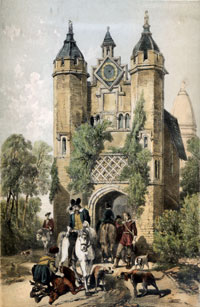
West Stow Hall Gatehouse
|
|
1530
|
At West Stow, Sir John Croftes was improving West Stow hall by the addition of the highly decorative brick gatehouse. He had leased the manor of West Stow from the Abbot of Bury St Edmunds in 1526. Sir John Croftes was 'Master of the Horse to Mary Tudor', Dowager Queen of France and Duchess of Suffolk, and he had her coat of arms placed over the door to the gatehouse by way of a compliment to her. (Mary Tudor would die in 1533.) Sir John had made his money as a substantial flockmaster or sheep farmer, and it is likely that he ran sheep on these lands at West Stow. The manorhouse was conveniently located on the Wordwell stream, giving it a reliable water source throughout the year in this dry part of Suffolk.
By 1530 the abbey of St Edmund was considerably weakened by years of selling, or leasing off, its lands, and borrowing money to try to meet its running expenses. The standard of living of the abbots and the main officers were those of great Lords, and little attempt was made to cut back. Bad management resulted in sales of assets to make ends meet, but this was bound to store up problems for the future. A. Goodwin believed that the abbey had sorted itself out by the Reformation, but Lobel and Gottfried agree that the opposite was the case, and the abbey was in accelerating decline by this time. By 1539 the landed estates of the abbey were less than half the size of the 1290's, but it was still the biggest landowner in West Suffolk.
Bury itself was full of abbey tenements and holdings, many of which were in decay and even ruinous, giving a tumbledown feel to streets west of the abbey. However, many of the burgesses were wealthy and had moved to better areas of the town, maintaining prosperous lives independent of the abbey's decline. Bury would not collapse just because the abbey was in trouble.
Henry VIII now charged Cardinal Wolsey with high treason. His crime was that he had been unable to persuade the Pope to annul the King's marriage to Catherine of Aragon. Henry was desperate for a male heir, and hoped that a new wife, Anne Boleyn, would provide this. On his way to London to face charges, Cardinal Wolsey was taken ill and died in Leicester Abbey. He had lost his job as Lord Chancellor which he had held from 1515 to 1529, but had been Archbishop of York since 1514, a Cardinal since 1515, and Papal Legate since 1518. If he was really the son of an Ipswich butcher, as legend has it, then his was a most remarkable achievement.
Stephen Gardiner, who had assisted Wolsey in the attempt to achieve a divorce, does not seem to have been damaged by Wolsey's fall. Indeed, he became favoured by the King, who persuaded the Pope to make him the Bishop of Winchester.
The last major outbreak of the plague occurred in Bury, following 50 years of outbreaks. However, by this time, the death toll from plague had declined, and inward migration had helped to replace the population levels. Robert Gottfried has suggested that by the time of the Reformation the population of Bury may well have regained its pre-plague levels.
|
|
1531
|
Henry VIII agreed his Bill of Sewers, and appointed a Commission to maintain sewers. In those days a sewer was not meant to take solids. A sewer was understood to be a watercourse, pipe or tunnel to take rainwater from streets and house roofs to prevent flooding and undermining of property, and from fields to drain crops. Disposal of solid waste was considered a private matter, and the privy usually discharged to a midden in most towns.
Sir Thomas Lucas of Little Saxham Hall died in July, 1531. In his will, he left various bits of manor land to John Lucas, one of his two remaining sons (the eldest, Jasper, had died before his father) and Little Saxham Hall to his grandson Thomas, who was still a minor at the time.
Also in his will Sir Thomas Lucas left £49 for the mending of highways, "and especially for the waie called Cheverton Way." The Cheverton, or Chevington Way, would have been the main route into Bury from Little Saxham Hall. Lucas had been Solicitor General to King Henry VII. Public facilities at this time often relied upon such personal generosity for their maintenance.
|
|
1532
|
John and Thomas Lucas joined in selling their respective shares of Little Saxham estate to John Crofts, who had leased West Stow Hall in 1526 from the Abbot of St Edmunds, and had lived there since then. Despite the fact that that he had recently rebuilt the gatehouse at Stow, it seems that John Crofts now moved the Crofts household to the rather grander Little Saxham Hall, while Thomas Lucas went to live at Horsecroft Hall at Horringer. Crofts retained the lease at West Stow as a valuable hunting lodge, and possibly as a farm centre for his sheep flocks there.
|
|
1533
|
Mary Tudor, Duchess of Suffolk, and also known as the French Queen, died at Westhorpe Hall, Westhorpe, Suffolk on 25 June 1533. Her husband, Charles Brandon, the Duke of Suffolk, soon married their son's fiancée, who was also their ward, fourteen-year-old Catherine Willoughby, by whom he had two sons.
Mary Tudor, often called Mary Rose, Queen of France, was buried in the Abbey Church at Bury St Edmunds. Her funeral was the last great state ceremony to be held in the Abbey. Mary was the sister of King Henry VIII, and had been married to King Louis XII of France. Following his death, only three months after the marriage, she married Charles Brandon, who was made the Duke of Suffolk by the king in 1515.
Henry VIII decided that if the Pope would not give him his divorce from Queen Catherine, (of Aragon). he would set up his own Church of England and make himself its head. He could then give himself the divorce he craved. His first step was the Act in Restraint of Appeals, which forbade appeals to Rome.
|
|
1534
|
In about 1530 John Leland, the Keeper of the King's Libraries, toured around East Anglia. As the king's Antiquary, he was looking for ancient books and records. The dates are unclear as he made various trips round England over a ten year period. It is said that in 1534 John Leland visited Bury. Most of his comments on provincial towns were far from flattering, but in the case of Bury he wrote that:
|
|
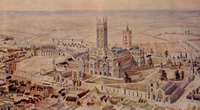
St Edmund's Abbey
|
|
blank |
"Why need I in this place extol Bury at greater length? This only will I add, that the sun does not shine on a town more prettily situated, so delicately does it hang on a gentle slope, with a little stream flowing on its east side, nor on an abbey more famous, whether we regard its endowments, its size, or its magnificence. You would aver that the Abbey was a town in itself; so many gates has it - and some of them are even of bronze - so many towers, and a church surpassed by none, under whose shadow, in the same churchyard, stand three more of the most excellent design. The streamlet, which I just now mentioned, flows through the midst of the abbey precinct, gaining access thereto by a double bridge vaulted over it."
The "little stream" does not seem to have been named the Lark until about the seventeenth century. In 1699 there was enacted "an Act for making the River Larke, alias Burn, Navigable". In 1534 it was small and shallow and could not take deep draught vessels, so only flat bottomed barges could reach the town, usually poled by men or pulled by oxen or mules.
|
|
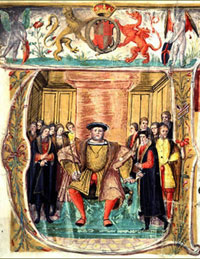
The Valor Ecclesiasticus
Symbol of the Reformation
|
|
blank |
This image is from the title page of the Valor Ecclesiasticus (Church Valuation), commissioned by Henry VIII. It assessed the value of the Abbey of St Edmund at £1,659 a year from its landholdings. It was the richest monastery in Suffolk by far, and the fifth wealthiest Benedictine House in England, after Westminster, Glastonbury, St Albans and Canterbury. In Suffolk the next richest house was Butley Priory at £318 a year, and the remainder had much less. Ixworth had just over £100 a year while Sudbury lived on £20.
Henry commissioned the Valor Ecclesiasticus so he would know how much wealth the Church had in England and Wales - and how much he could get his hands on. The information was used to decide which monasteries should be closed. It was a major demonstration of the power of the king. (The dissolution of the monasteries would start in 1536 and their assets would be appropriated to the Crown.)
In 1534, Henry VIII passed The Act of Supremacy. This act appointed himself head of the Church in England, effectively replacing the Pope. He also passed The First Fruits and Tenths Act, so that all taxes on Church income were paid to the Crown and not to the Pope. Parishes no longer paid any levy to Rome. This law gave to the crown one tenth of the net annual income of each church, together with one year's revenue from any new appointment. The year 1534 is therefore known as the first year of the Reformation of the English Church.
In 1534 the Bishop of Winchester, Stephen Gardiner, who had been born in Bury St Edmunds, was made Secretary to the King himself.
The King married his second wife, Ann Boleyn, having initiated a decisive break with the Church of Rome. They had a daughter who would become Elizabeth I, although the elder daughter Mary had precedence to the throne. The Succession Act of 1534 stated that Ann Boleyn's children would succeed as monarchs.
The Act of Supremacy changed the whole constitution of the country. Previously the Church of Rome had wielded tremendous power through its Abbots and Archbishops, who sat in Parliament as Lords Spiritual. This power was backed by the economic power represented by vast church landholdings and rentals, feudal dues, local courts, and the moral sway over the congregations. Henry VIII was announcing that from henceforward, all this power would come under his personal control.
The medieval triumvirate of King, Church and Nobility was over. The power of the nobility was eroded by a much slower process over a much longer period, but the rise of the merchants, yeoman and the middle class in general, was already well under way. It was they who ran the country at a local level, often, as at Bury, in conflict with the local abbot. When the King took away the Abbots, he would leave a local power vacuum to be filled by the gentry.
|
|
1535
|
In 1535 the Bishops were called upon to justify the King's new title of "Supreme Head of the Church of England." In reply, Bury born Stephen Gardiner, made Bishop of Winchester in 1531, published a treatise that clearly attacked the papacy. Known as the Episcopi de vera obedientia oratio ('Bishop's Speech on True Obedience'), it supported the king's supremacy as leader of the Church of England. It was regarded as the best of the vindications produced on behalf of the King.
Following the Act of Supremacy came the Treason Act, which gave the death penalty to anyone who denied the king's rights in any way or who called him heretic, schismatic or tyrant. Under this act, Sir Thomas More, Cardinal John Fisher, and eight others were executed for refusing to accept royal supremacy in religion. Clearly the religious houses were going to be a thorn in the king's side over these matters.
Thomas Cromwell was appointed the King's Vicar-General and he suggested to the King that as a quarter of England was in monastic hands this was a great source of wealth waiting to be tapped by the crown. A number of Crown Commissioners were appointed to draw up a report or comperta on the condition of the monasteries.
The King needed money to defend his realm against the Catholic Kings on the Continent. Even Scotland was catholic supporting Germany, France and Spain. Taxation was not an easy option, as he had seen in 1525, so nationalising the assets of the Catholic church would enrich his cause as well as suppress the main religious opposition.
The abbot of St Edmundsbury at this time was John Reeve, a Melford man, so he was known as John de Melford as abbot. Melford Hall had been in the Abbots' hands since before 1065, when it was given to the Abbey by Earl Aelfric, the son of Wihtgar. It had been one of the favourite country retreats of successive abbots. John Reeve had enjoyed its use since his election in 1514, and had had it rebuilt in a grand style, but in 1535 he leased the Melford Hall to Dame Frances Pennington. Perhaps it was wise at this time to demonstrate a certain modesty in the use of country estates. The lease was for 30 years, but Dame Frances also had to make available one of its largest rooms to the abbot for his annual manorial court.
In November, John ap Rice, one of Cromwell's agents, visited Bury and when they wrote to Cromwell they admitted that they could find little to the discredit of the Abbey. This report did not suit Cromwell's purposes, however. So, when the details were published for public consumption, the Comperta, or report, alleged bestiality and corruption but the allegations were almost certainly exaggerated in order to justify the confiscations which Cromwell had already planned.
|
|
1536
|
In 1536, the first complete bible to be published in English was produced, in a translation by Miles Coverdale. It was known as Coverdale's Bible, and although it was revolutionary, it was to be largely displaced in 1539 by the Great Bible. Many churchmen, such as Sir Thomas More , had been against a bible in English, as it would allow the common people to form their own opinions from the original text. But the pressure from the people, and from the new printing presses, was unstoppable. Even the King was now sympathetic to the use of English.
In a terrible irony, William Tyndale, exiled from England for publishing an English New Testament in 1526, was betrayed by Henry Phillips to the imperial authorities and seized in Antwerp in 1535. He was tried on a charge of heresy in 1536 and condemned to death, despite Thomas Cromwell's intercession on his behalf.
Sir Robert Drury died in May, 1536, and like many rich men before him, left considerable sums to the town of Bury. He was from Hawstead Place outside the town, but came from a long line of wealthy landed Drury's around Bury. Perhaps initially from Thurston, the Drury's had land all over East Anglia. This particular Sir Robert was one of the great figures of Medieval Bury, and also served as Speaker of the House of Commons, and Privy Councillor to King Henry VIII.
He was buried in St Mary's church in Bury St Edmunds. His monument stone was in the south east part of the chancel. All that remains of his inscription is as follows:
"Suche as ye be some tyme ware wee
Suche as wee are suche schall ye be".
Sir Robert Drury was succeeded by his son, William Drury, who was knighted a few days after his father's death. Sir William Drury became Sheriff of Norfolk and Suffolk for 1536-1537.
The King now started to Reform his newly acquired Church. In July 1536 the Ten Articles were issued at his request, known as The First Royal Injunction. Much of this was Lutheran in origin.
Ann Boleyn was executed and the marriage annulled. In the process Elizabeth was declared illegitimate. Jane Seymour was the King's third wife and gave birth to Prince Edward who became Edward VI in 1547.
The Dissolution of the Monasteries really began when the Act of Suppression authorised the closure of monasteries with an annual income of less than 300 marks (about £200). This Act began to be enforced in 1536. It covered 300 houses but about 75 were exempted upon payment of a fine. At Bury the monks thought it expedient to grant Cromwell and his son Gregory an annuity of £10 payable from the rents at Harlow.
In Bury this order did not cover the great Benedictine Abbey, but it did cause the Babwell Friary of the Franciscan Order to be shut down.
The Court of Augmentations was set up to control and administer the former monastic lands on behalf of the Crown. It also arranged and supervised any land sales and leases necessary. This court ended up with the first great privatisation of state assets, as Henry VIII dissolved all religious houses in the years to 1540. To make a quick return the King authorised a few sales or "grants" to anyone able to pay the price. There were only a trickle of sales up to 1540. The property of the Babwell Friary was sold to Anthony Harveye, a gentleman.
In addition to closures, the number of Holy days was reduced from 90 to 30 a year, effectively adding two months to the working year.
The loss of the monasteries brought resentment, resistance and serious economic changes as they served their communities with medical aid, alms for the poor, accommodation for poor travellers and the sick as well as their religious needs. There were uprisings in Lincolnshire and Yorkshire, as well as more peaceful protests such as the Pilgrimage of Grace, based at York.
Suffolk's clothing towns were also once again seething with discontent. As well as the religious issues, an Act was passed to fix the breadth of ordinary lower quality cloth, which had been largely unregulated hitherto. The clothiers and their workmen bitterly resented this interference with what was already becoming a precarious living. It was feared that they might join the northern rebellions. The Duke of Norfolk again called upon John Spring and Thomas Jermyn, who had helped him in the troubles of 1525-26. Anyone speaking "an unfitting word", was to be immediately brought before the Duke. He recruited 1,500 tall men out of Suffolk to be ready to resist any trouble, and he wrote that if the Earl of Oxford could make sure of his town of Lavenham, then the whole of south-west Suffolk would be safe. This approach seems to have been successful.
In the Autumn of 1536, the Sheriff of Norfolk and Suffolk, Sir William Drury, his brother, Sir Robert Drury, and Thomas Howard, 3rd Duke of Norfolk, were dispatched to the north to help quell the rebellions known as the Pilgrimage of Grace. Large numbers gathered in Durham, Yorkshire and Lincolnshire. Although the risings were dealt with by agreement, rather than by violence, many of the ringleaders were later executed.
|
|
1537
|
Rumours abounded that the larger monasteries were also to be suppressed. There now remained about 250 monastic houses, and Cromwell tried to persuade many of them to make a voluntary surrender. Ixworth Priory closed in 1537.
In a very few cases former monastic lands were given to the king's favourites. Gifts went to the Duke of Norfolk for suppressing the Pilgrimage of Grace in 1536/37, and to the King's brother in law, Henry Brandon, Duke of Suffolk. But in most cases the lands were sold, even though they are described as Grants.
In 1537 Nicholas Bacon of Drinkstone became the Solicitor to the newly appointed Court of Augmentations. He held this post until 1546, and as the younger son of a Suffolk Yeoman, he must have started with little more than a good education. Office holders in these days were expected to become wealthy from the proceeds of office, and Bacon was no exception. He managed to buy seven monastic manors in Suffolk during this period, and then could build the great Redgrave Hall.
|
|
1538
|
Cromwell wrote to the heads of all religious houses to assure them no compulsory proposals were contemplated, but at the same time he sent Inspectors or Visitors to use threats, coercion, or promise deals in order to get deeds of "voluntary" surrender agreed. It is recorded that the houses at Sudbury, Clare, Babwell and Welnetham all closed in 1538.
In September 1538 the Kings Commissioners arrived at Bury Abbey to confiscate its wealth. Their official report to Lord Cromwell reads as follows:- "Pleasyth it youre Lordship to be advertised that we have been at Saynt Edmondsbury, where we found a riche shryne, which was very comberous to deface. We have taken in the seyd monastery in golde and sylver 5000 markes and above. Besyds as well a riche crosse with emeredds as also dyvers and sundry stones of grete value; and yet we have left the churche, abbott and convent very well furneshed with plate of sylver necessary for the same. And we assure your Lordship the abbot and convent be very well contented with everything that we have done there, as knoweth God, who preserve your Lordshipp. Your Lordshipe most bounden, John Williams Richard Pollard Phylyp Parys John Smyth"
In November 1538 the King's agent Richard Ingworth arrived at Clare to receive the surrender of Clare Priory from the Austin Friars. The friars were pensioned off like many other houses, and that was that, except that in this case, the Augustine Order would return to the same spot in 1953.
At Sudbury, the College for priests on the site of Walnut Tree Hospital, was closed down. It had been founded by Simon Of Sudbury, in 1375, when he became Archbishop of Canterbury. Simon is notable for having been killed in the Peasants Revolt of 1381, and his skull returned to St Gregory's Church in Sudbury, where it can still be seen on request.
During 1538 the Second Royal Injunction reflected Lutheran protestant ideas by forbidding placing candles before images and other superstitious practices. English bibles were now officially encouraged. The clergy were told to teach the Lords Prayer, the Creed and the Ten Commandments in English. Every parson had to provide an English Bible in his church with free access to anyone who wished to read it.
One result of these injunctions would be of benefit to family historians. Every parish was instructed to purchase a "sure coffer" for the safe keeping of the records of parish marriages, christenings and burials. This was the Parish Chest, which is still to be seen in churches like St Andrews in Barningham. Thus some parishes do still retain records dating back to this time, but many have been lost by decay, damp, vermin, fire or flood over the 450 years since then.
Charles Brandon, the Duke of Suffolk was an enthusiastic Protestant. He did much to protect and encourage the Protestant clergy in Suffolk. However, it seems that the King took back the Honour of Eye in 1538, and Brandon lost control of his Suffolk holdings.
|
|
1539
|
In April 1539 the Great Bible was published in English. The Church was being reformed, while its possessions were being seized. However, in June 1539 Henry issued his Act of Six Articles which drew the line at some Protestant ideas, and reasserted some Catholic articles of faith. From now on Henry VIII would support little further Protestantisation of his Church. One of the architects of the Six Articles was Bishop Stephen Gardiner who now seemed to be reverting to Catholic ideals. The Six Articles led to the resignation of Bishops Latimer and Shaxton and the persecution of the Protestant party. These laws, also known as the Bloody Statute, have sometimes been attributed solely to Gardiner, who was born in Bury St Edmunds, and educated at Cambridge. The penalty for denying the divinity of Jesus was to be burnt at the stake, and the other articles had similar penalties.
Another Act of Suppression sanctioned the transfer of further monastic possessions to the state, but by this time Cromwell had almost completed his confiscations either with, or without, the sanction of the law.
Surrendered monastic properties were leased or sold to supporters of the Crown, but there was considerable pilfering and embezzlement along the way so that only about one-fifth of the proceeds were estimated to reach royal coffers. The main convent churches and monastic buildings were destroyed in order to preclude any return by the monks. Gold and silver works of art were melted down. Carved wooden screens and stalls were used to make fires to melt down the lead taken from roofs. Books, deeds, manuscripts and documents were burnt or thrown away, if not deemed valuable enough to be sold.
|
|
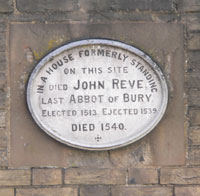
Plaque in Crown Street |
|
blank |
The property of the Abbey of St Edmund was surrendered to the Crown on 4th November 1539 but much of the wealth had already been confiscated in the previous year. The Deed of Surrender was signed by Abbot Reeve, Prior Denysse of Ryngstede and forty-one monks. The Abbot was given a pension of £333, a tremendous sum, and a house in Crown Street, now incorporated into the Greene King Brewery. It seems that 44 of the 60 monks still on the establishment were also pensioned by the crown. Many may have been sick or recently died as the plague had also broken out again in the abbey.
The bailiffs and other officials, seem to have carried on collecting all the old dues and tolls, but paid them over to the Crown.
The body of Mary Tudor was removed from the great Abbey Church and placed in St Mary's Church as the Abbey Church was to be stripped.
Only a few months after the last monastery had been closed down, Thomas Cromwell was beheaded without trial on 28th June 1540, mainly for his part in persuading the King to marry Ann of Cleves.
Approximately 820 religious houses were closed down, and about a third of these have completely disappeared today. One third exist as scanty remains. There were enormous social consequences arising from this massive change in ownership and work patterns, with the poor in particular suffering from the loss of the vital social security and health systems provided by the monasteries. In 1547, Henry VIII would die and be succeeded by Edward VI.
The Dissolution of the Monasteries was the major physical event of the English Reformation, but the process of Reformation would continue in following years, and under other monarchs, having much greater intrusions into the lives and habits of every person in the land.
|
|
Quick links on this page
Top of Page 1216
Mabilla of Bury 1230
Franciscans- Friars Lane 1238
Franciscans in danger 1257
Guild of Youth riots 1264
Abbey gets Haberden 1281
Town gets Alderman 1292
Shire Court moves North 1301
The Great Famine 1315
Abbey Gate destroyed 1327
The Black Death 1348
The Peasants Revolt 1381
St Mary's Tower 1400
John of Lydgate 1420
Duke of Gloucester dies 1447
Great abbey fire 1465
Feoffees' beginnings 1472
Rushbrooke Hall started 1500
Martin Luther's Protests 1517
Henry VIII Head of Church 1535
|
1539 onwards
Please click here to follow this story after the dissolution of the monasteries.
Prepared for the St Edmundsbury Local History Project
by David Addy
Books consulted:
The History and Antiquities of Hawstead, by Sir John Cullum, 1813 revised edition
John Gage "The History of Thingoe Hundred", written in 1838
The Rising in East Anglia in 1381 by Edgar Powell, 1896
The Great Revolt of 1381 by Sir Charles Oman, 1906, reprinted 1989
A Suffolk Hundred in 1283 by Edgar Powell, 1910
SIAH Volume 20, part 2, (1920), article entitled " NONARUM- INQUISITIONES " FOR SUFFOLK. BY THE REV. W. A. WICKHAM
"Suffolk" by Lilian Redstone, 1930
“The Borough of Bury St Edmunds”, by M D Lobel, Clarendon Press, published 1935.
Depden: Church and Village by H J Woollard, 1981
David Dymond and John Northeast - A History of Suffolk
English Medieval Monasteries 1066-1539
The Book of Bury St Edmunds
by Margaret Statham.
Yesterdays Town - Bury St Edmunds by Margaret Statham
Jankyn Smyth and the Guildhall Feoffees by Margaret Statham
The Chronicle of Bury St Edmunds, 1212 - 1301, edited by Antonia Gransden
"A Short History of Glemsford" by Rev Kenneth W. Glass 1962 available at Foxearth and District Local History Society
The Letter Book of William of Hoo, 1280 - 1294, edited by Antonia Gransden for SRS 1963
The Borough of Bury St Edmund's by M D Lobel, 1935
"Bells and Bellringing in Suffolk", by R W M Clouston and G J W Pipe, 1980
Bury St Edmunds and the Urban Crisis 1290 - 1539 by Robert S Gottfried, 1982
Lavenham - Industrial Town by A Betterton and D Dymond, Second edition 1989
Tudor and Stuart Suffolk by Gordon Blackwood, 2001
Around Bury St Edmunds by Robert Halliday, 2004
Biography of Stephen Gardiner in Wikipedia, the online Encyclopedia.
Mark Bailey : "Medieval Suffolk", published in 2007
"From Wool to Cloth - the Triumph of the Suffolk Clothier." Nick Amor, 2016
Philip Slavin : "Experiencing Famine in 14th Century Britain" published in 2019
WEBSITES
Little Saxham Online website, www.little-saxham.gov.uk
Tostock On-Line website: www.tostock.suffolk.gov.uk/church.htm
Edward I legislation from University of Iowa
|















































































